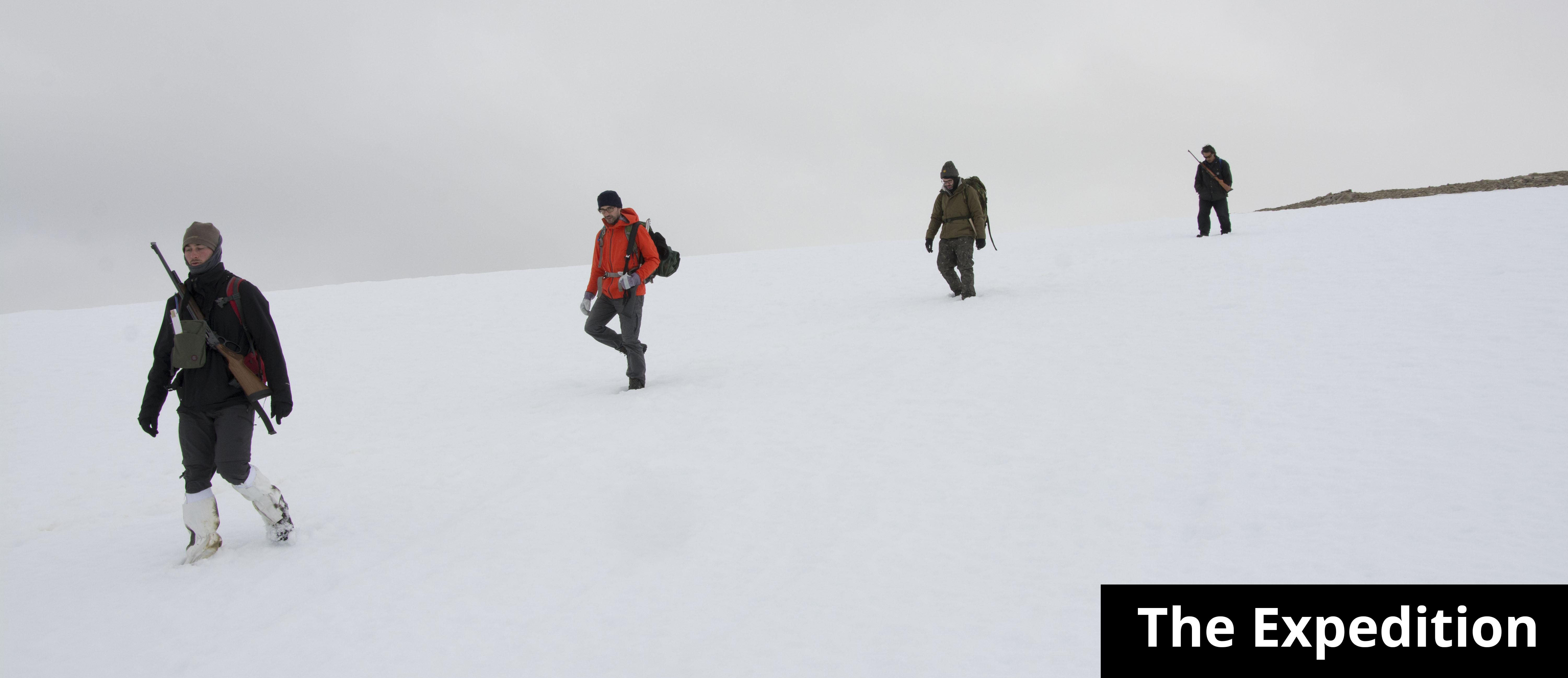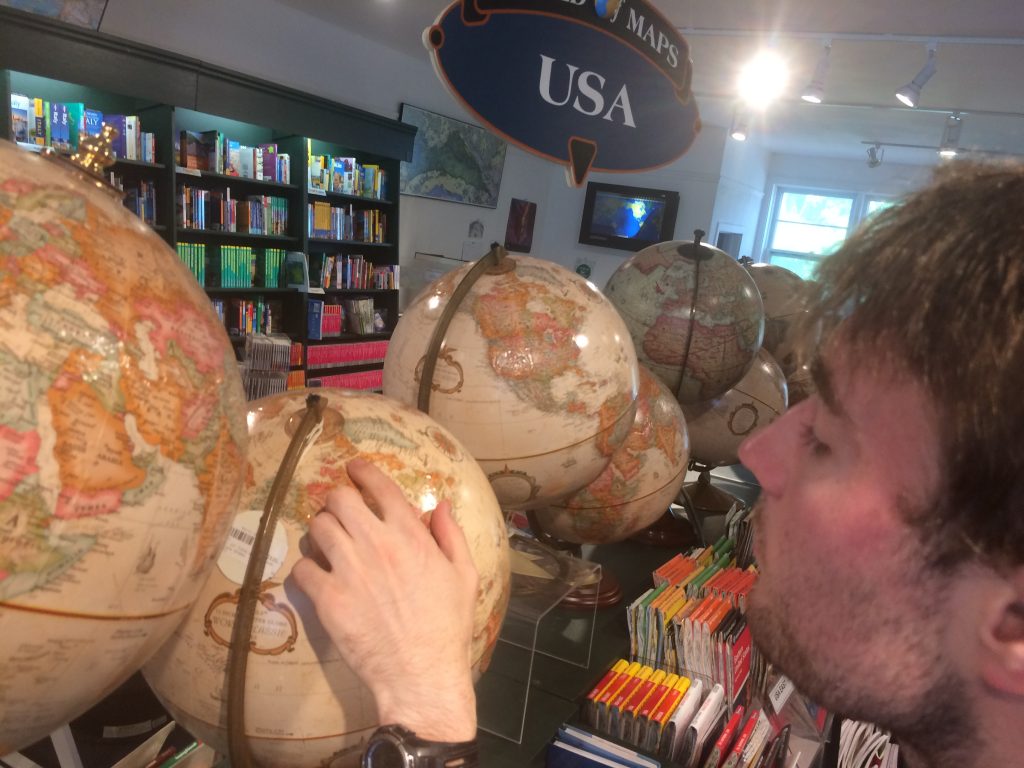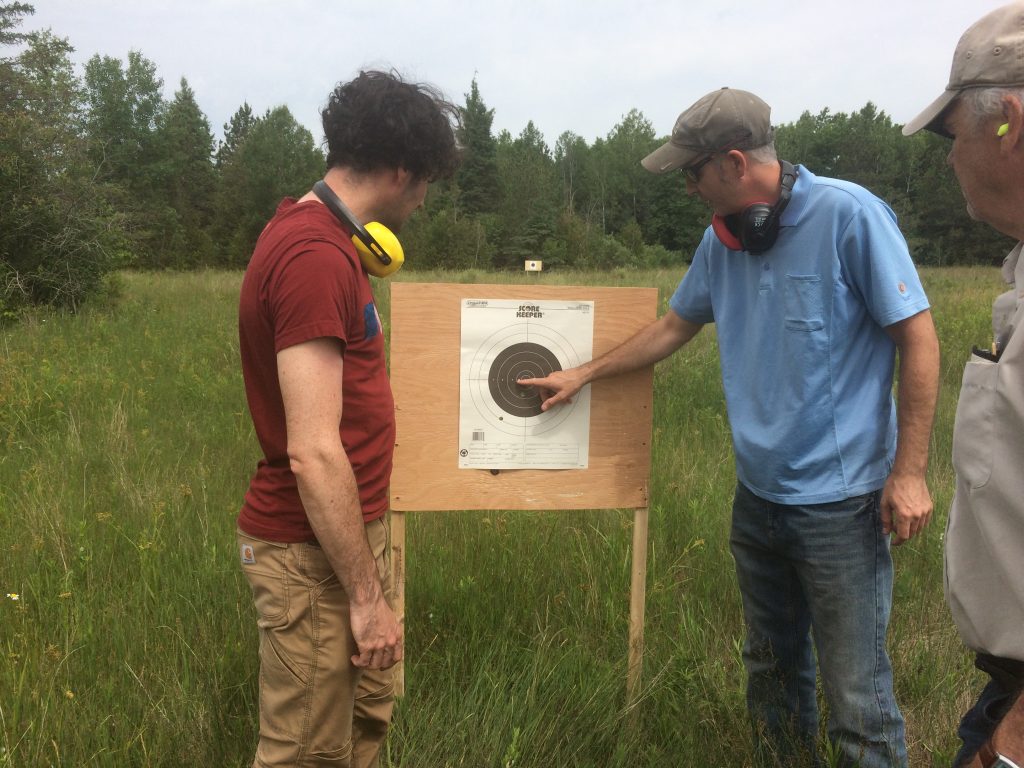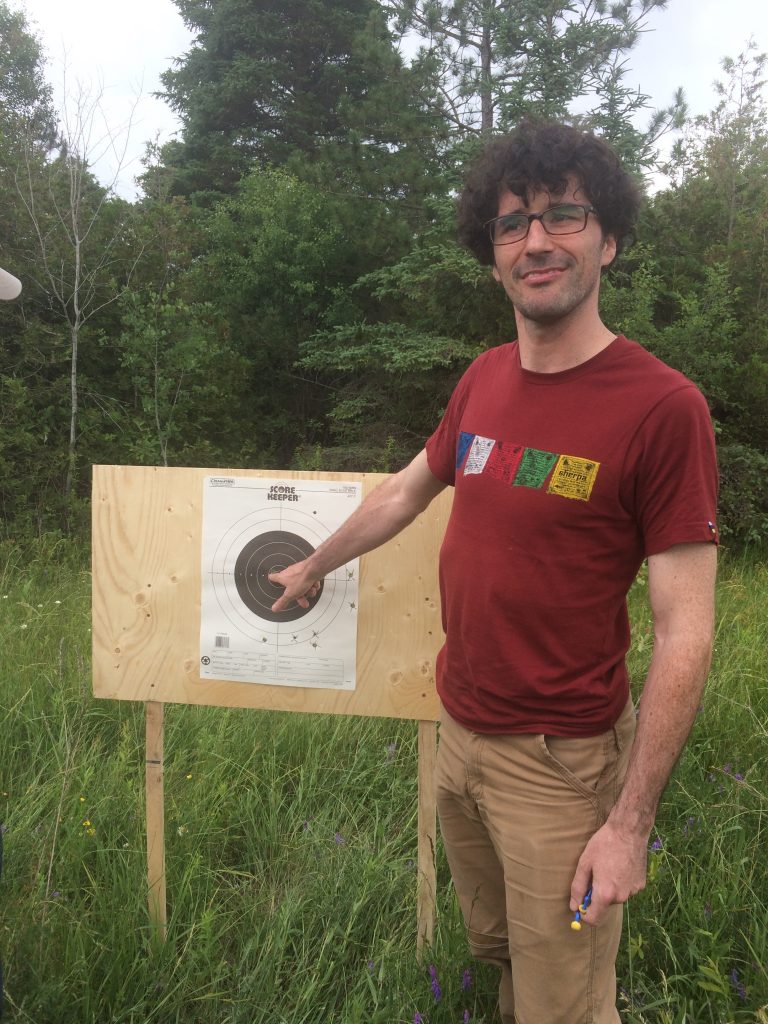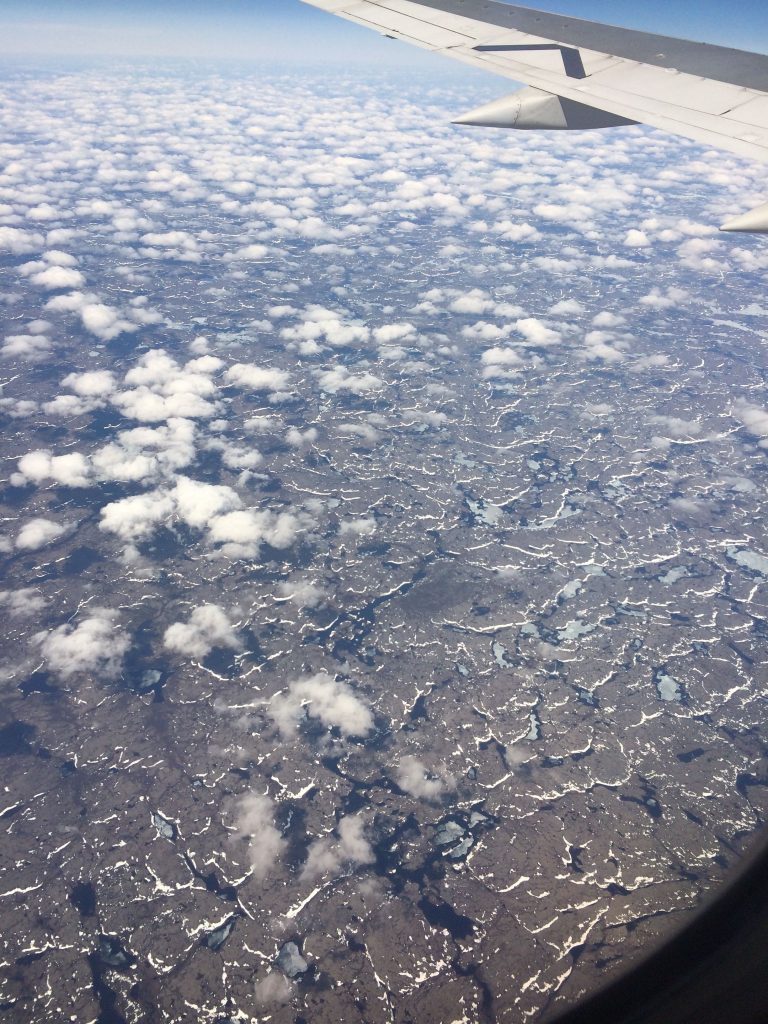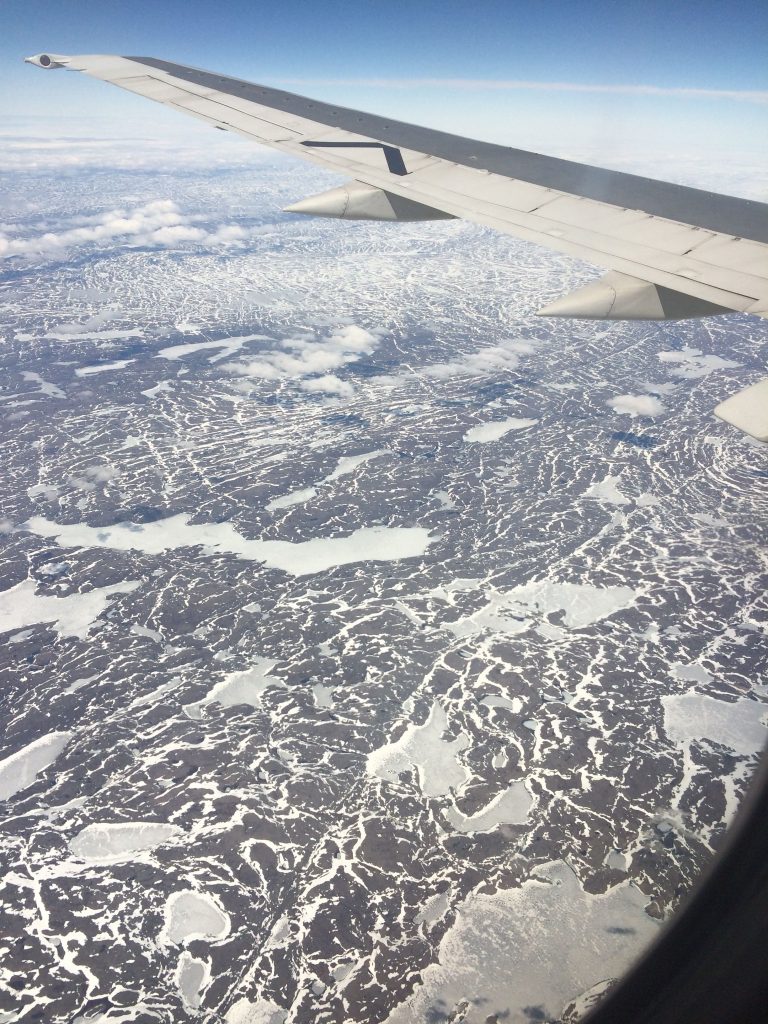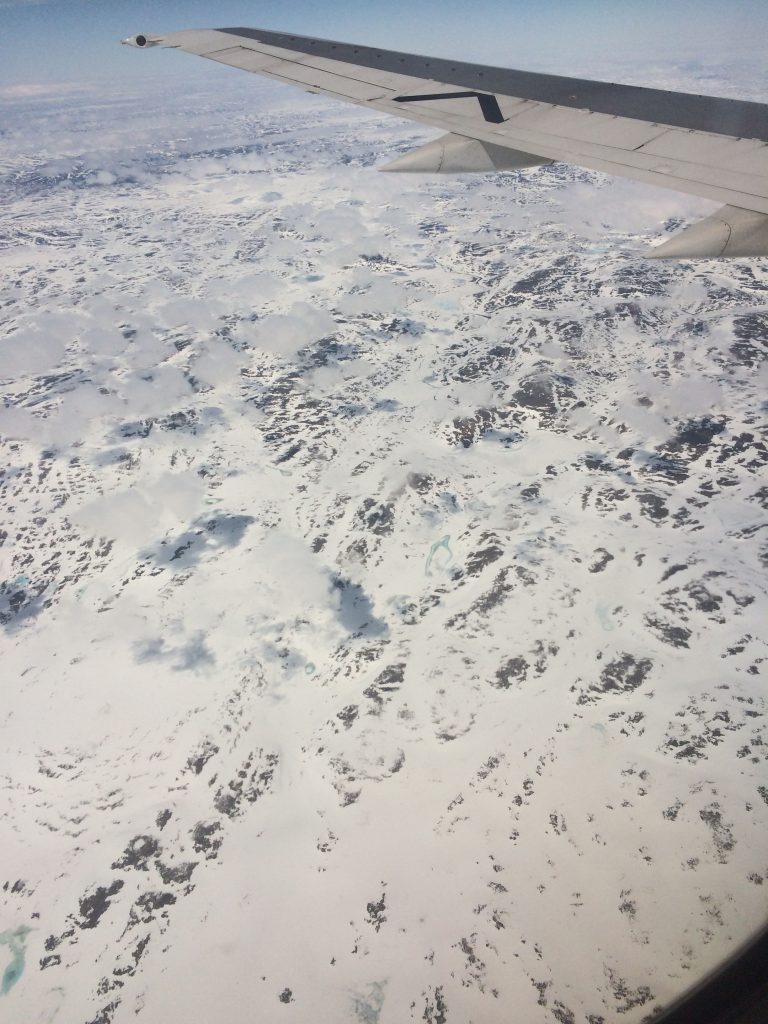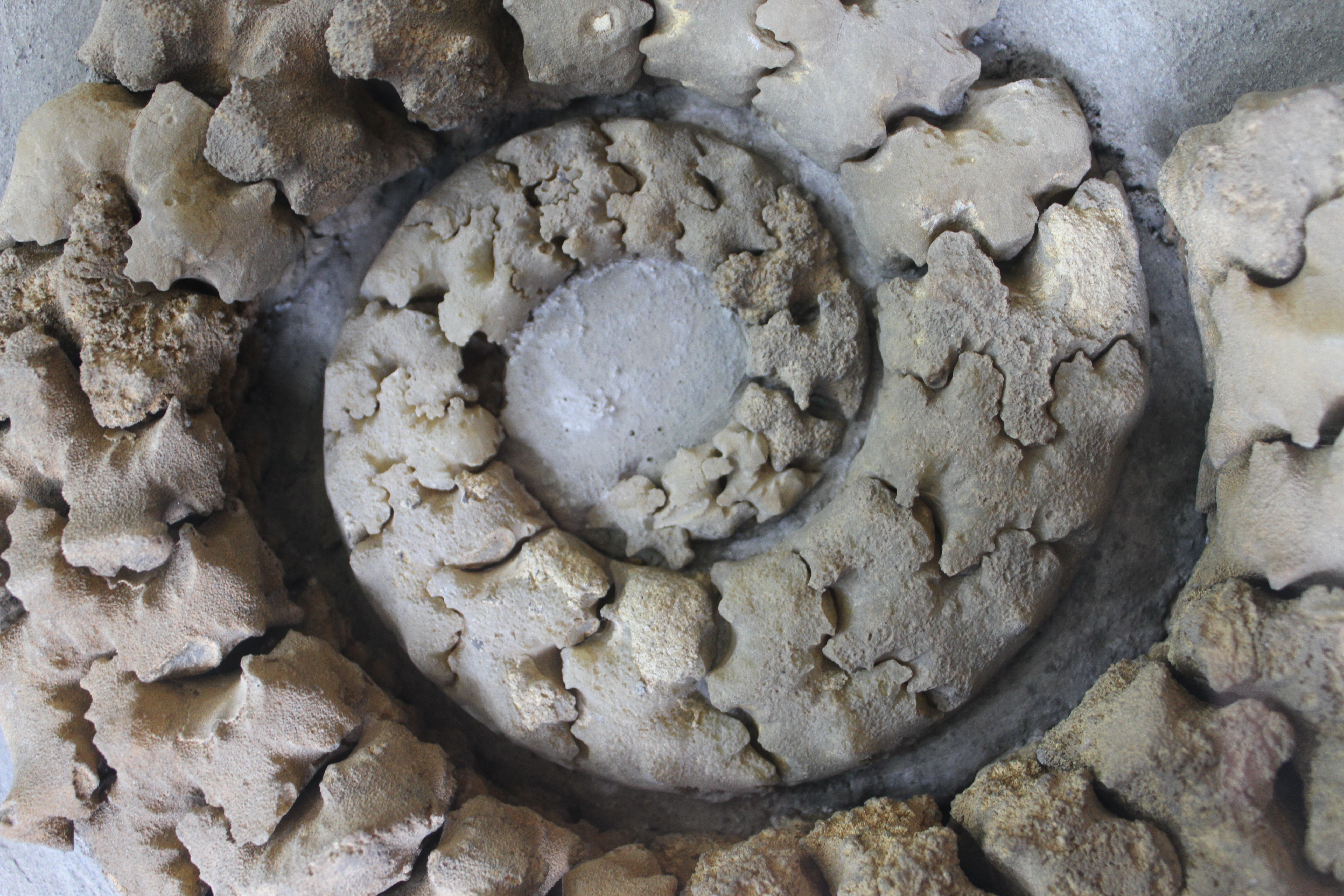The Expedition
Welcome to this special series of podcasts relating to a fieldtrip that I have been invited on by Dr Martin Brazeau of Imperial College London.
I’m being flown out as the Palaeozoic arthropod “expert” of the team and I’ll be there to deal with all the eurypterids and phyllocaridids we come across, along as documenting the whole process for outreach and hopefully your enjoyment.
In all, this trip will last around 6 weeks, during which time we’ll have no internet, electricity, running water or even any toilets. It’s going to be a gruelling trip, but hopefully one that will give you an insight into what life is like in the field. You will join us as we discuss the science, prepare for the trip, arrive in the field, go out digging and finally wrap things up. You will experience all the highs of discovering new and exciting fossils and the lows of when we’ve just all had enough. This expedition is a unique opportunity to share with you a single research project from start to finish, rather than just the results.
Context
In this first episode, we contextualise why we’re going into the field. What is the current lay of the research landscape? What we already know? and what are we aiming to find out about the early evolution of the jawed vertebrates, a group to which we ourselves belong?
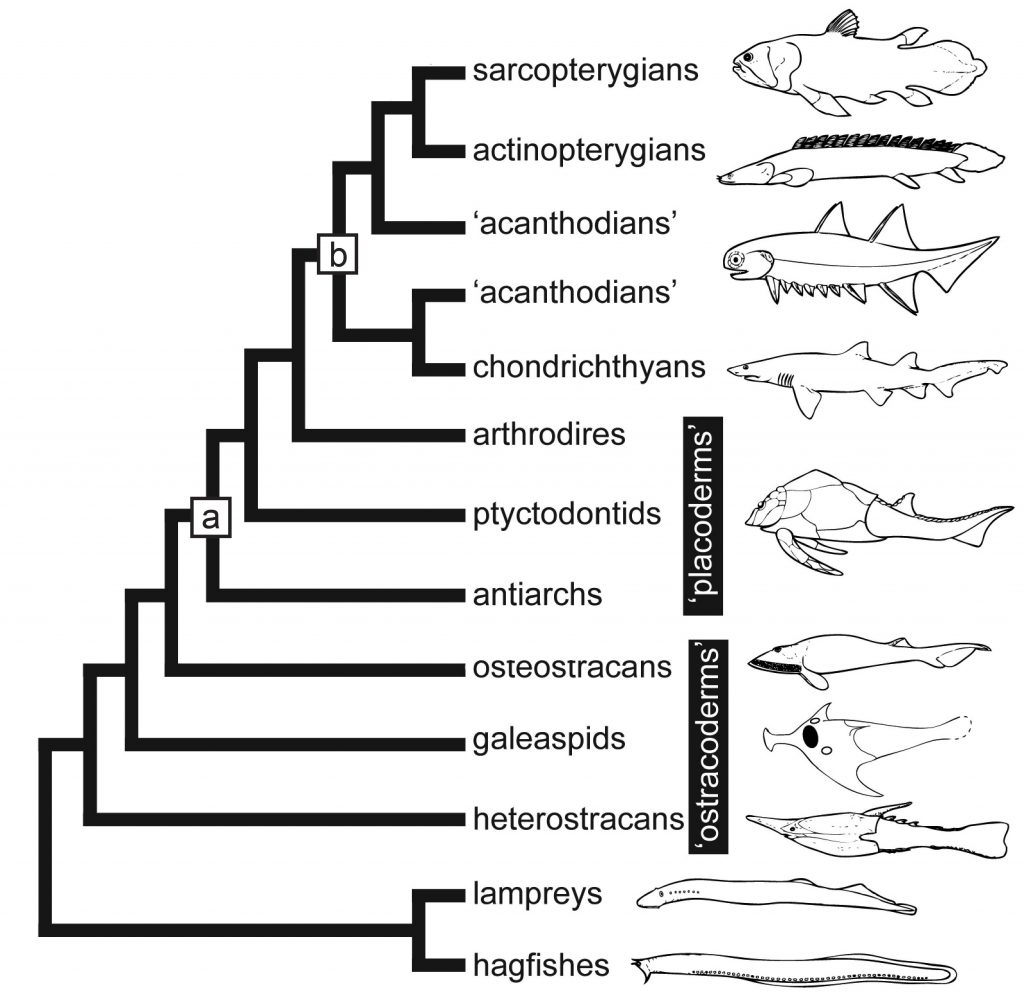
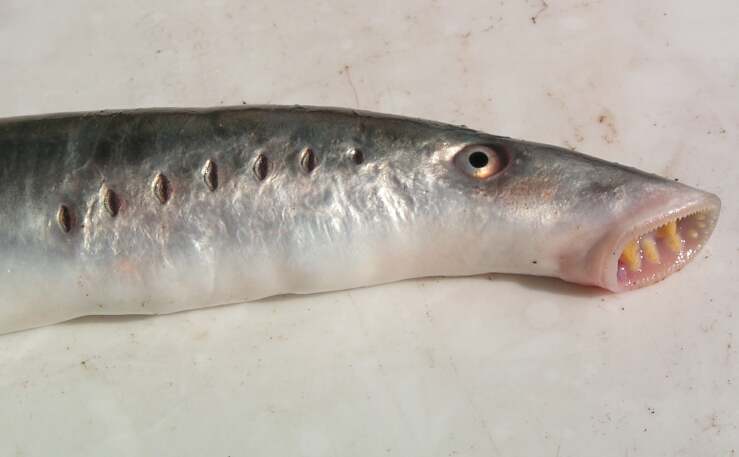
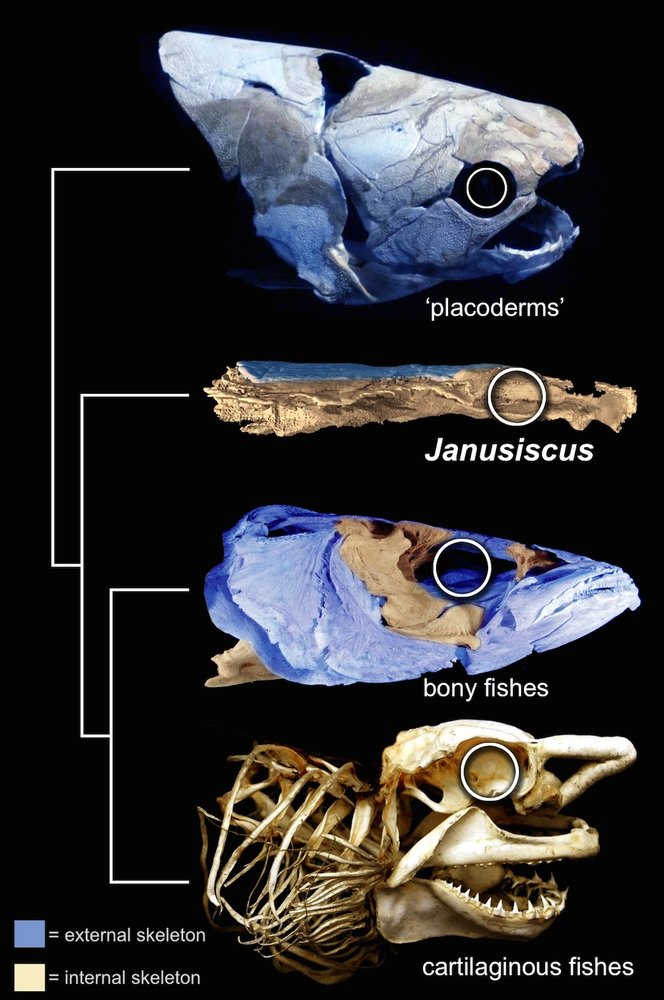
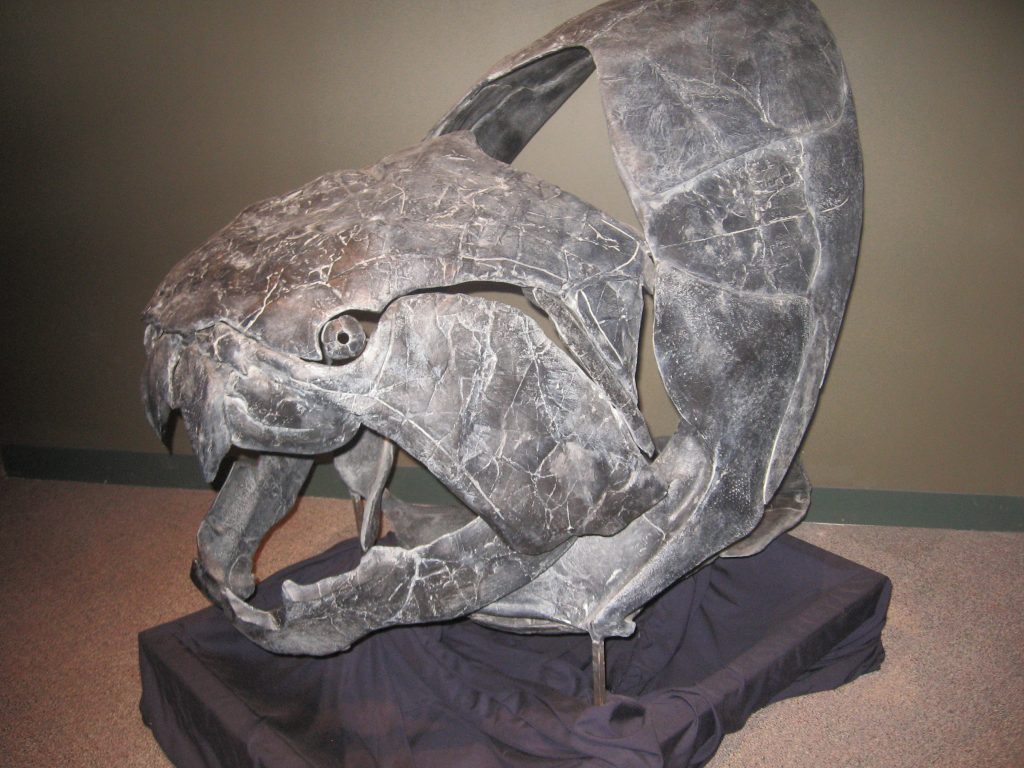
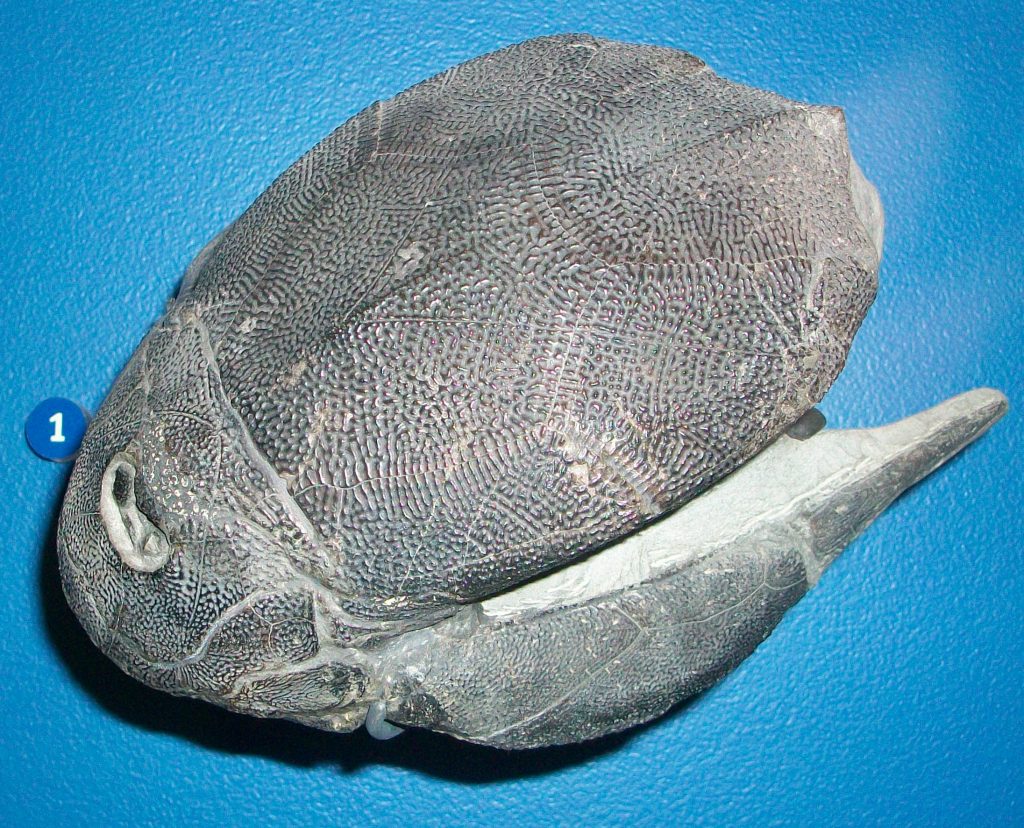
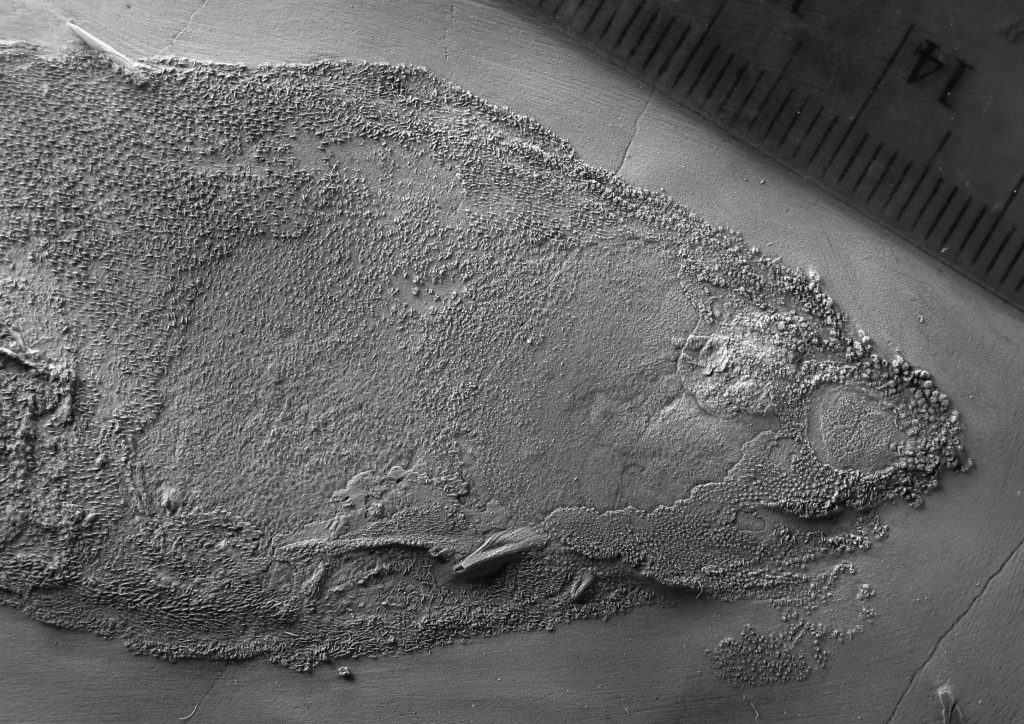
As well as looking for jawed vertebrates we are also on the hunt for ostracoderms, which are boney, jawless fishes. As their name suggests they lacked the classic vertebrate feature of a jaw and many other diagnostic characteristics, such as paired fins and a boney internal skeleton. Instead, many of the different ostracoderm groups had a boney ‘dermoskeleton’ which encased their bodies from the outside. They are really important for understanding the assembly of the early vertebrate skeleton and were the dominant fishes in early vertebrate faunas (Silurian to early Devonian).
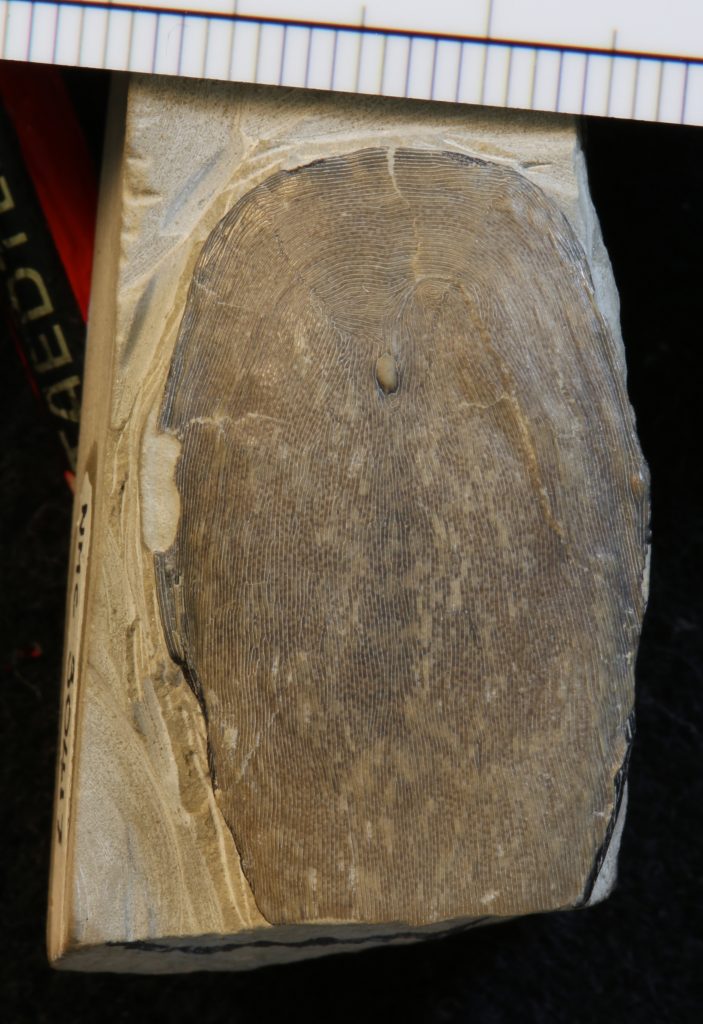
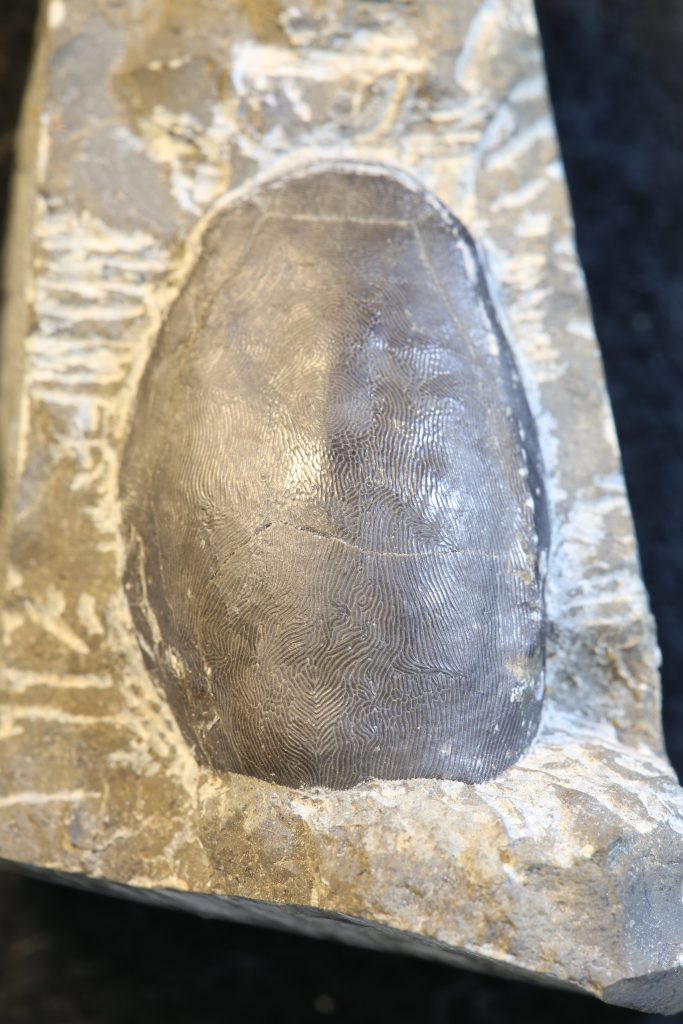
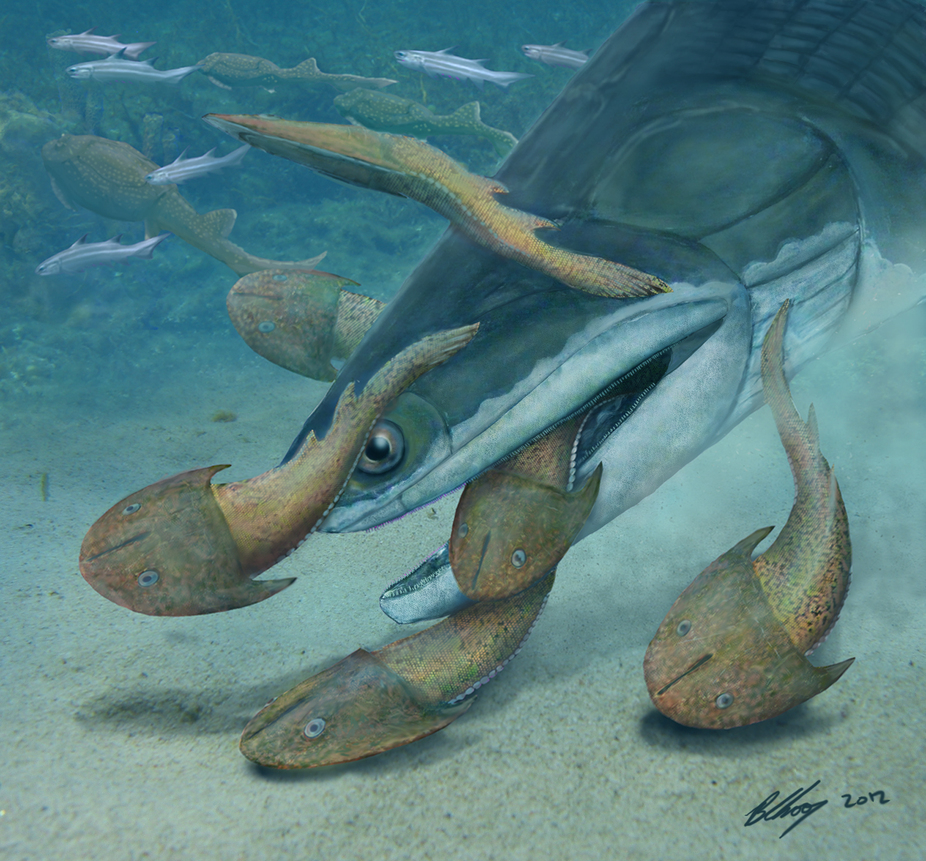
Logistics
We now move on to discussing the logistics of the trip. How do you go about making this kind of expedition happen? What are some of the challenges we will face? What will life be like in the camp? and how will we get our priceless fossils home?
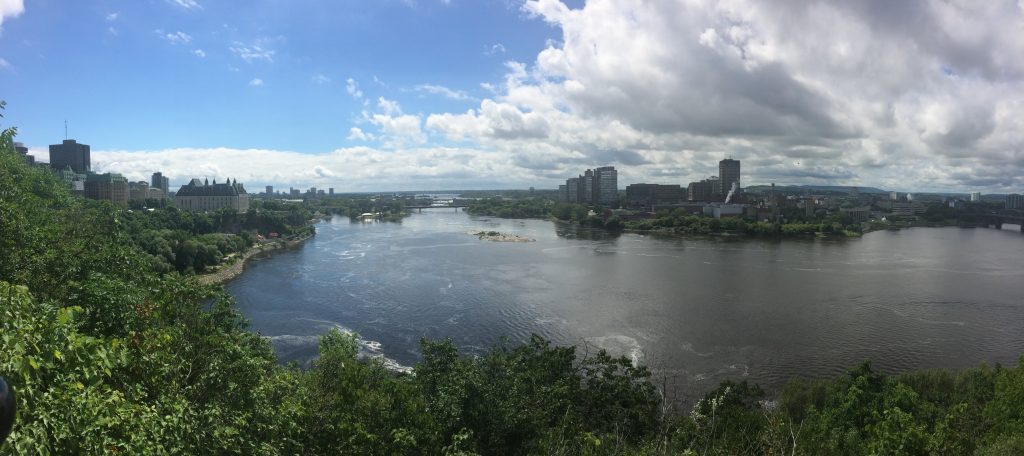
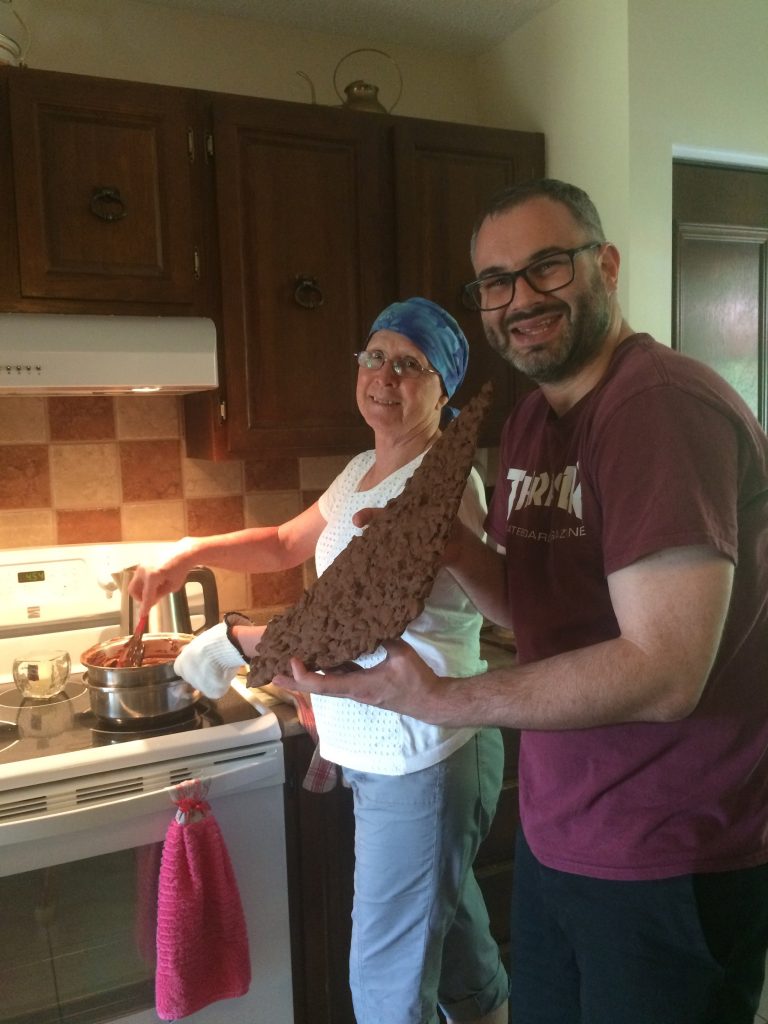
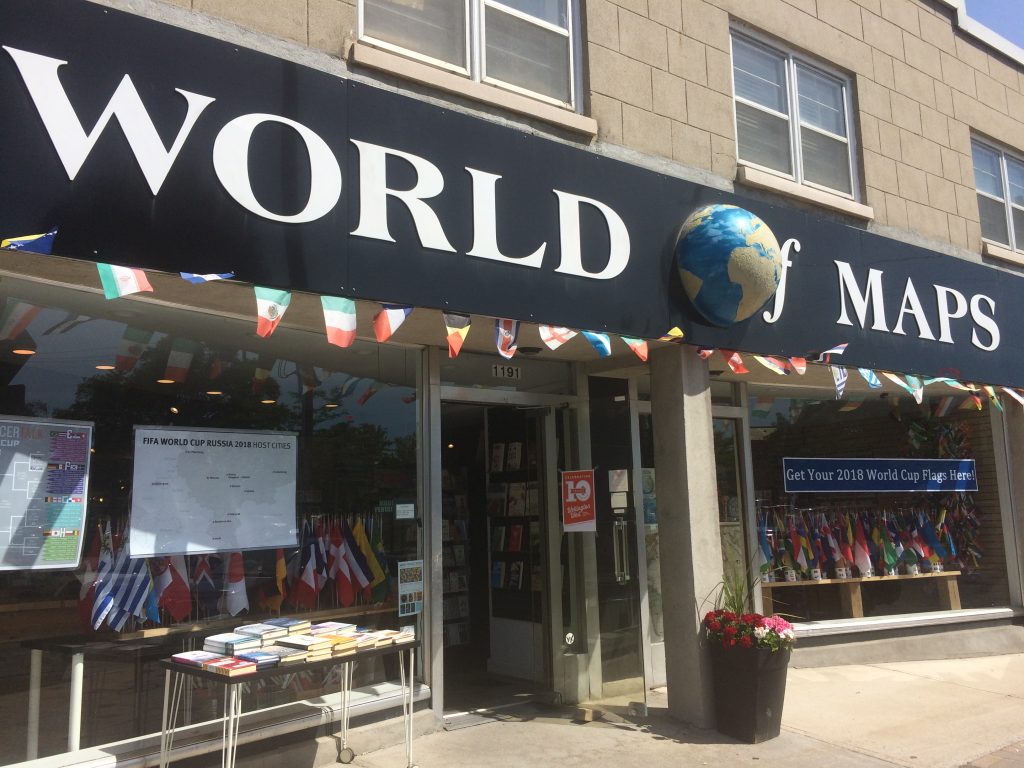
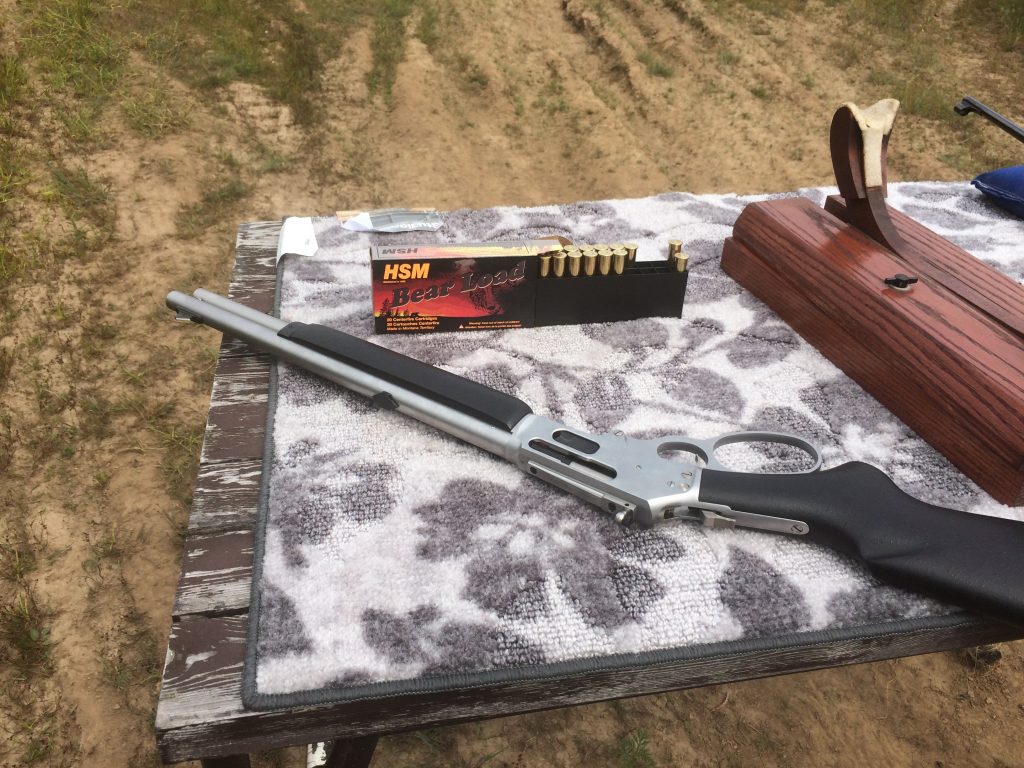
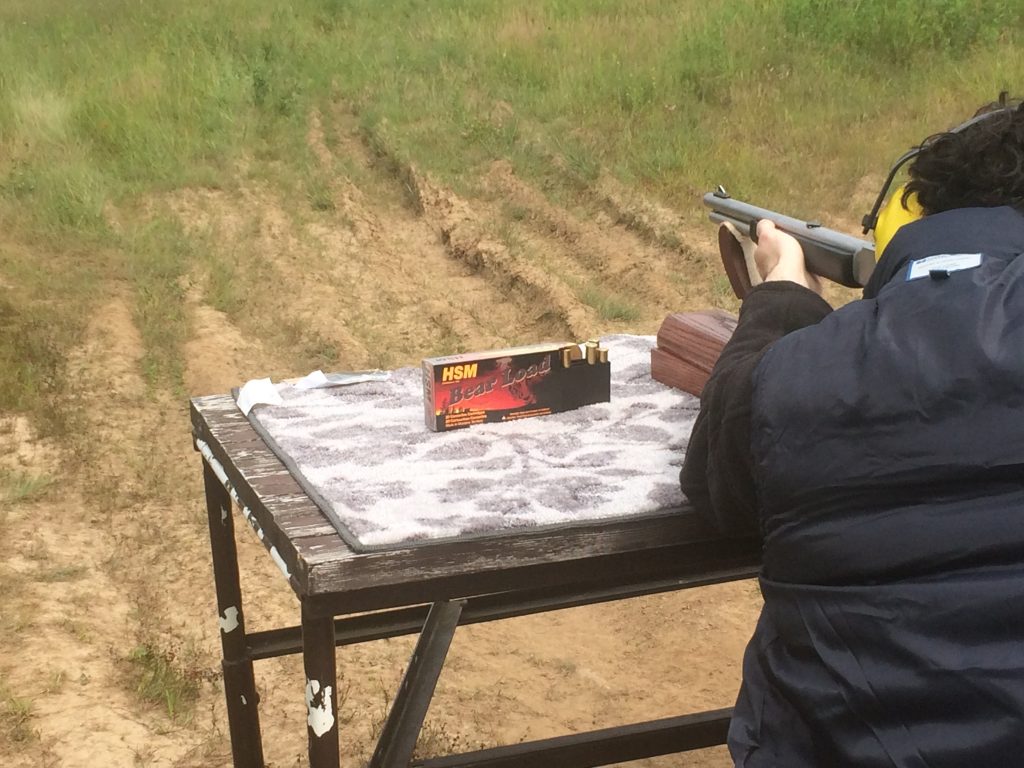
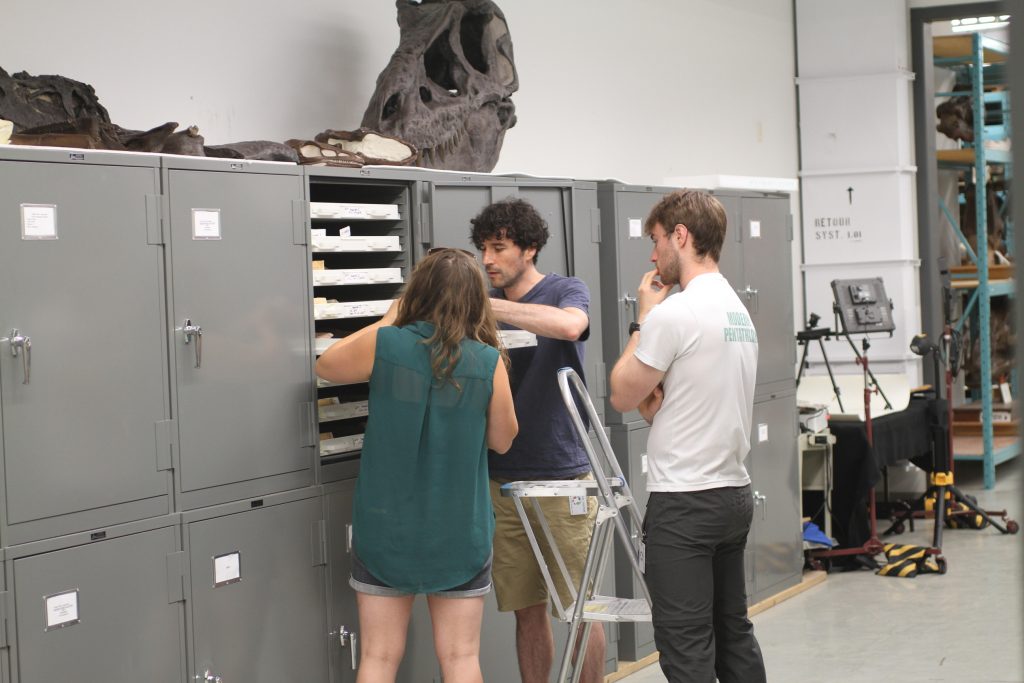
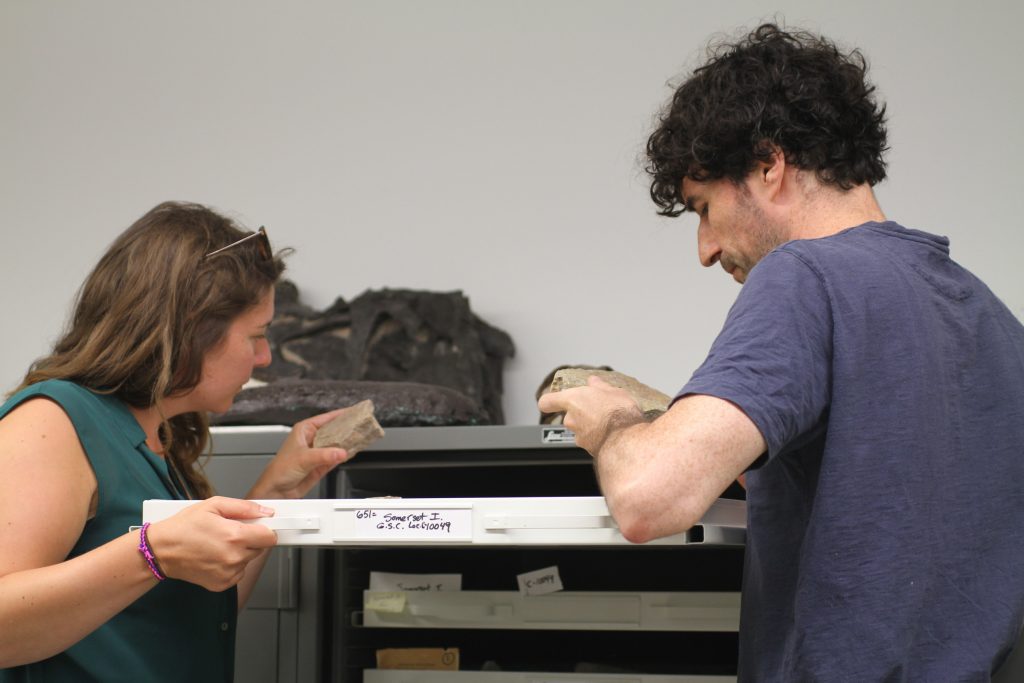
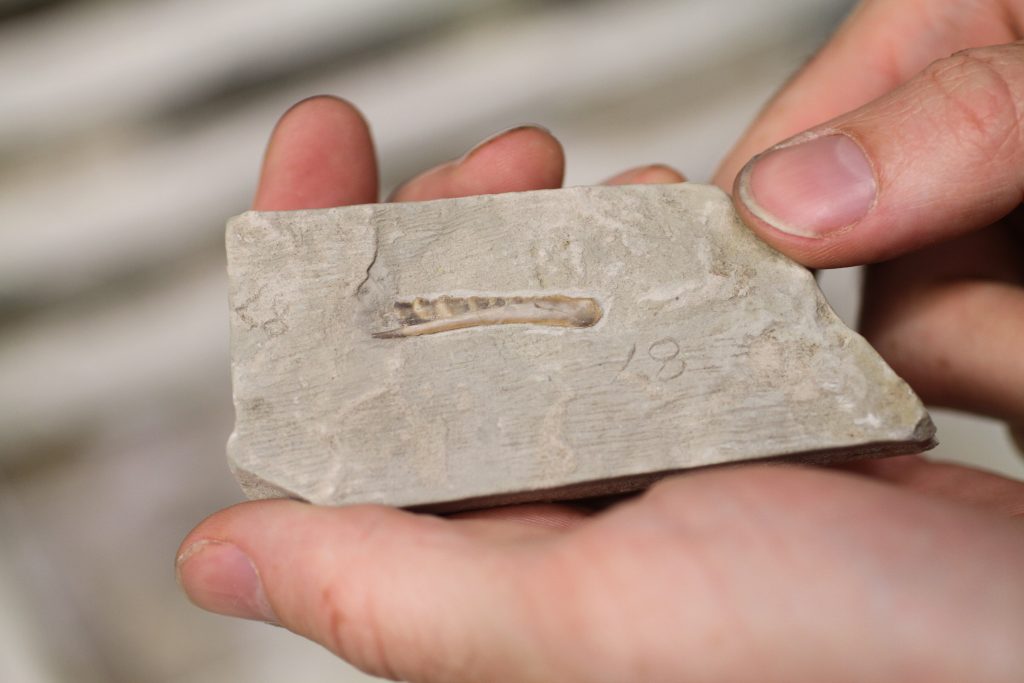
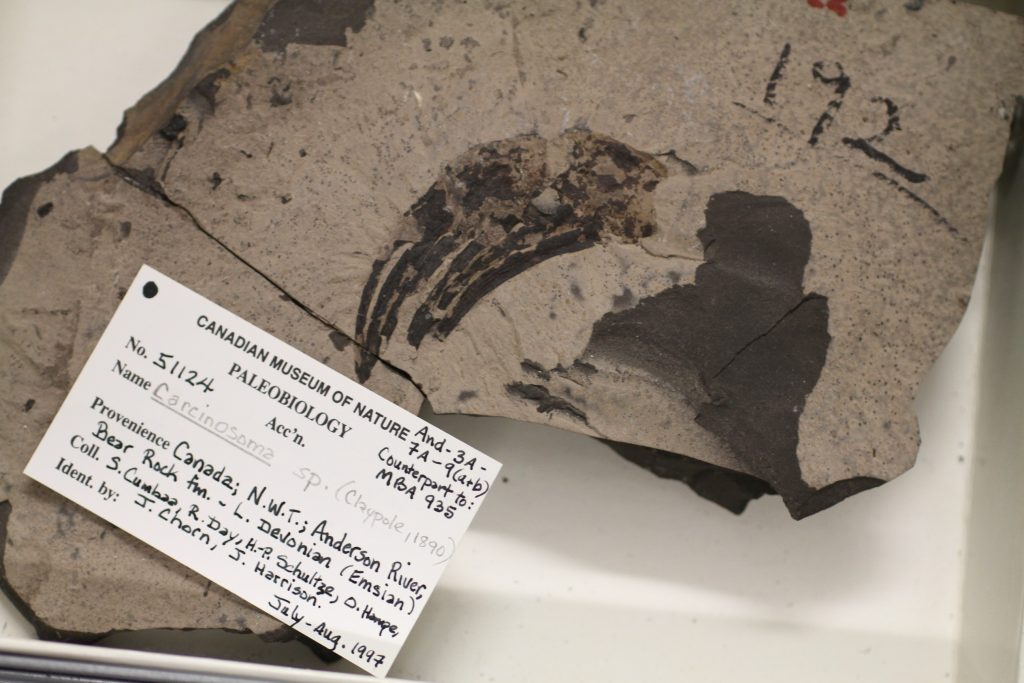
A little on our home for the next few weeks: Cornwallis Island.
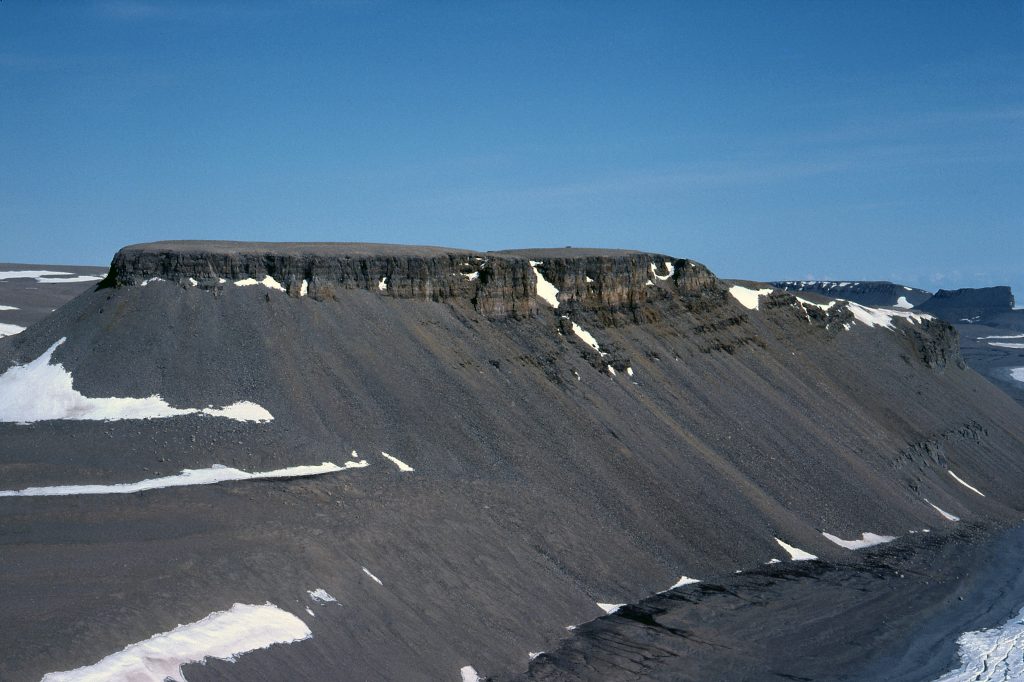
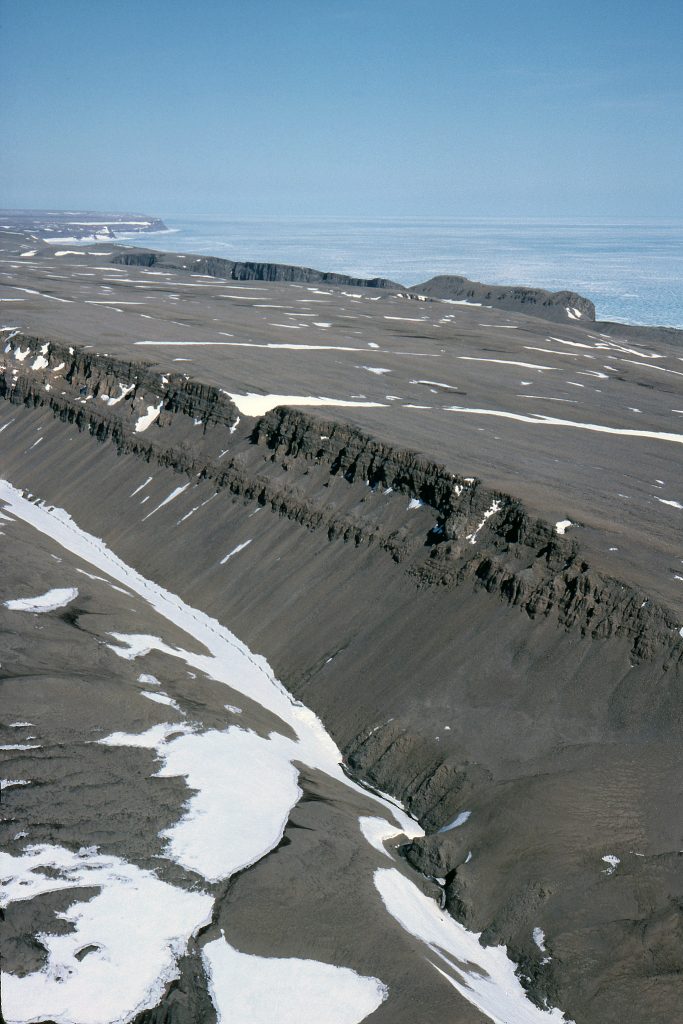
Access into the field is only feasible by air, given the amount of equipment we are to be carrying. Aircraft capable of landing in the field are helicopters and the Twin Otter plane.
Getting to Cornwallis Island
Ahead of our trip we, we had one months worth of food shipped up to the research station on Cornwallis Island. This meant we only had our personal equipment, rifles and bear fences to ferry to the Arctic. We were fortunate to have pretty good access to the airport and were able to take our considerable amount of equipment in a couple of short trips. The flights to the Arctic had multiple stops and we hopped between airports and islands all the way up to Cornwallis Island. All in all, it too around ?12 hours to get from Ottawa to our destination in Resolute. We were in a fairly small plane that was probably older than any one of us, so there wasn’t any in-flight entertainment, so it provided the perfect time to read a lot of the literature, to film out of the window and to do so airborne geological tourism.
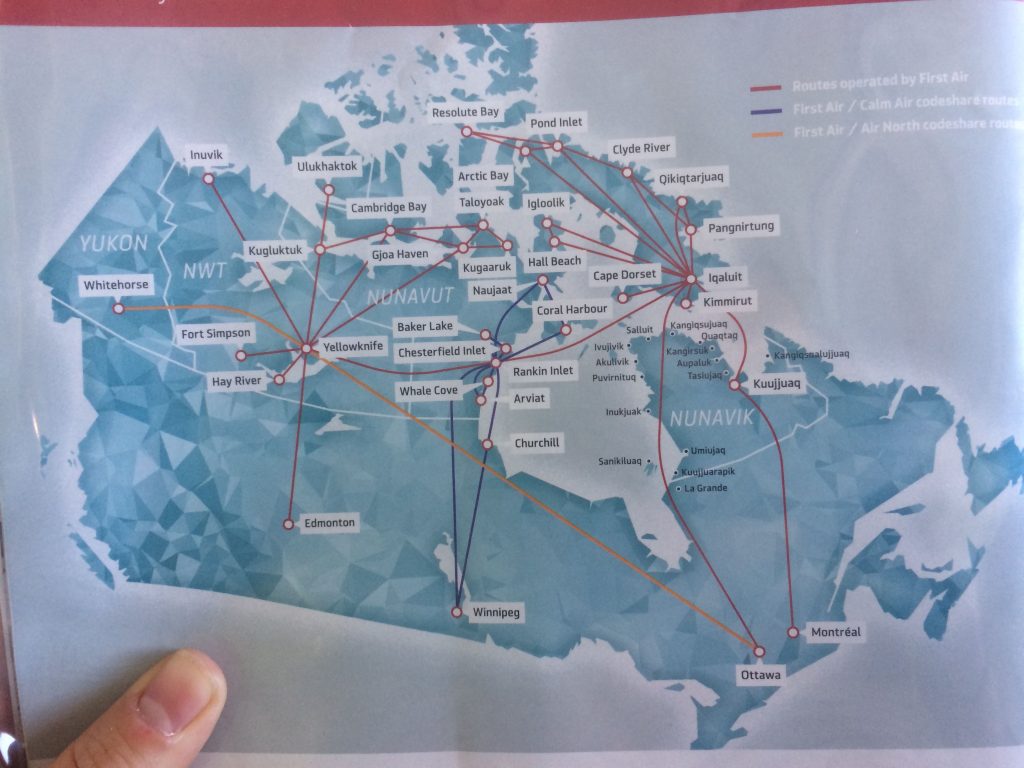
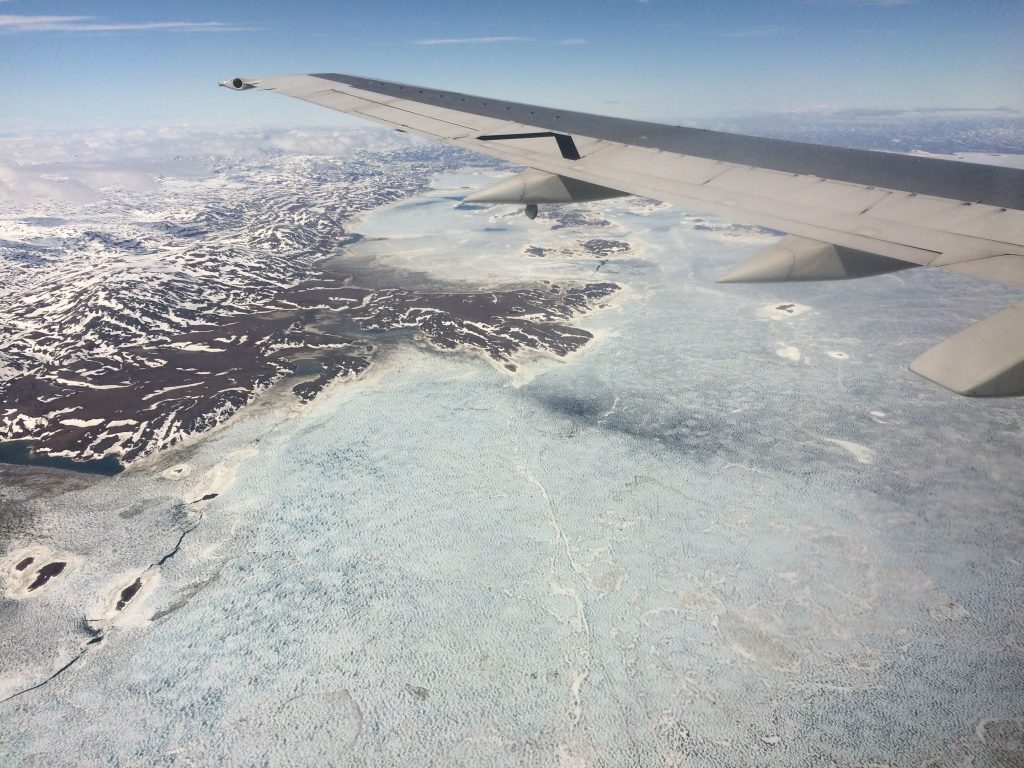
-
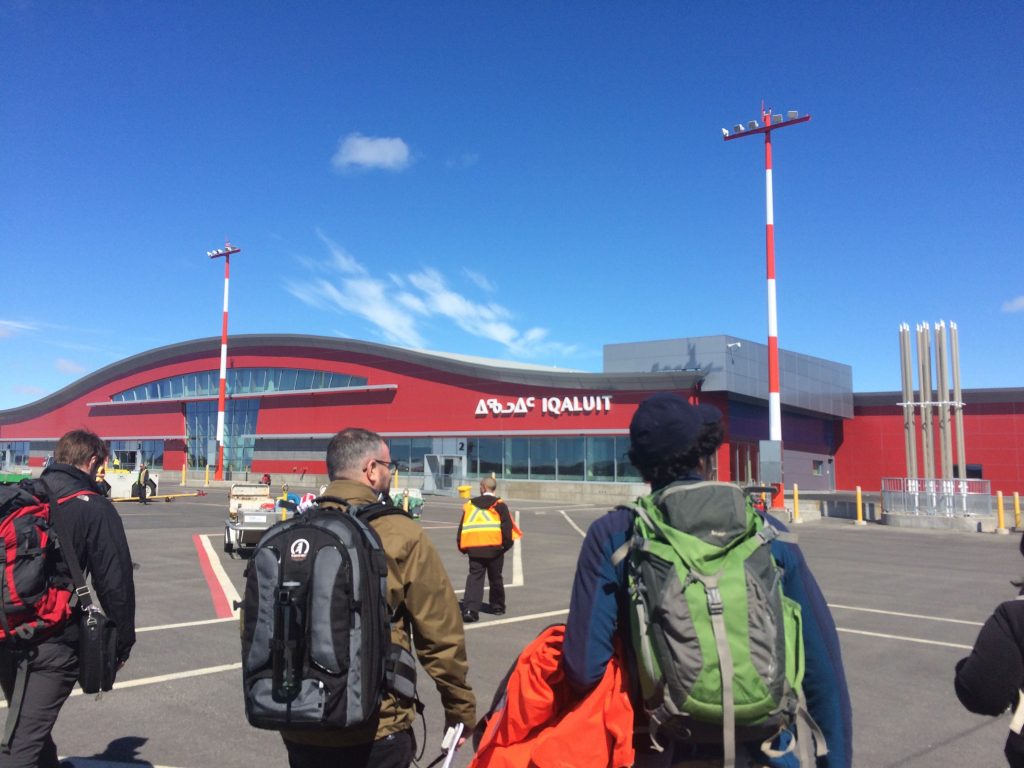
Our first stop up north was Iqaluit, the capital of Nuavut Territory and a fairly large town by Arctic standards. -
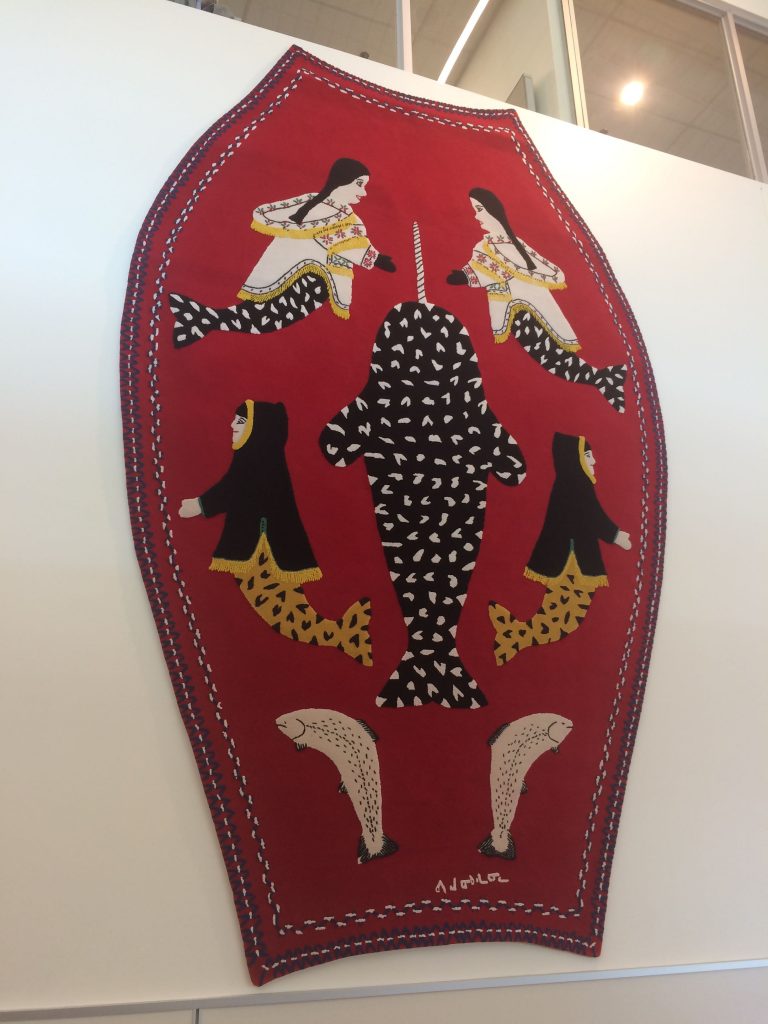
Innuit art on display in Iqaluit airport. -
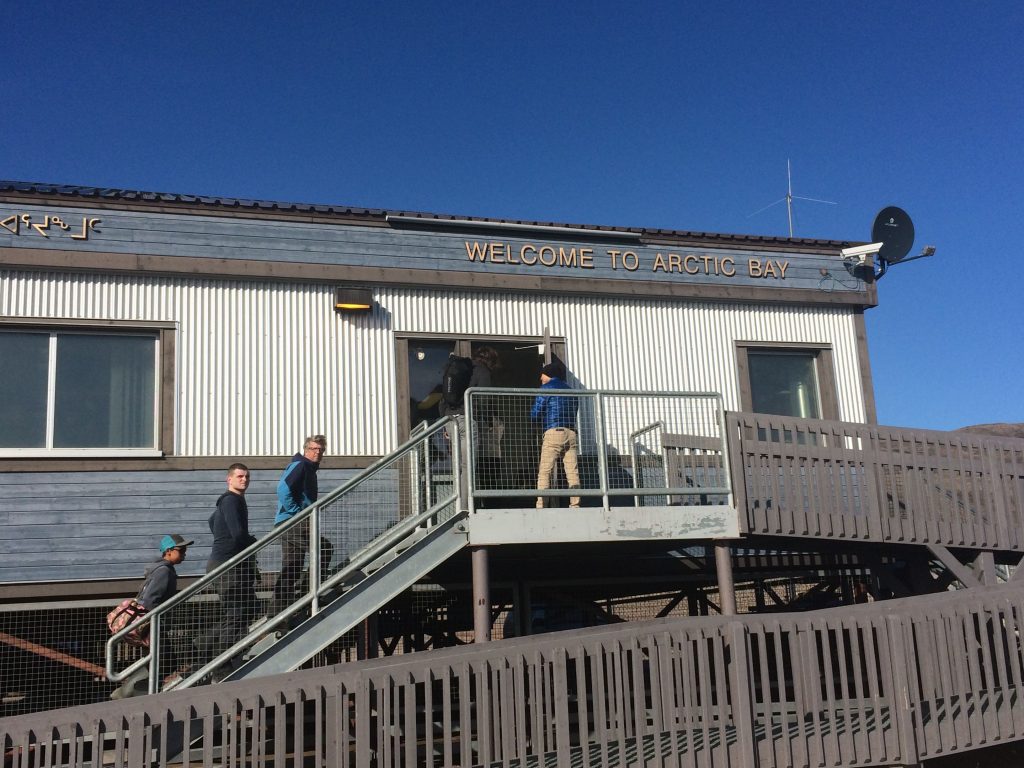
The much smaller airport at Arctic Bay.
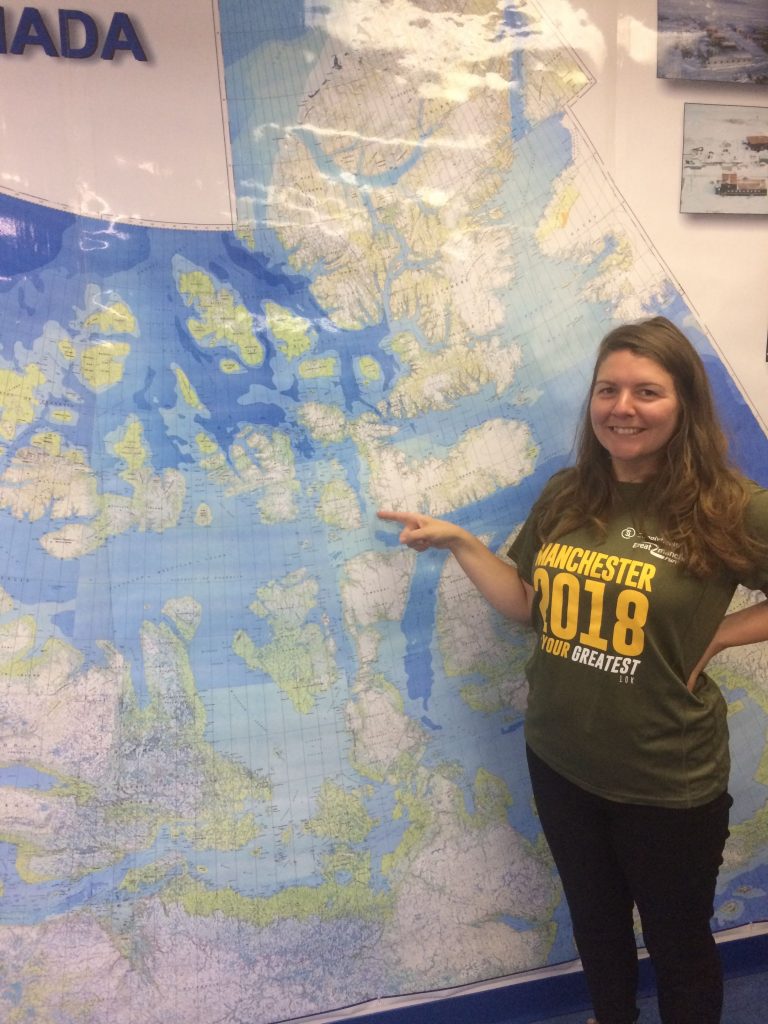
The Polar Continental Shelf Program
The Polar Continental Shelf Program (PCSP) is run by Canadian Government to provide logistical support to researchers working in the Canadian Arctic. Fortunately for us, it is based in Resolute, the only town on Cornwallis Island, so there wasn’t a huge forward trip (our guide Randy would later in the trip travel from Resolute to our campsite at Laura Lakes on a quadbike).
The facilities at the PCSP were excellent and we had access to pretty much everything we could need. We each had a 4-person room and the canteen provided 3 hot meals a day. They even have labs and equipment stores that we were able to use.
-
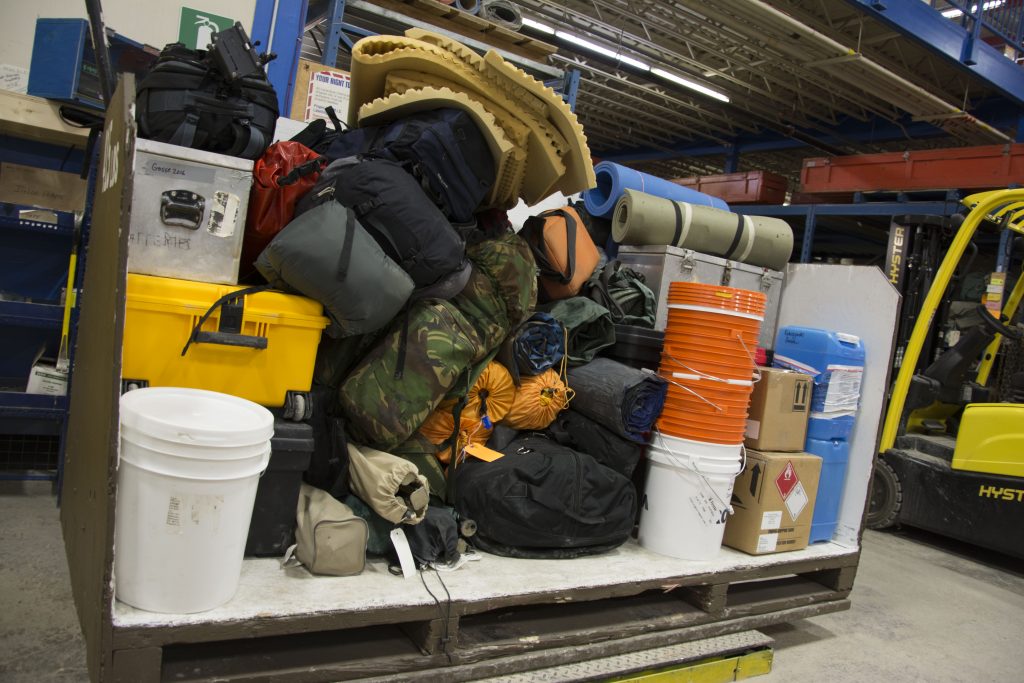
-
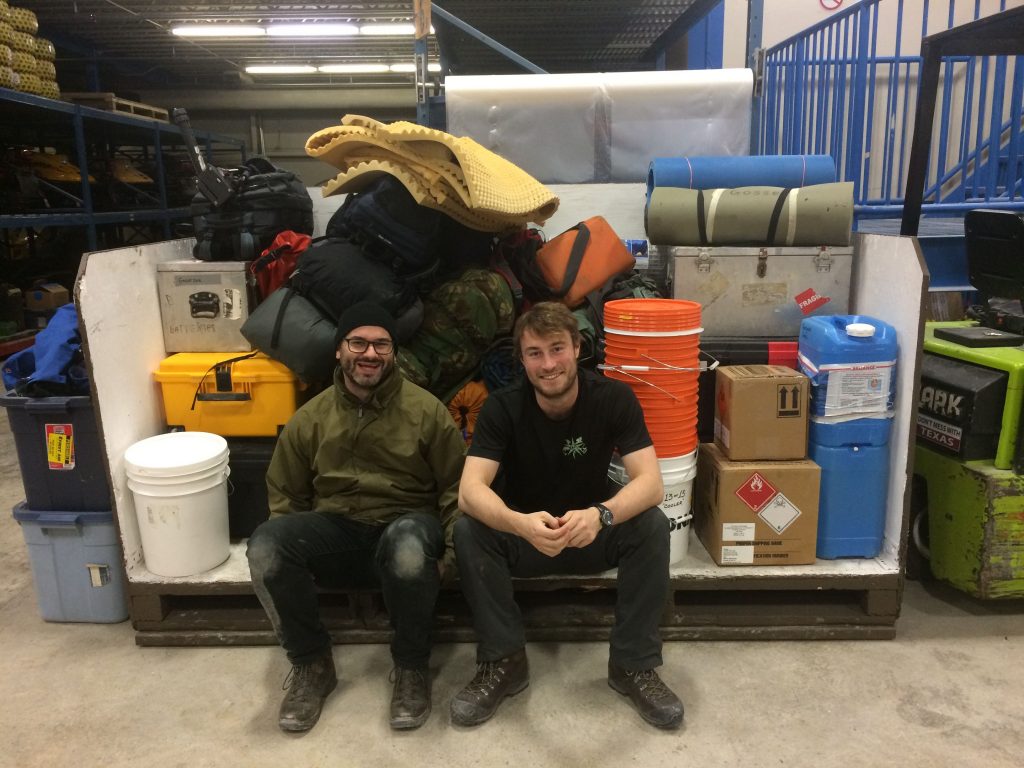
Anthony and Dave in front of our field gear, shortly before we headed out to our first field site.
We spent a few days at the PCSP preparing our equipment and learning how to erect our tents and work the radio. We borrowed a lot of our field gear from the PCSP and the lockers of past palaeo Arctic expedition teams. We even borrowed some equipment from Ted Daeschler and Neil Shubin that was used on the expedition that led to the discovery of Tiktaalik roseae!
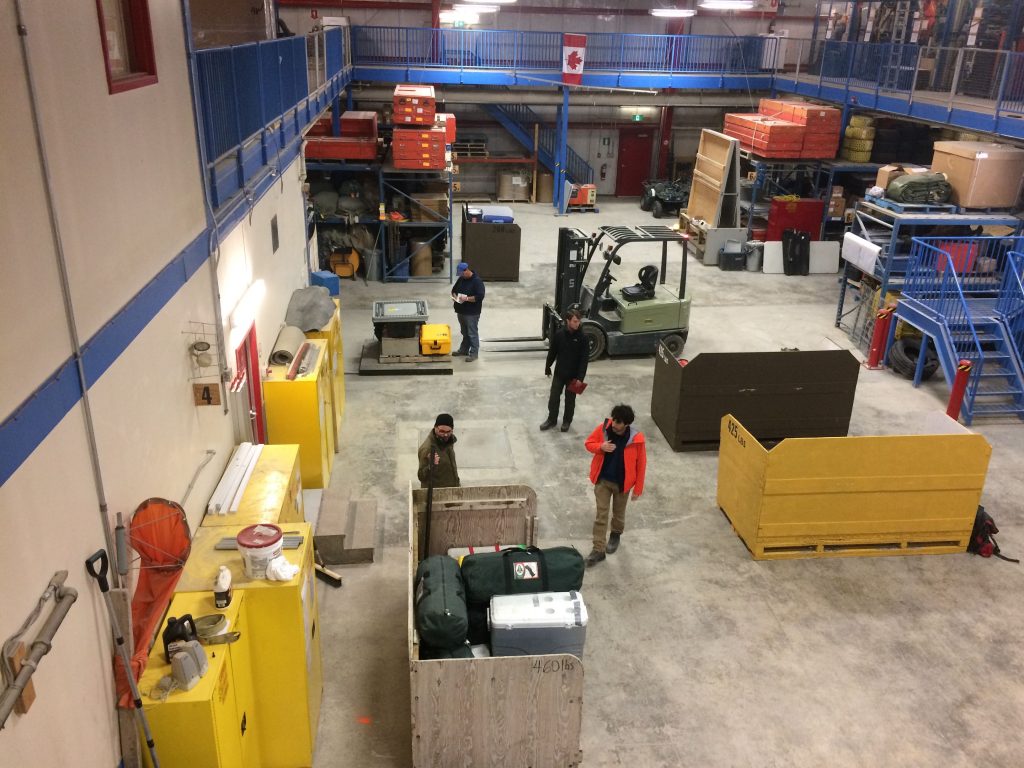
Another thing we had to prepare were the food supplies. Once we were out in the field there would be little chance of us getting a supply drop, without great cost, so all our meals had to be planned and prepared before we left. Fresh food was purchased from the only shop on the island (at much inflated prices due to the logistics of getting fresh produce to the Arctic in the first place). We took very little meat into the field with us because of how quickly it could go off and the risk that the smell would attract polar bears.
Due to unpredictable weather conditions in the Arctic, we were on standby to leave for a couple of days, meaning all our equipment needed to be ready at the drop of a hat incase the helicopter schedule changed. The island is littered with parts of aircrafts that unfortunately in the past have crashed on the island. One of the biggest problems is visibility due to fog, which can roll in and render the runway completely invisible within a couple of minutes.
We had chartered a helicopter to transport us to the south of Read Bay for the first leg of the trip. With lots of equipment and people to transport, it took three trips to get everything dropped off at the field site. It would have been cheaper and quicker to hire a plane, but we didn’t know if the conditions at the landing site were solid or sturdy enough to support a plane landing and taking off again; helicopters have the advantage of being able to land anywhere.
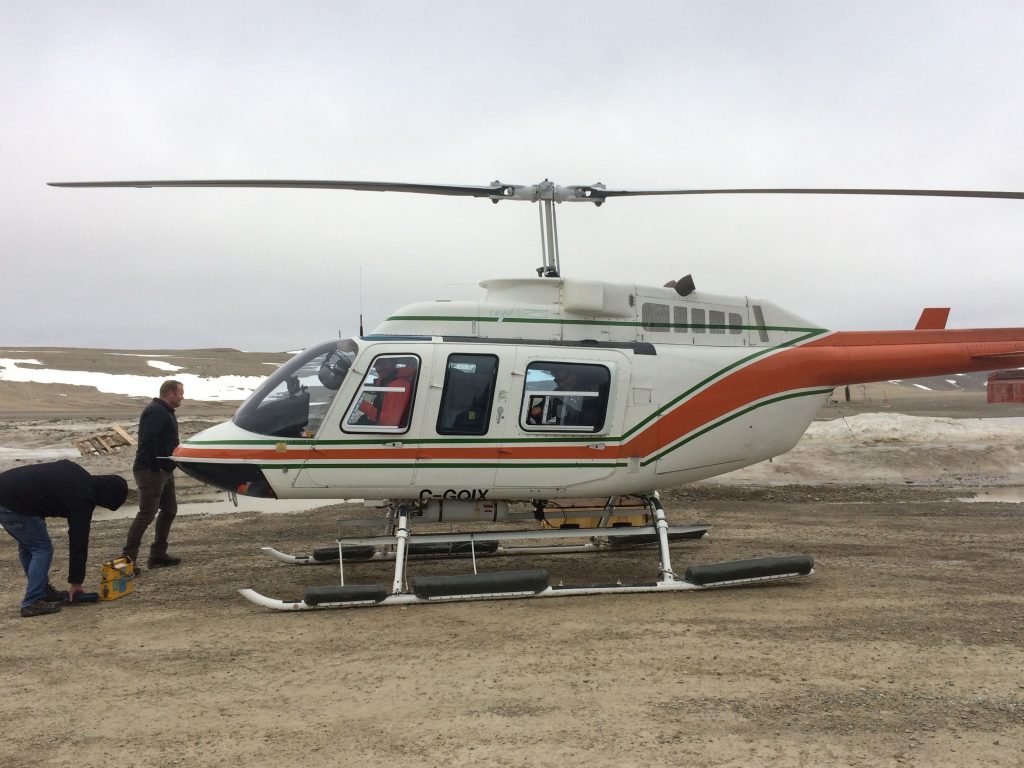
Fieldsite 1: Read Bay
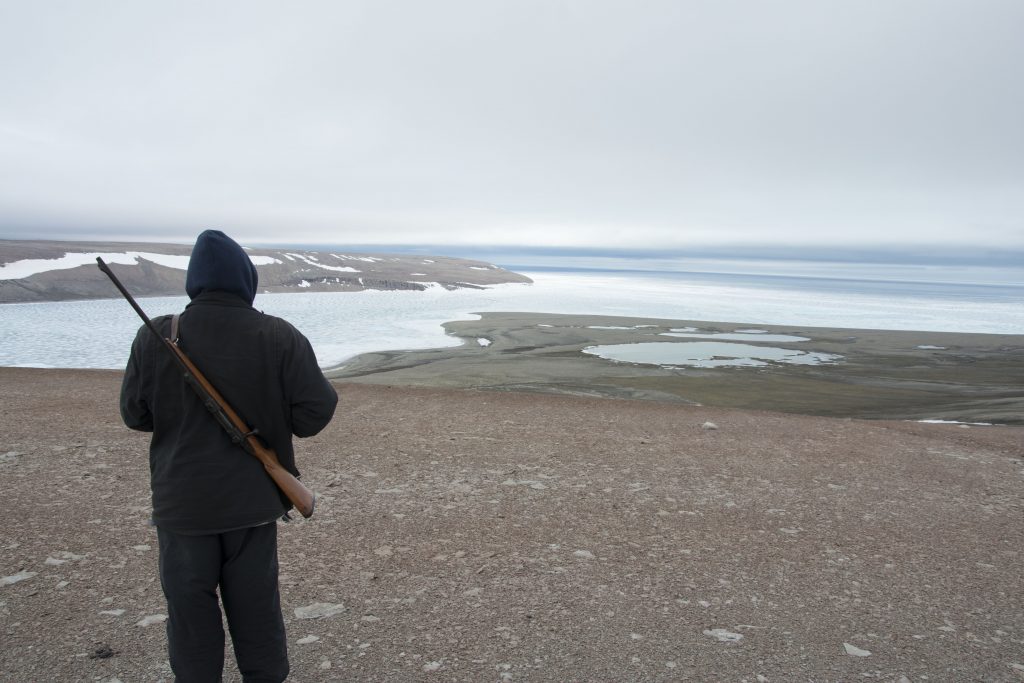
Camp Life
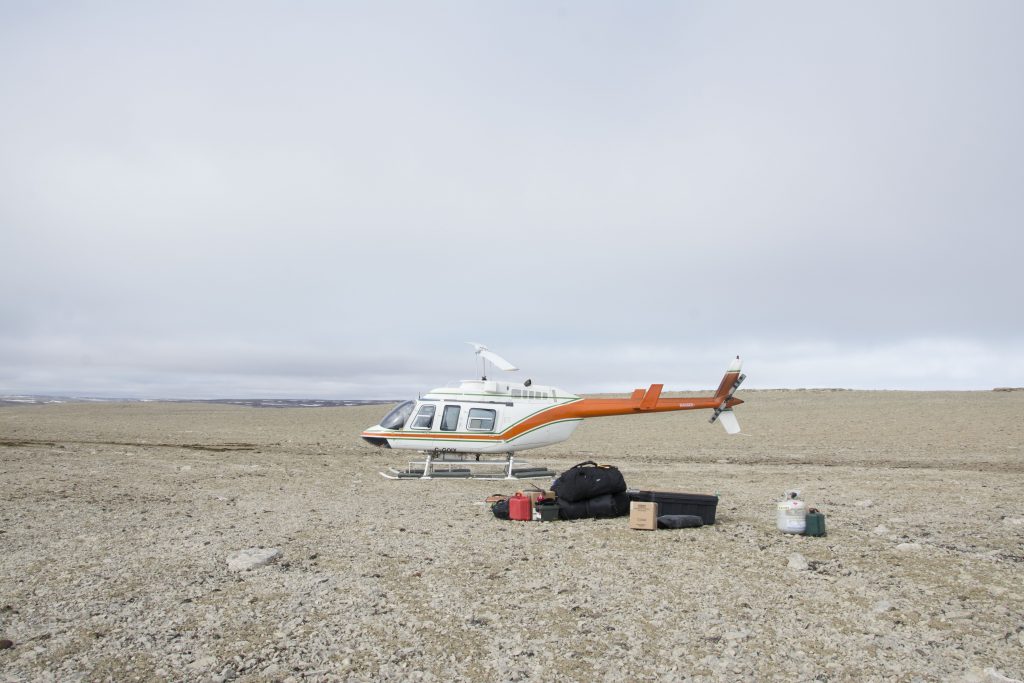
Our first experience of being in the field was a bit of a shock after the warm and comfortable research station. We had to battle very cold (around 1 degree C) and windy conditions that made putting up rather simple tents a 4 person job (Dave, having volunteered to film everyone taking off in the helicopter, was conveniently the last to be dropped in the field, by which time all the sleeping tents had been put up).
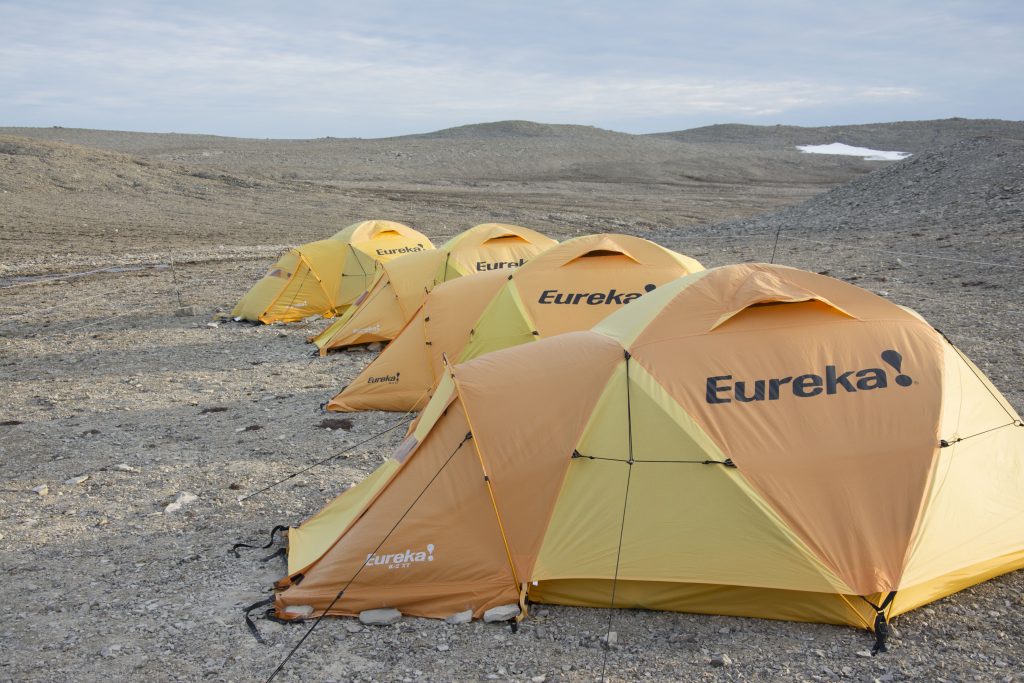
There was still the task of getting the dome tent put up though. This was much harder than when we did a trial run inside. The wind battled against us and fingers were numb. Still we had to persevere and ensure that the tent was erected properly.
Incidentally, whilst we were in the field, another group of researchers on another island lost their dome tent. It simply blew away in the wind and that was the end of their time in their fieldwork. It just goes to show that even things as simple as where you pitch your tent and which kinds of tent pegs you use can make or break your expedition.
Our communal dome tent is specially made for expeditions with the shape providing a sturdy base for weary explorers to return to after a busy day. Inside this tent we spent most of our free time, which was mostly taken up with preparing and cooking our meals.
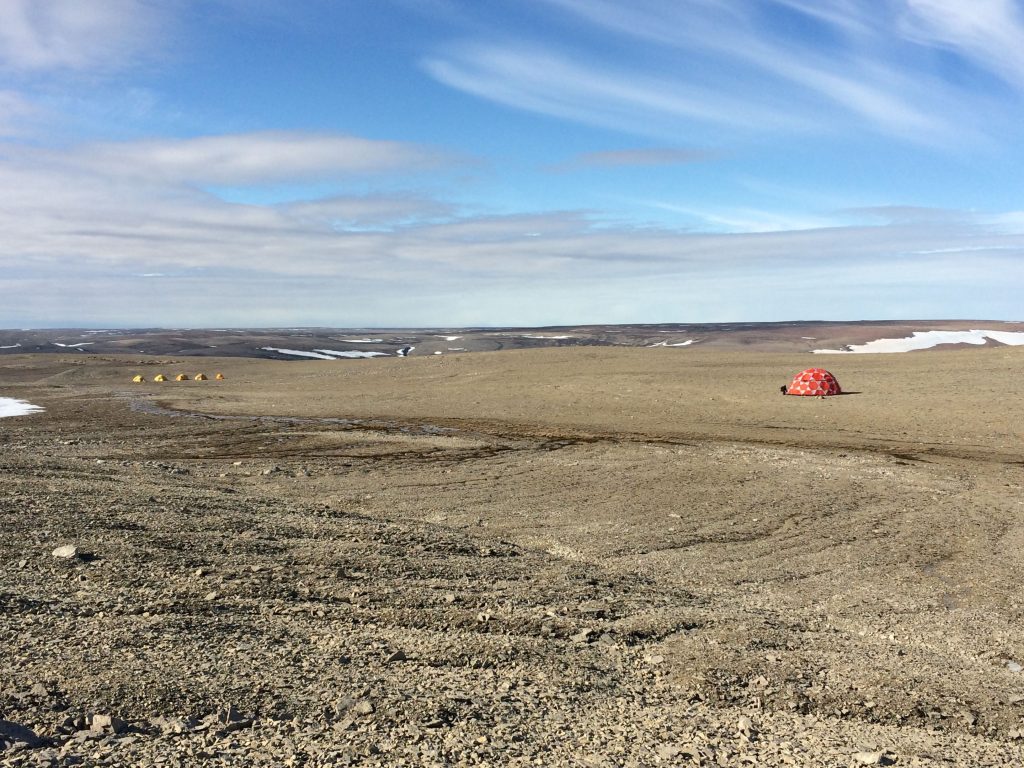
We erected our sleeping tents and dome tent a few hundred metres apart. This was a precautionary measure in case polar bears were attracted by the smell of our food supplies. Another precaution was that we set up an electric bear fence around our sleeping tents and slept with rifles in the porch. Fortunately, this fence was never set off, although our guide, Randy, volunteered to test it out, the rest of us decided this was a bad idea.
Before the trip I hadn’t really realised how cold the nights would get in the tents – I’d camped in winter in the UK before and it wasn’t too bad – so on the first night I made the mistake of going to bed without layers or socks on. By about 4am it became apparent just what a bad idea this had been when I woke up freezing cold, so I put on all of the clothes I could find. I never made the same mistake again!
Anthony
The first morning was pretty rough. I don’t think anybody slept well and we were up pretty late assembling the main shelter. I’ve never been, nor seen so many other people be so uplifted by a cup of hot, jet-black coffee.
Martin
Due to the threat of polar bears, guns had to be carried at all times, especially when you were on your own and out of sight of the rest of the team, e.g. when going to the toilet. Everyone had to know where each other was at all times so that nobody was left alone. There was always a maximum of 2:1 ratio of people to guns.
Proper care had to be taken with the guns and other defensive equipment. Keeping guns always within easy reach, laying them safely and keeping them clean was incredibly important, however, in the context of fossil hunting, this was quite an inconvenience.
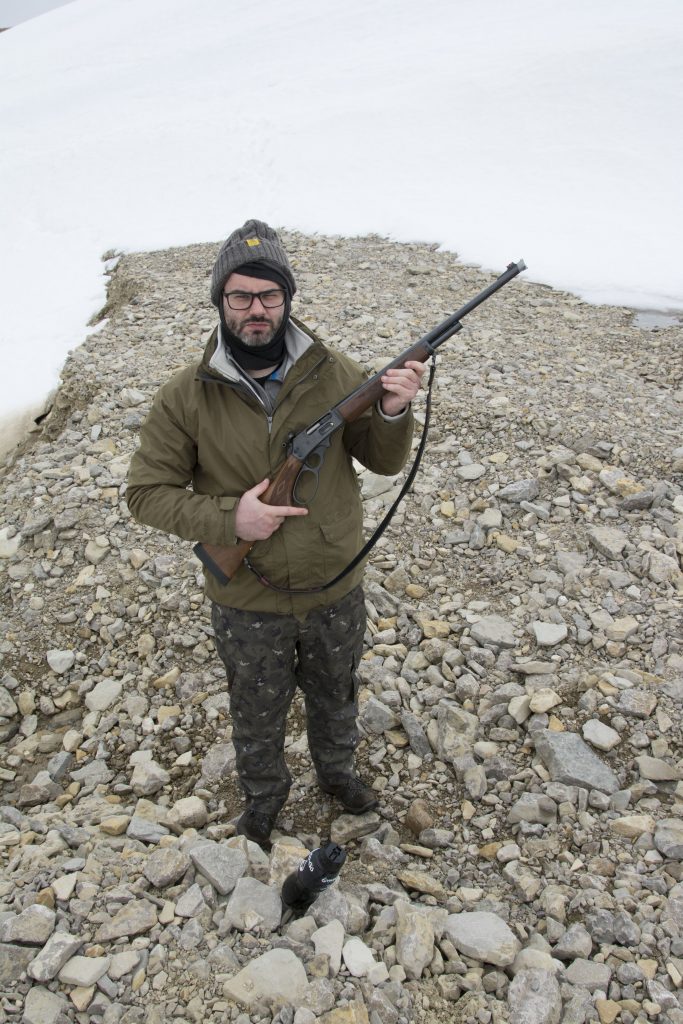
Our plan with food was to have freeze-dried meals in the day, when out in the field, that only required the addition of hot water. And a hot freshly prepared meal in the evening. Most mornings we had porridge for breakfast, except on a few special occasions when we had pancakes or hash brown and eggs. In the field, we also took lots of snacks including mixed nuts and chocolate, plus energy bars.
Eating well was very important in the Arctic as we consumed a lot of calories just trying to keep warm. This made the perfect excuse to eat lots of cake.
Cooking in the evening was a very social event. We all worked together and had a lot of fun with it too. Everyone had their jobs and by the end of the trip, we were a well-oiled machine.
Dave
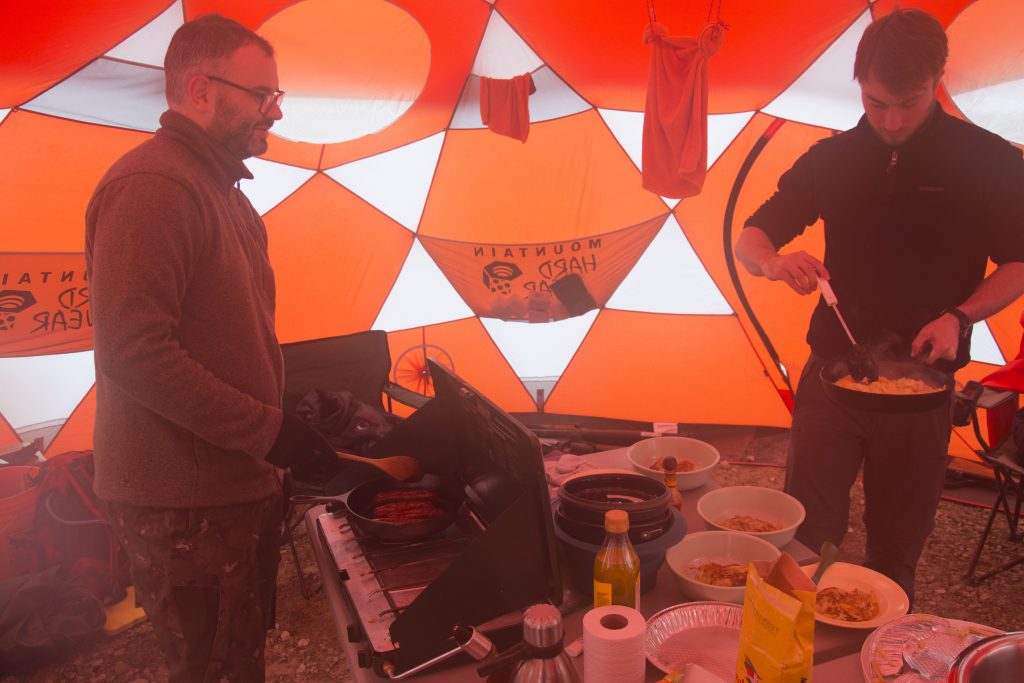
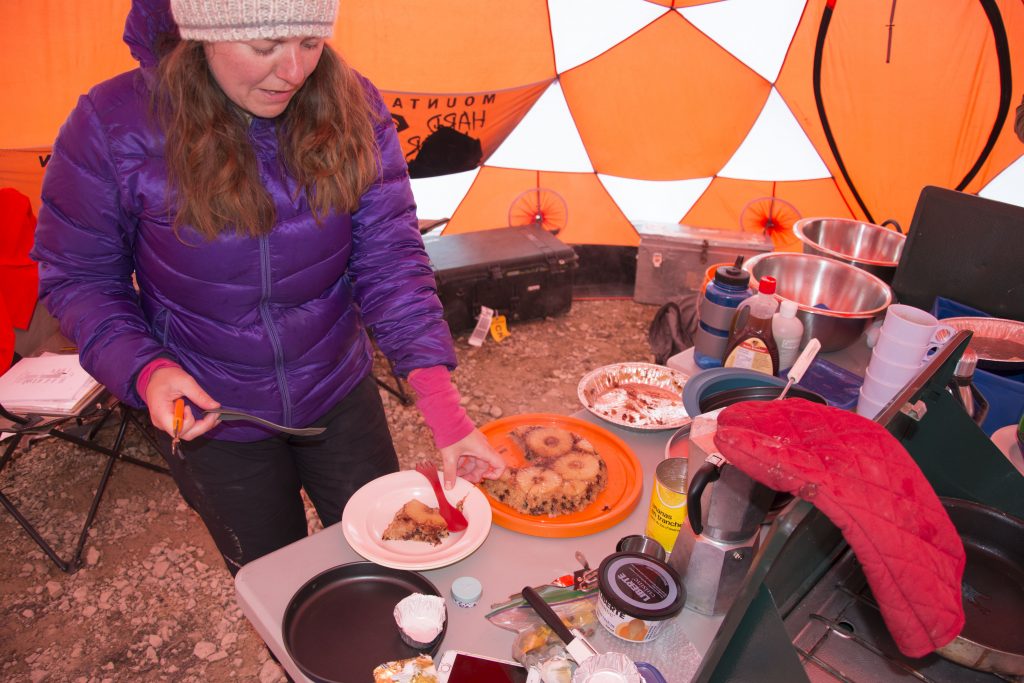
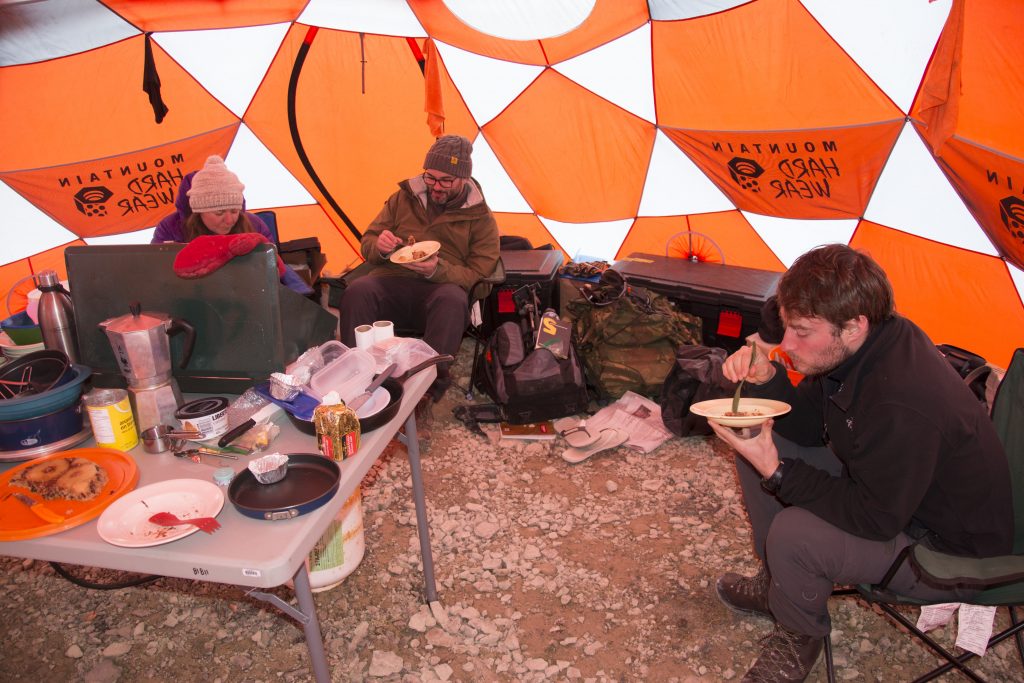
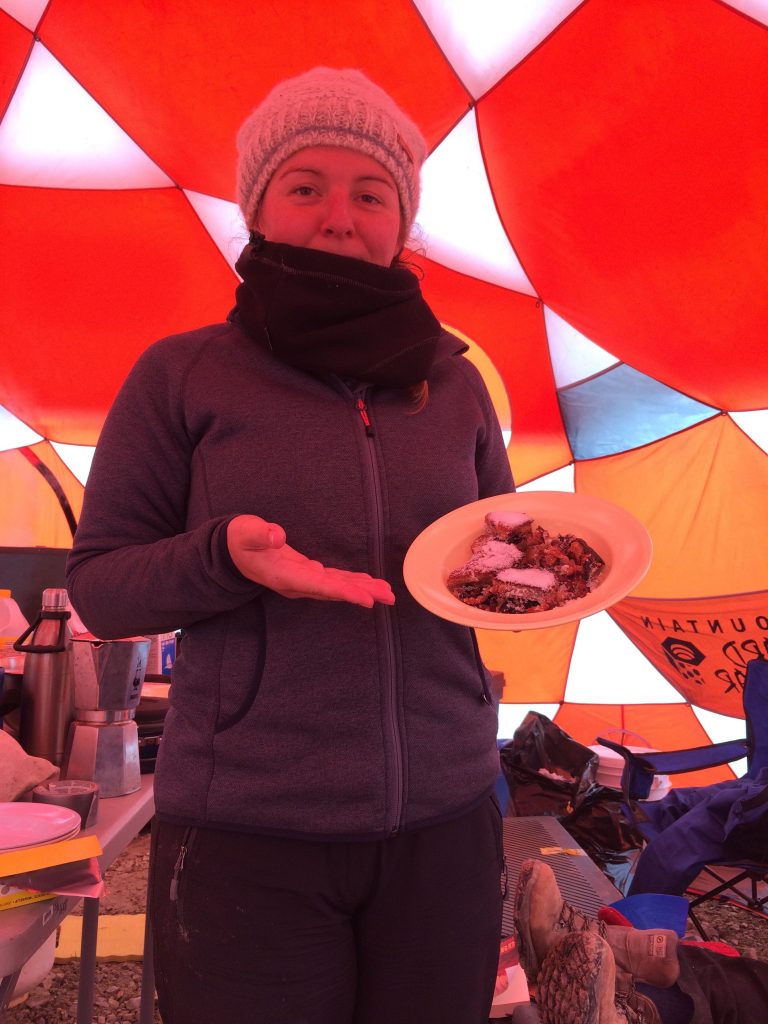
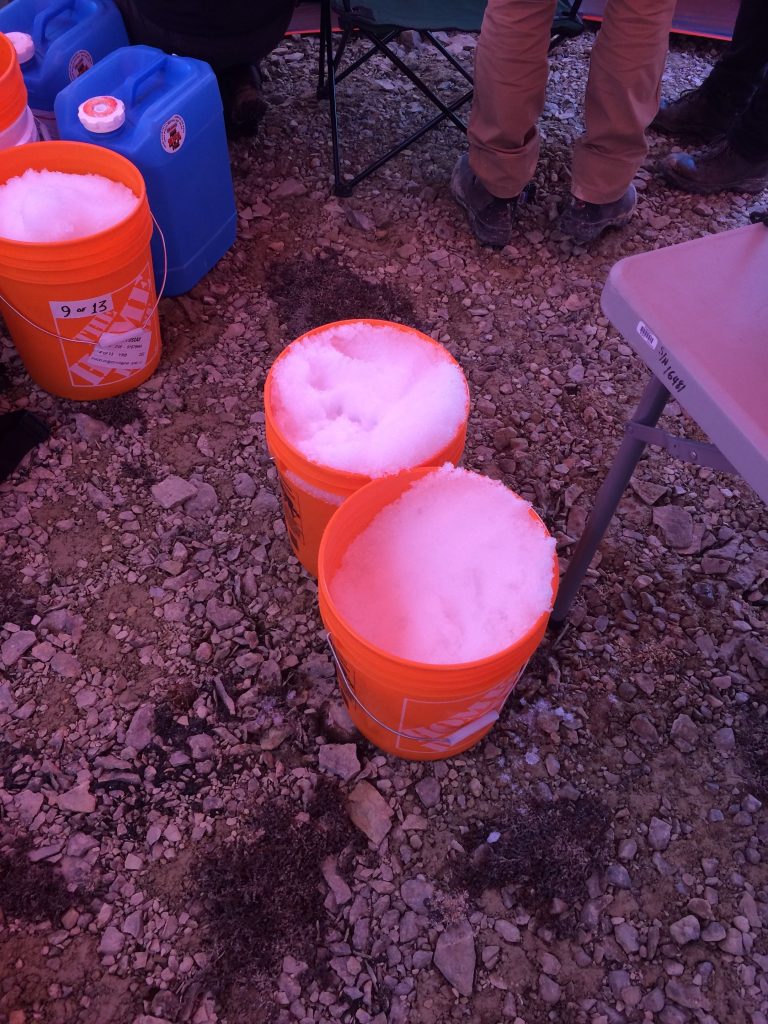
Our main source of fresh water was from snow banks around our campsite, which we had to collect in large buckets and melt on one of our gas table top stoves. The act of having to melt water even for the smallest tasks, such as brushing our teeth or washing up, makes you really appreciate having piped water!
At the end of each day, the dome tent provided the perfect place to relax tired feet, dry out our shoes and to read a book or catch up on some sleep.
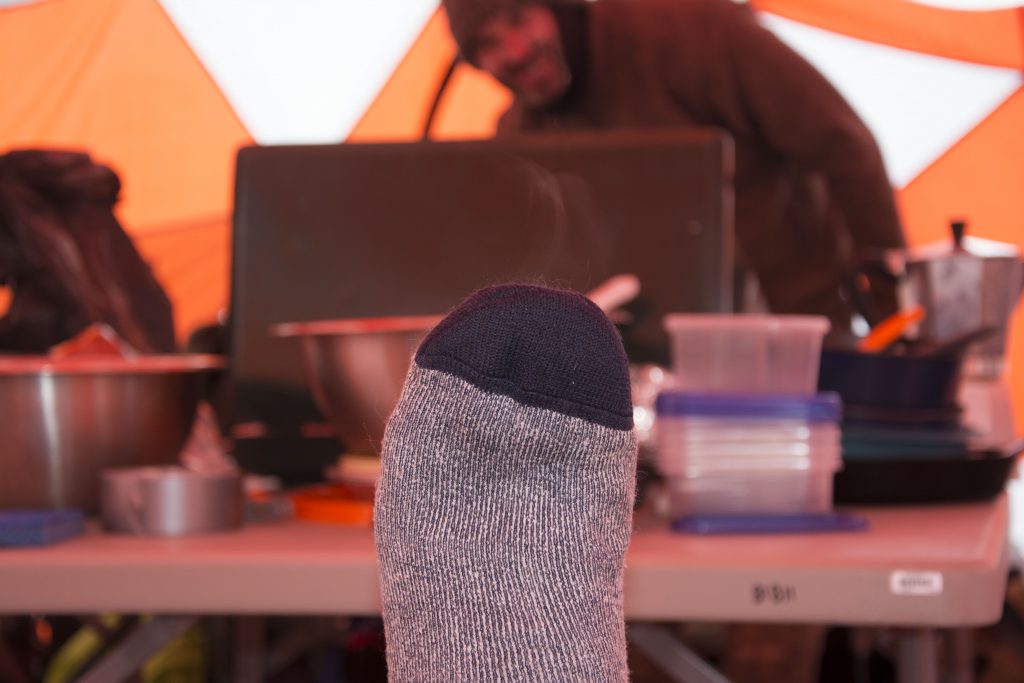
-
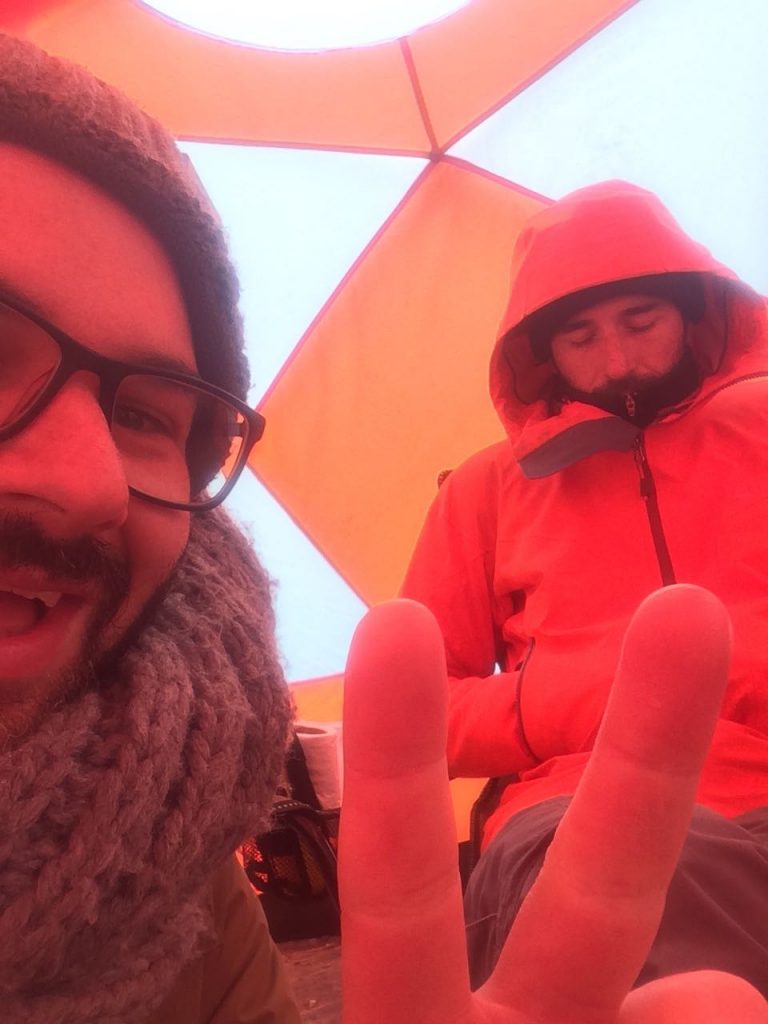
The field days were long and tiring, some days required a cheeky nap whilst waiting for dinner. Martin napping. -
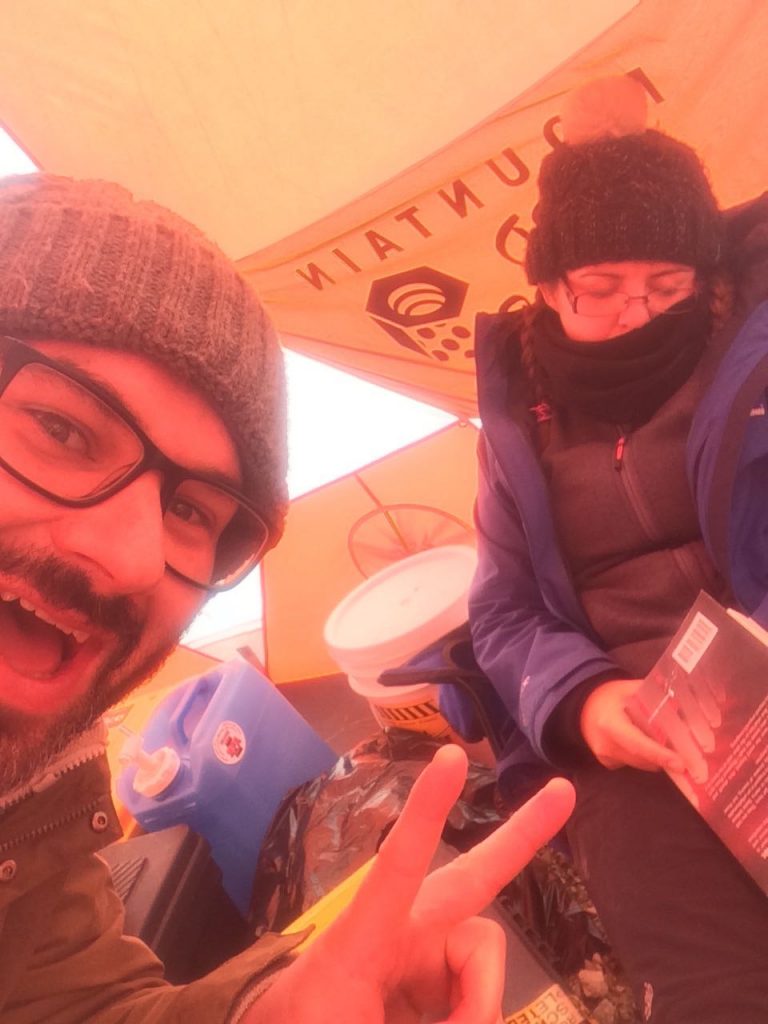
Emma napping.
Environment
For the majority of the year, Cornwallis Island is covered by a thick blanket of snow and ice, however, in summer for around 2-3 months, the snow melts and the ground becomes visible. Given there there is no vegetation cover, one might be forgiven for thinking that there would be excellent exposure, however due to the extreme conditions, the rocks are heavily weathered.
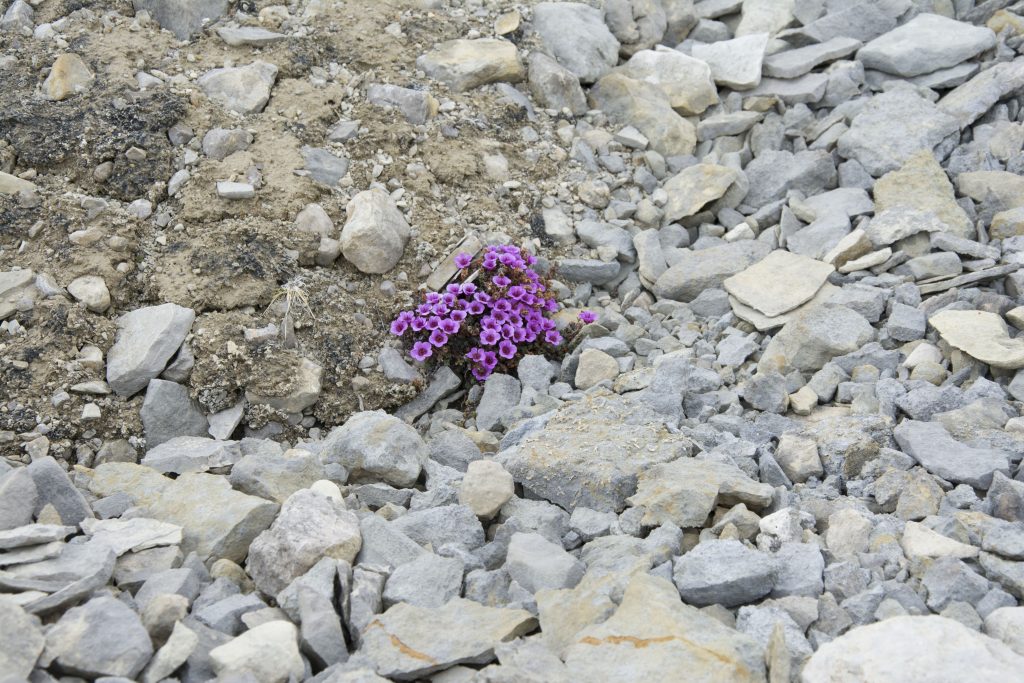
Where there is lots of water, there is also lots of mud and in the freezing conditions this mud expands. With time, any rocks on top of the mud are pushed aside, tilted until vertical and then sink into the mud. The result is that much of the surface is covered with large polygons of mud separated by blade-like vertical rocks. Walking over the mud, especially with backpacks filled with rocks, is ill advised as your feet sink into the mud and your boots get wet. Wet boots don’t dry in the Arctic.
With so much weathering, the best place to find fossils was in the river valleys where new rock surfaces are being constantly exposed by the streams. These river valleys additionally provided some shelter from the wind, the downside of which was that there was often much more snow present. This was not only harder to traverse, but concealed a lot of the underlying ground. Walking over snow, you were never sure if there was rock a few centimetres below you or a deep pit that could break your leg.
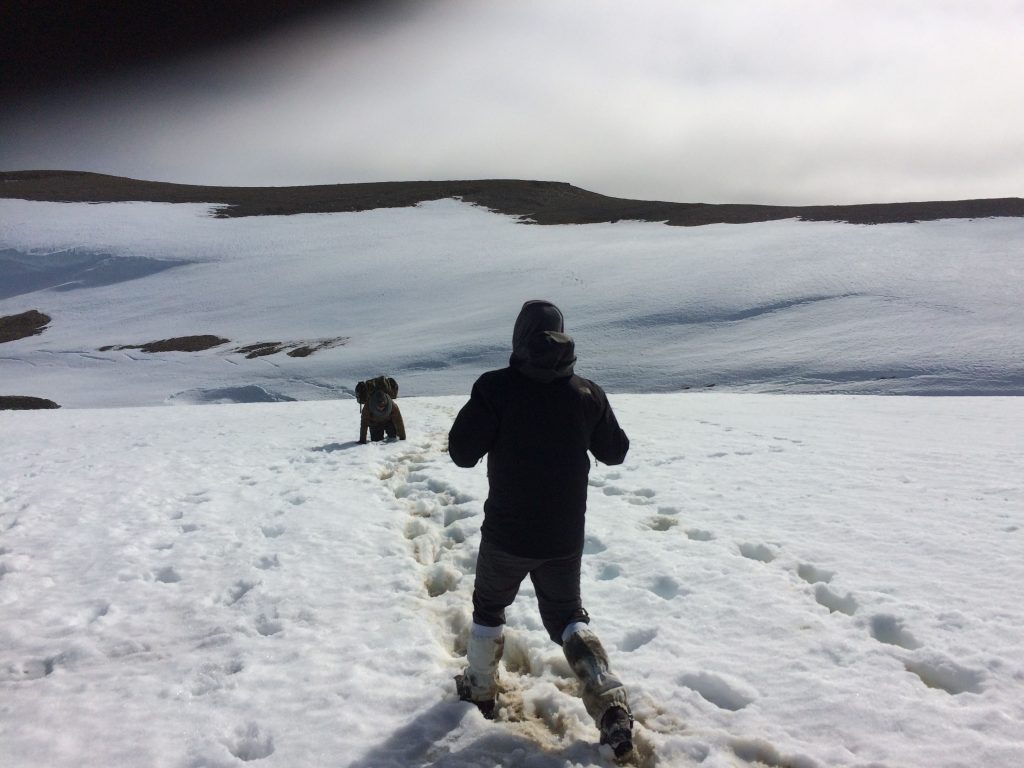
For the trip, I bought a giant bag from a military surplus store. It was fantastic and could carry so much, the downside of which was that I ended up as the mule for the trip. This was fine for the most-part, but when we had to traverse snow banks, I often found myself falling through the snow that the others had crossed without incident. I was never injured, but it did mean that I often got boots filled with snow and held up the group.
Dave
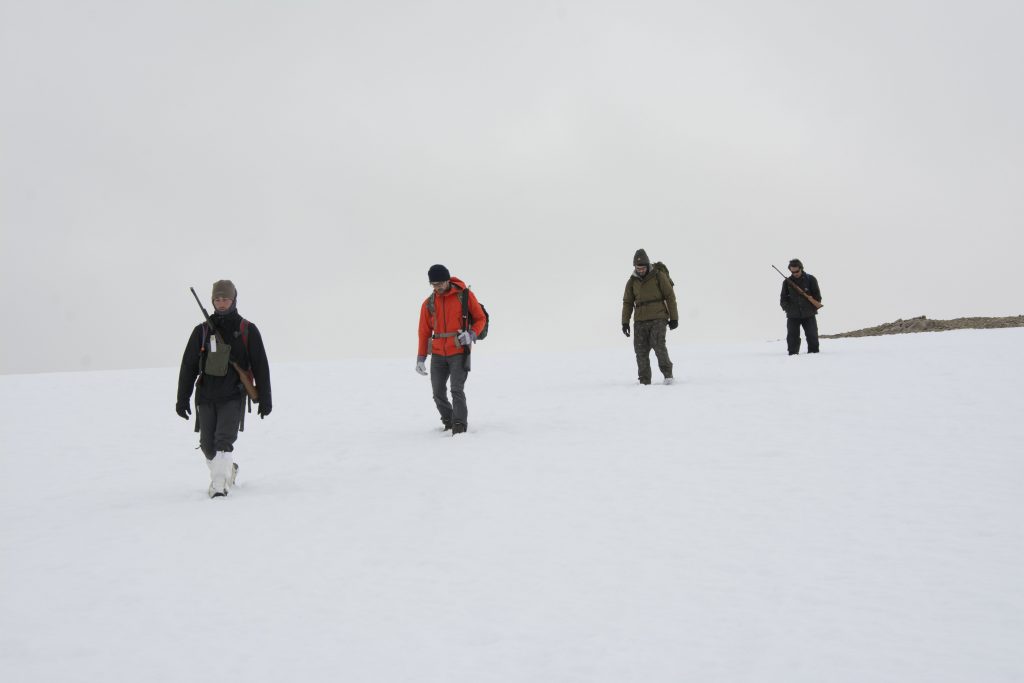
The most dangerous thing with walking over snow was that the streams often ran below in small tunnels. If anyone was to fall in the water, there was a chance that they could be swept into a tunnel and drowned.
As the trip went on, a lot of the snow cover melted away and we were able to revisit sections of rock previously inaccessible just a few days before.
I was always slightly amused by how much more worried all the English members of the team were about snow than I was….
Martin
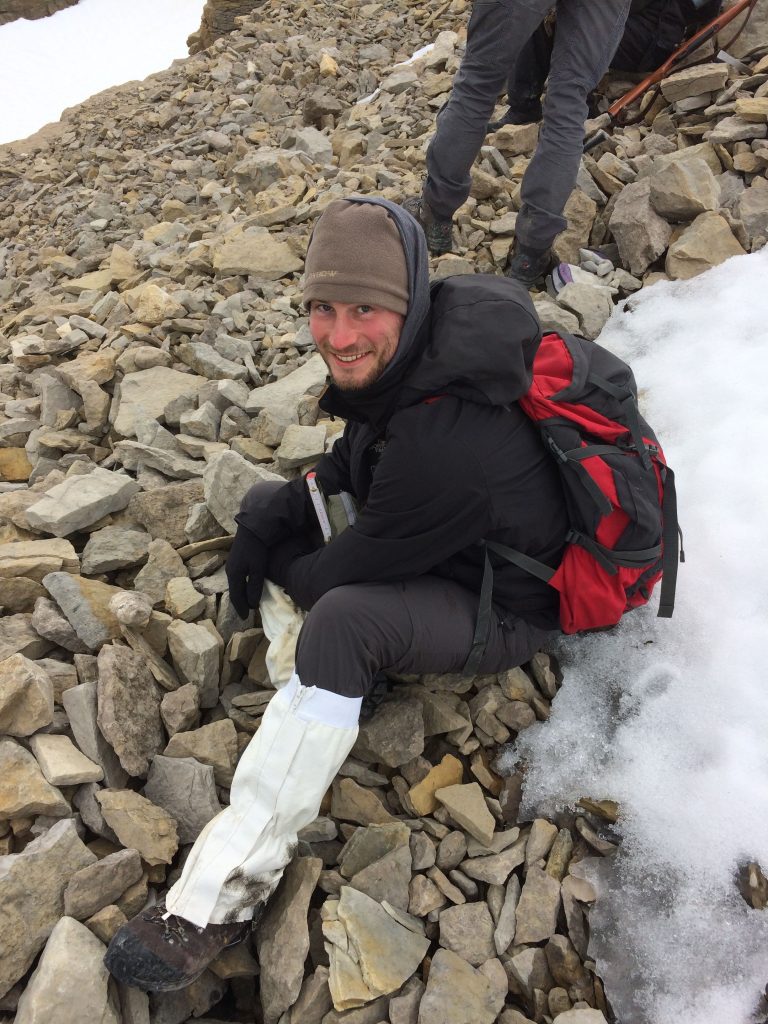
Barlow Inlet Formation
The Barlow Inlet Formation was our target rock for the first part of our fieldwork. It is predominately made up of carbonate (think coral reefs) and dolomitic rocks (slightly altered carbonate rock). The type section (this is the area where the rock formation was formally logged and described) was to the south-east of Read Bay along a river section and we knew from students’ dissertations and previous publications that vertebrate material had been found here before.
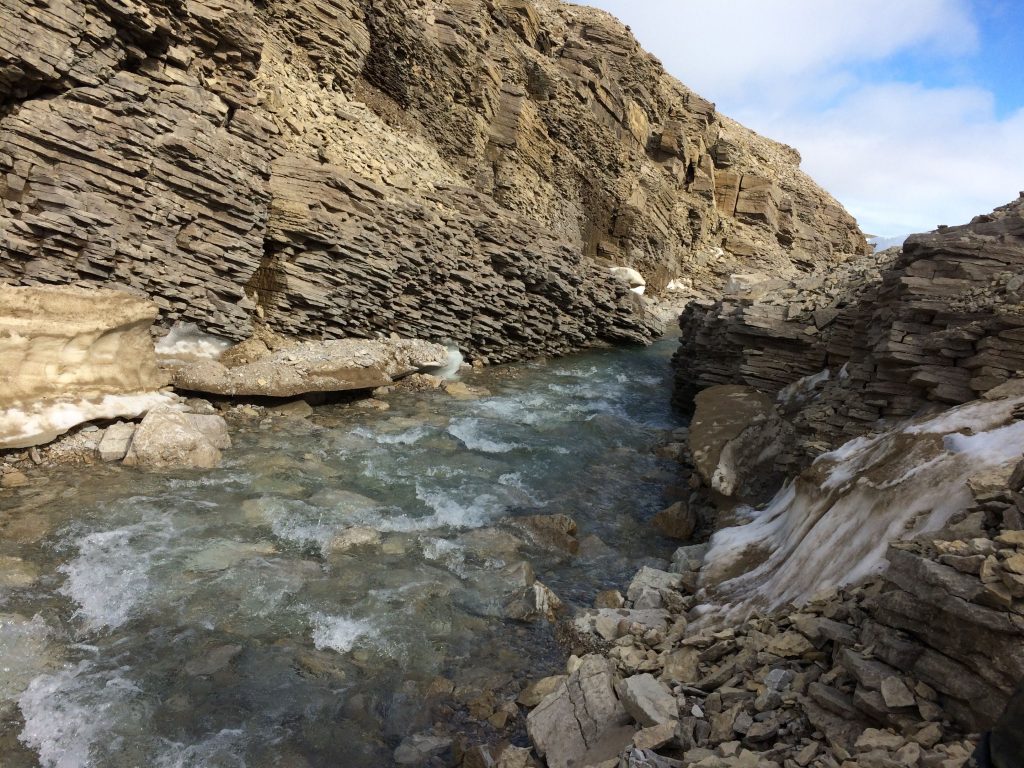
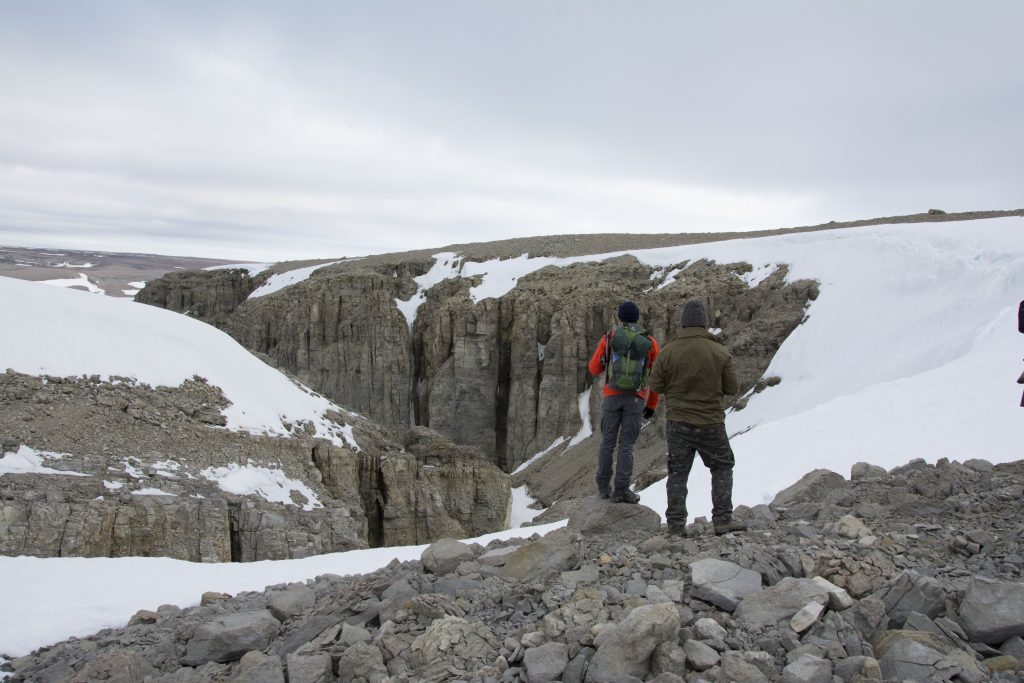
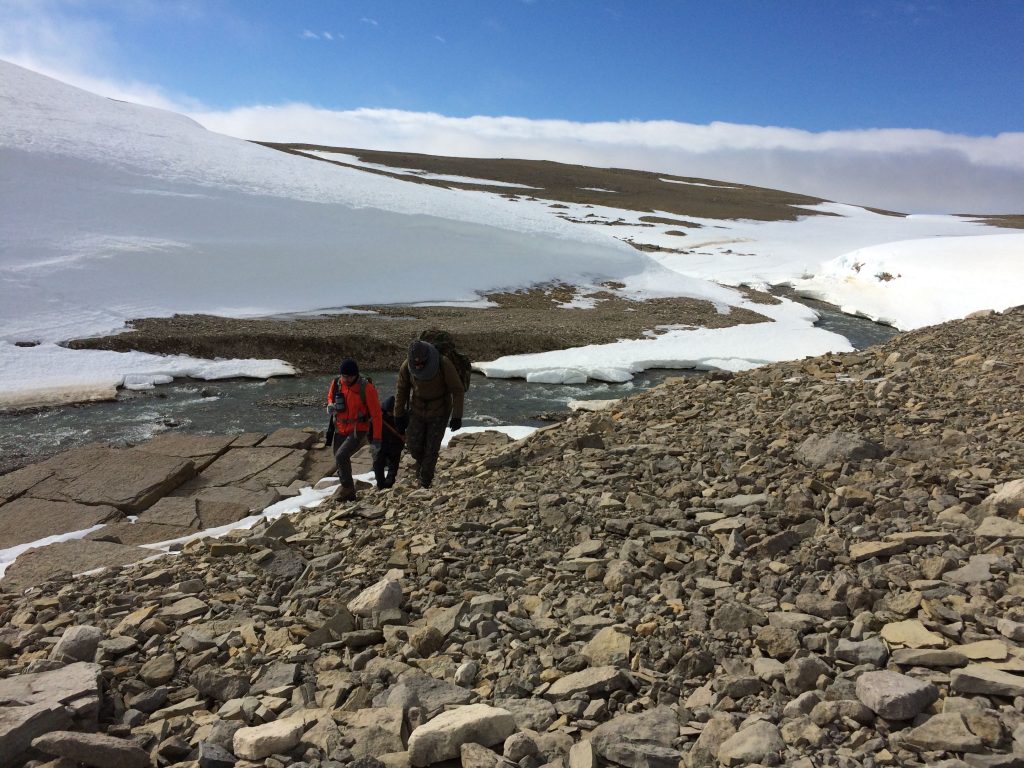
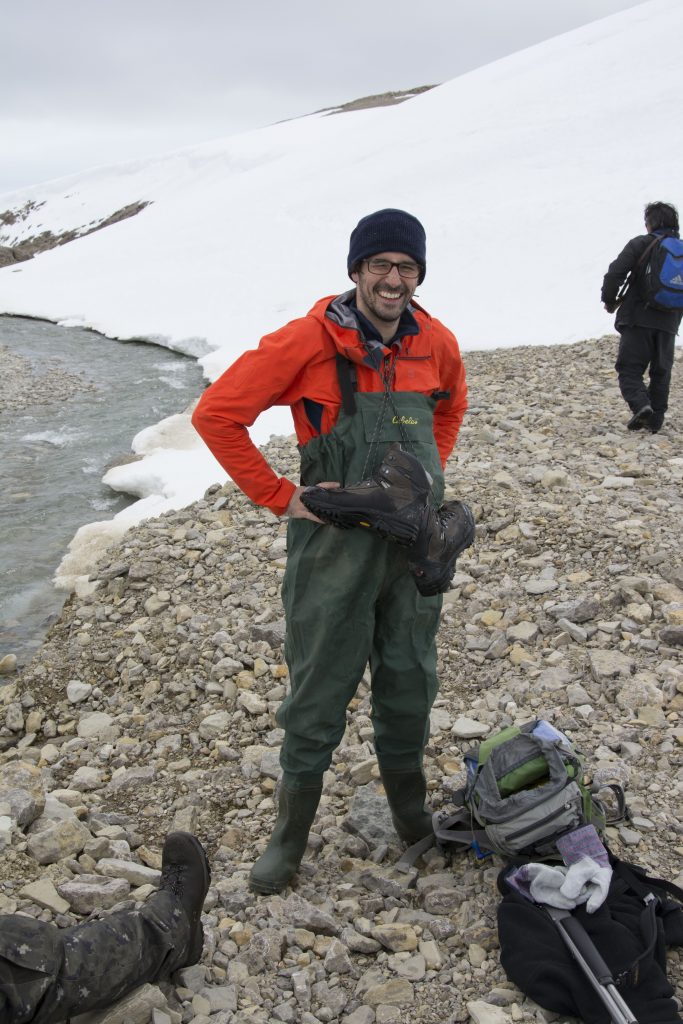
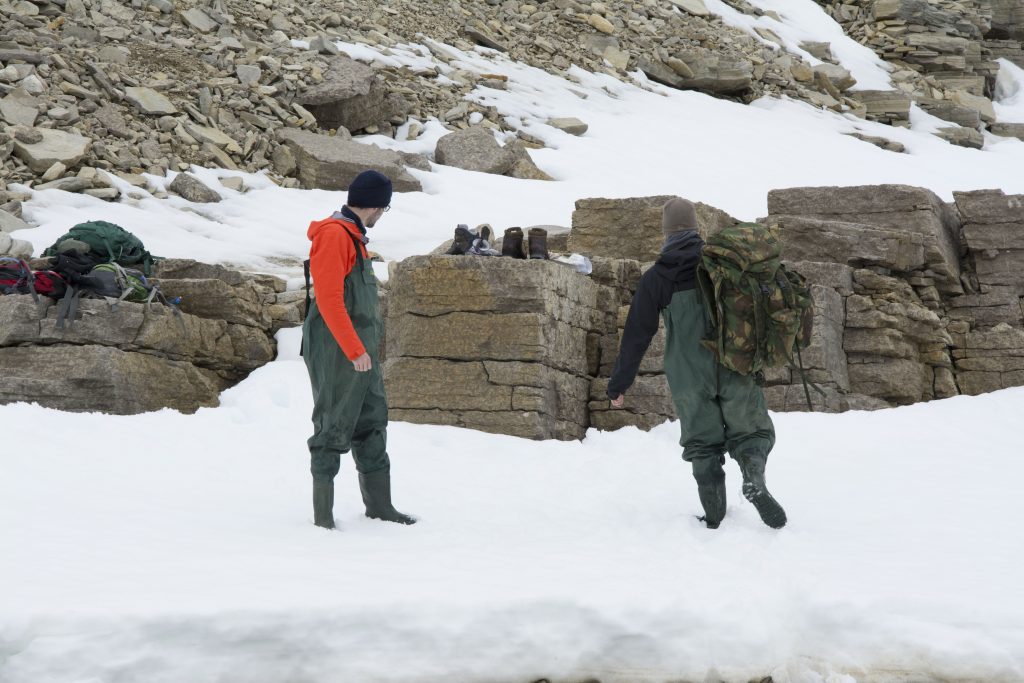
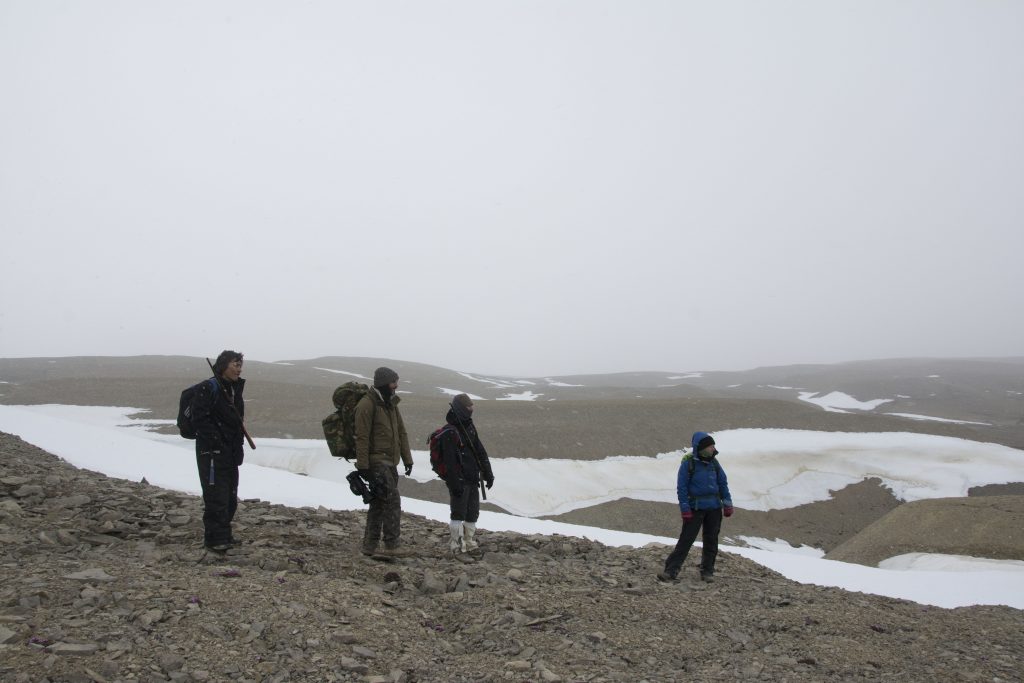
-
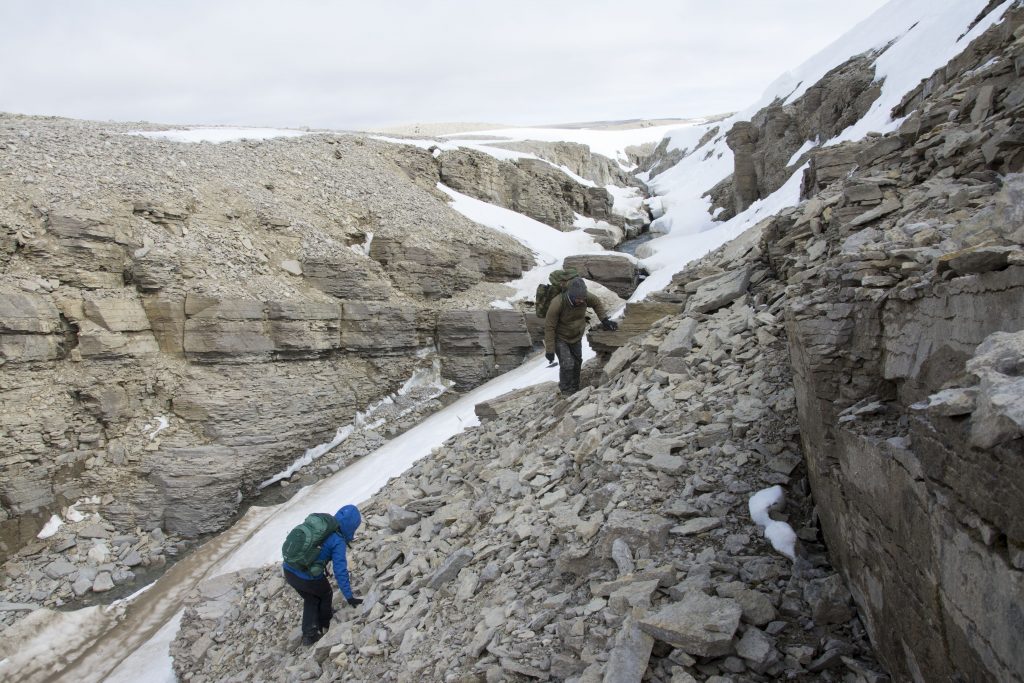
Here Dave and Emma are sampling a potential bed, whilst searching the loose rocks below for any signs of fossils. -
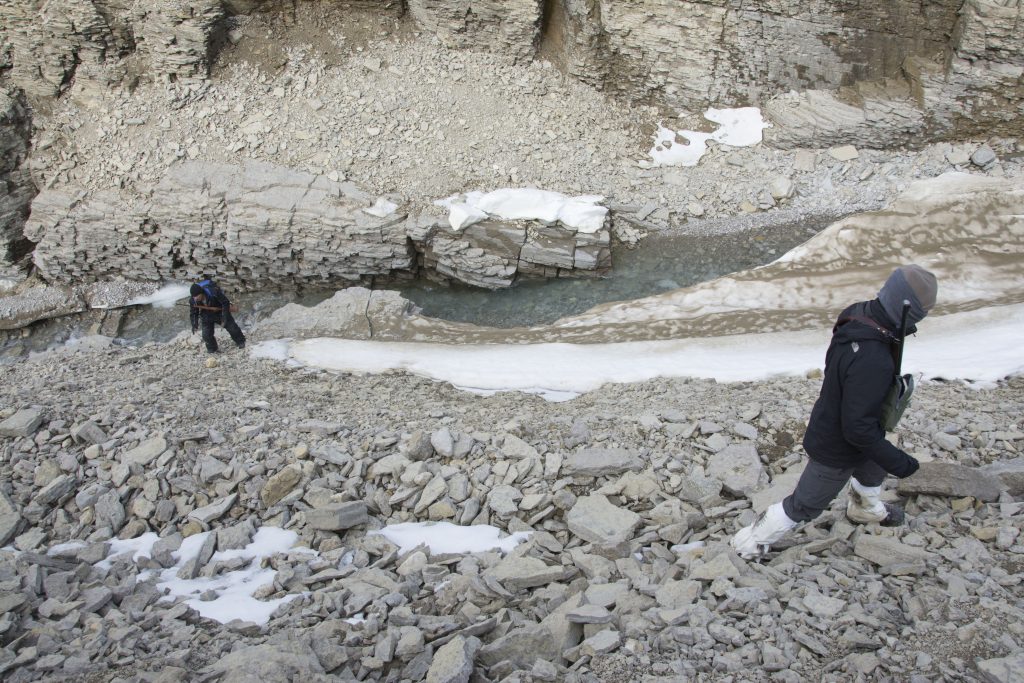
Here Anthony and Randy are making their way up a cliff section carrying, as always, our rather awkward rifles.
Many of our days were spent scrambling up loose rock slopes to get to outcrop. The sides of the river section were often very steep and we had to scramble up the from river level, or scramble down from the top surface.
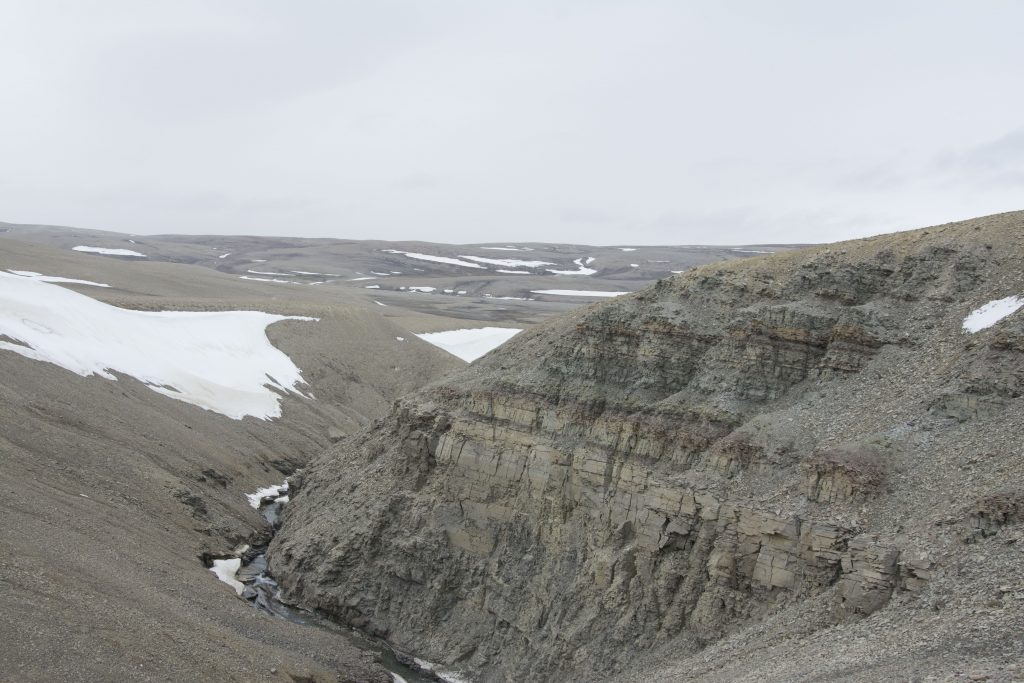
Fieldwork
For the first part of the trip, we sampled the ‘type section’ of the Barlow Inlet Formation. This was located in a narrow, but often steep-sided river valley that ran through the hills out into Read Bay. These limestones were gently dipping towards the shore so that the youngest rocks were close to the coast and the oldest rocks we examined were several kilometers inland. There were many sections along this river that were inaccessible, either because the cliffs were too steep or the snow too thick. This, added to the intense weathering, made finding our fish fossils fairly difficult on the first day.
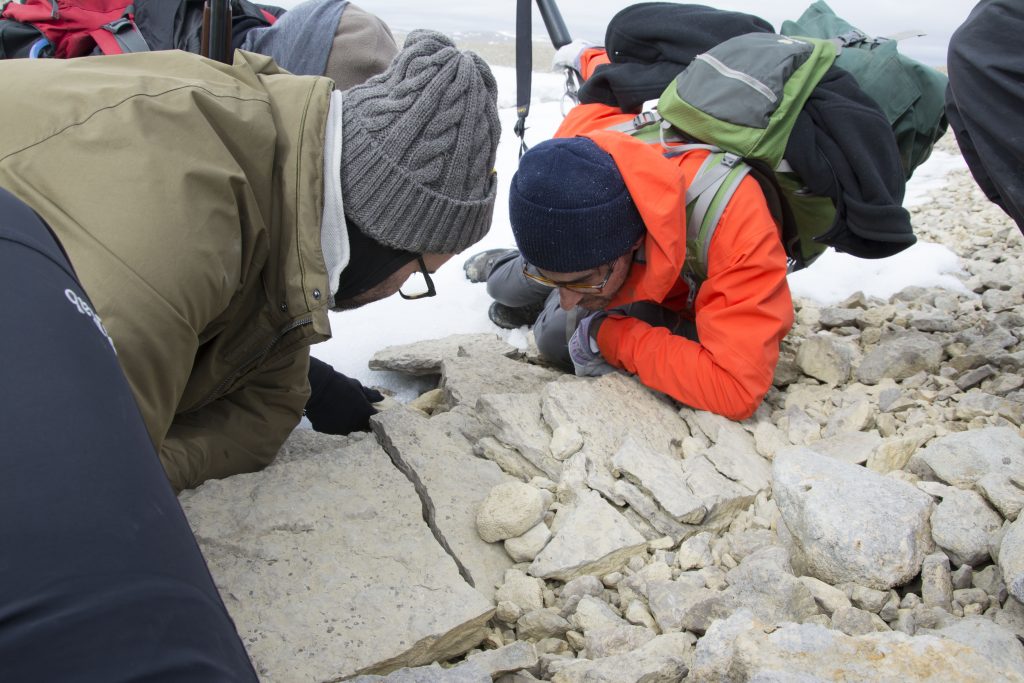
Whilst there were no fish, there were lots of corals. Lots and lots of corals. Like most of the the fossils we encountered on the island, these were more resistant to weathering than the surrounding matrix. This meant that the fossils sat prominently on the surface of the rock and in some cases were all that remained. The corals weathered a bright yellow and given that the rest of the rock had been dissolved away, they looked absolutely stunning.
It’s crazy how quickly you can become jaded with some kinds of fossils. On any other day and in any other location, finding corals of these quality would have got me so excited. By the end of the first day though, we were stepping over beautiful display-grade fossils without a second thought.
Dave
On our second day of prospecting we found a large exposed rock bed full of fragments of bone and other organisms and likely formed after a high energy storm. This was very encouraging as not only did we find both jaw and jawless vertebrate remains it also gave us a reference of what to look for i.e. colour of fresh bone, weathered bone and the different morphologies and textures.
We were very lucky to find vertebrate fossils on our second day. Most of our finds were really small micro-remains, which meant, my most vital piece of field equipment was my trusted hand lens. The bone we were finding was predominantly white and one of my first finds was a tuberculated bit of bone, that turned out to be Lophosteus: an early osteichthyan. We also found bits of acanthodian jaw, jawless vertebrate dermoskeleton and potentially a bit of placoderm.
Emma
These were our first tantalizing glimpses of what could be some of the oldest gnathostomes in the fossil record.
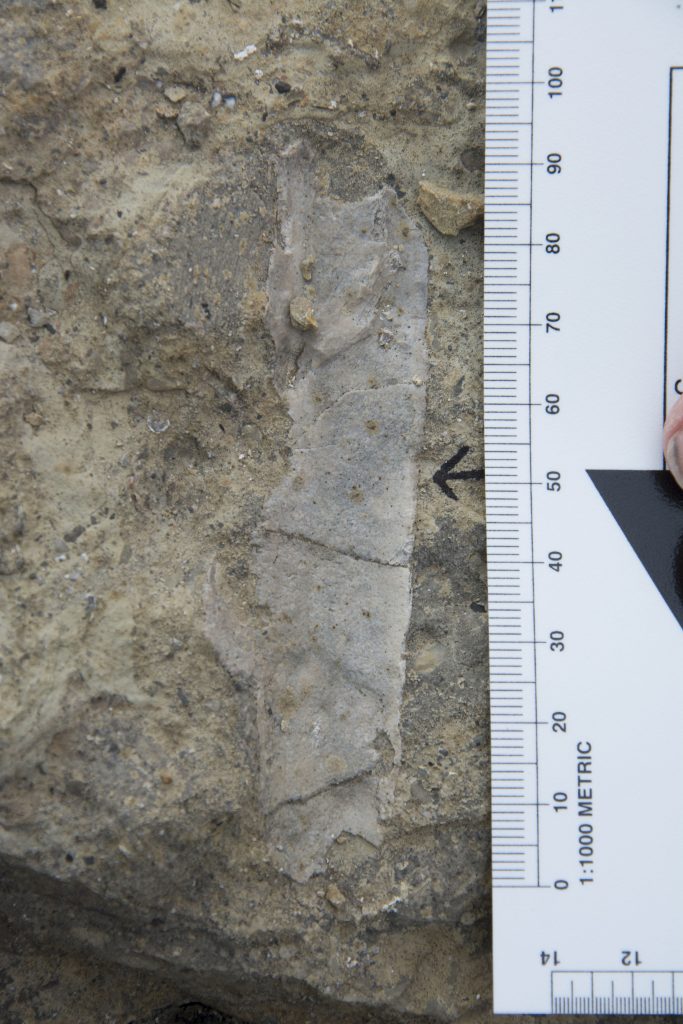
The next day, we returned to some of the same rocks and also to record the geological context of our finds.
Since the snow and steep river valleys meant accessibility to rocks was always an issue and as a result, our sampling was very disjointed. One day, we’d be at the top or the section, the next we’d be at the bottom, and could only fill the middle in later in the trip. We therefore had to be sure to record all the geological data at the time, so that we could piece it all back together in the right order at a later date.
This is one of the principle reasons we had Anthony, our geologist, who was on hand to take sedimentary logs throughout the sequence. Doing this made sure that any fossils we found could be properly contextualised.
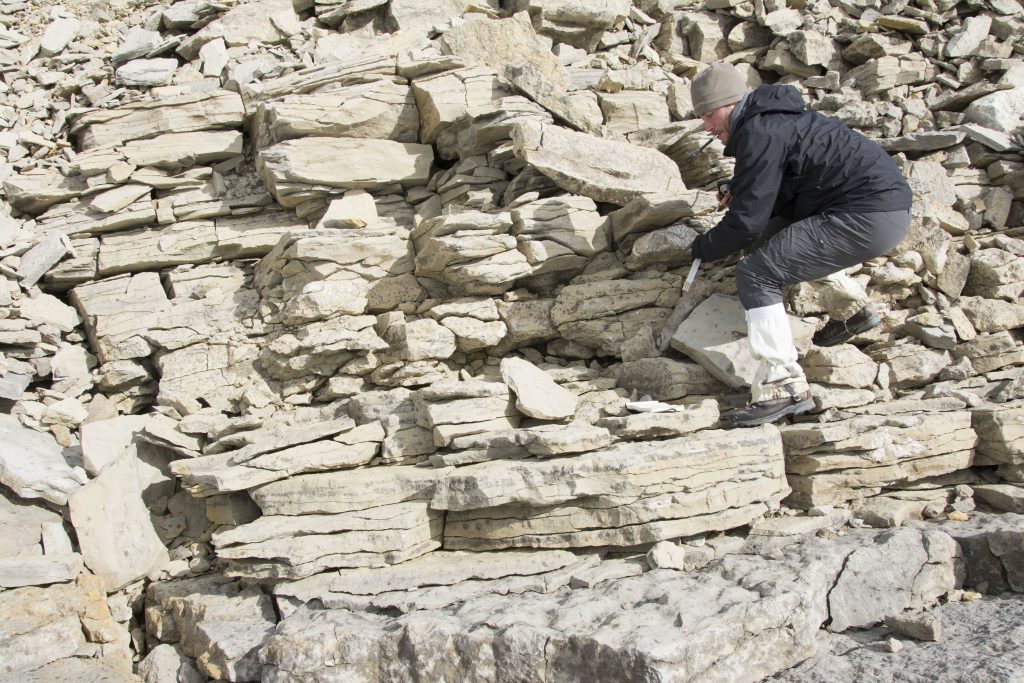
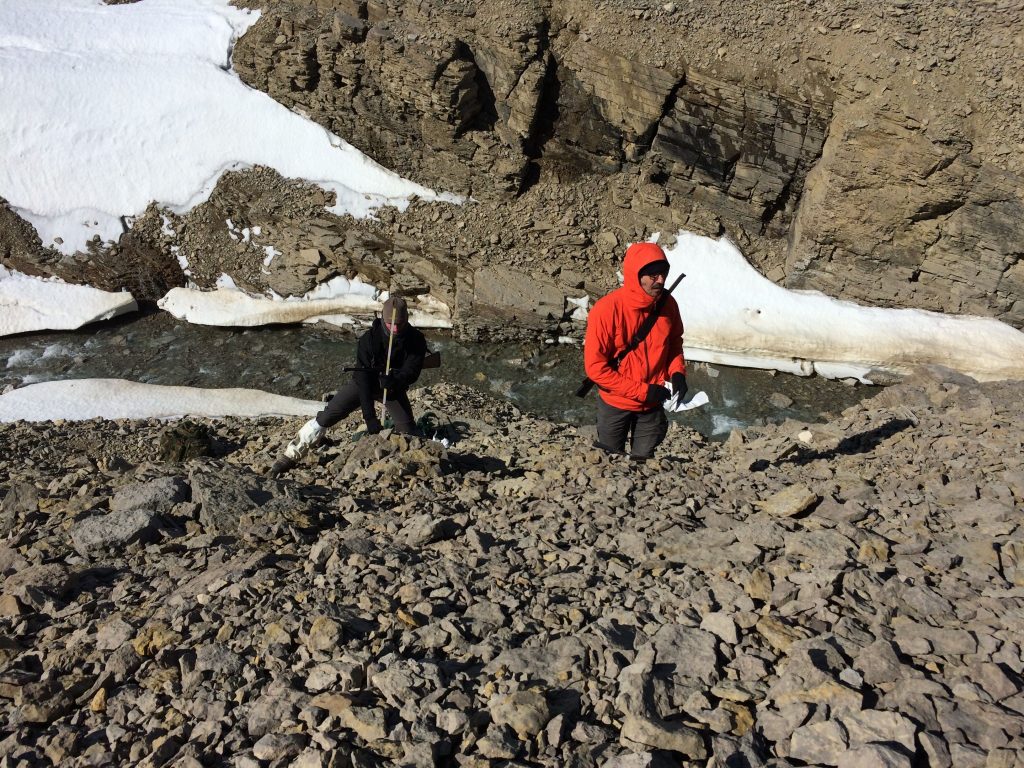
Our second day in the field was one of the most successful for me, because we came across some exciting trace fossils! A lot of my work involves looking at the trace fossil record of when animals first came onto land, and what we can then infer about their behaviour during the colonization process. I was invited along on the trip to provide some sedimentological knowledge, and I wasn’t really expecting to find anything that really tied in with what I’d done before, however just up section from one of our most productive vertebrate fossil localities the was a surface covered in Polarichnus.
This trace fossil is something I’ve come to associate with the colonization of land as it occurs in most of my key field locations, and it appears to show evidence of an animal burrowing just beneath the sediment to retain moisture when the surface is drying out. Finding these traces in the Arctic was very exciting, not only because I didn’t think i’d find anything out here, but also because they were occurring in the exact environment where they’d be expected to occur, supporting what we thought we knew about why these burrows were made.
Anthony
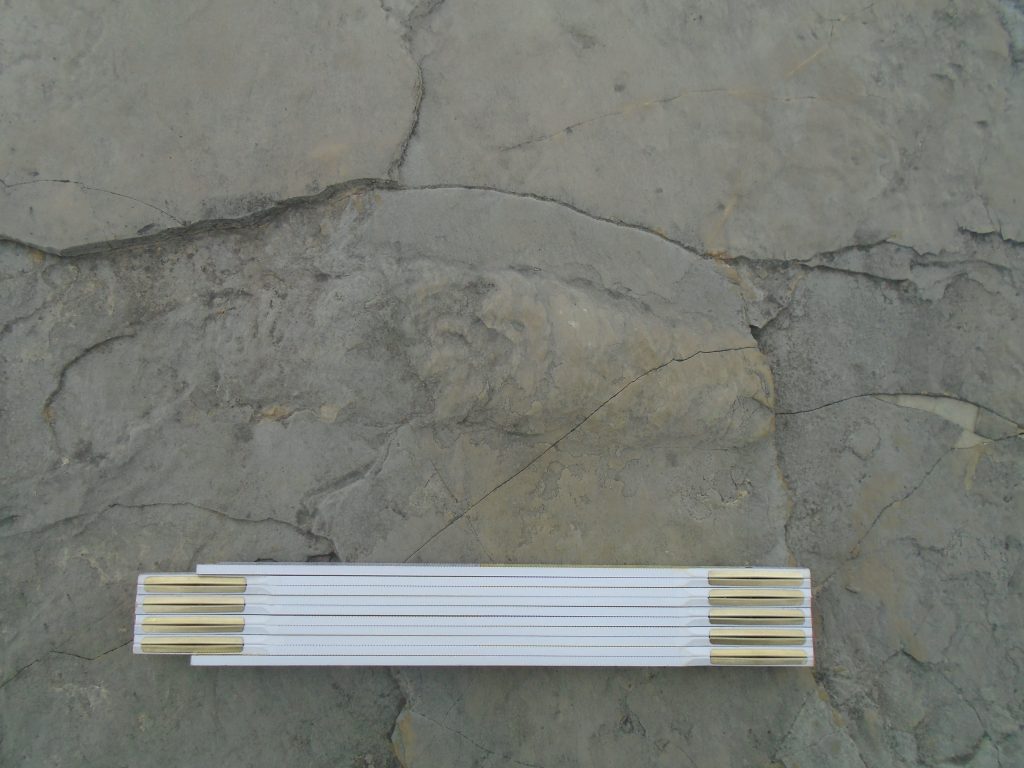
As the days wore on, we started to feel the physical effects of being in such a harsh environment. Lack of sleep, muscle aches, wet boots and equipment wear all started to take their toll.
When fossil hunting you’re forever sitting or kneeling down and getting back up again.This is normally fine, but the rocks here were all so weathered that I quickly started to put holes in my boots, trousers and coat. By the end of the first day hiking, I was horrified to see that the leather on the toes of my boots had been scuffed down to about 50% thickness in places. I couldn’t believe it and was so scared that I’d have actual holes in my boots by the end of the trip. Fortunately they held out!
Dave
Team review:
Emma:
Martin:
Anthony:
Dave:
Day 9: Anthony’s Birthday
Whilst we were in the field, it was Anthony’s birthday. Unfortunately for him, we treated it the same as any other day, but took the opportunity to walk to an entirely different river section many miles away. The map showed a large cliff section along the river and we knew that large vertebrate shields had been found towards the south of Read Bay, so we were hopeful for good finds. However, the rocks were completely barren of fossils, which felt like a wasted day, but helped contribute to our picture of the wider geological setting.
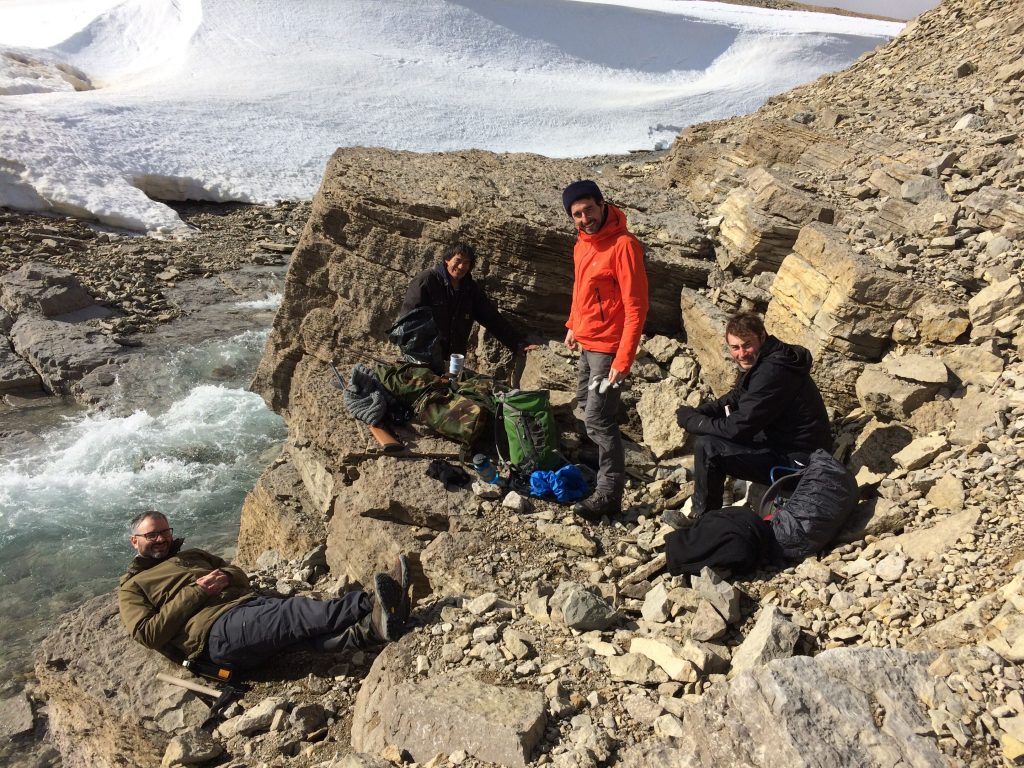
Once back at camp, we celebrated by firing some of the ammo that we could safely spare. We also has some sticky toffee pudding (in a bag) which was the culinary highlight of the trip. Emma was the only one to successfully hit her target.
Despite the lack of useful fossils in the section, the trek to a different part of the area, as well as experiencing just about all of the different weather conditions the Arctic had to throw at us, made this one of my more memorable field days. In the morning I was down to a t-shirt for the only time on the trip, making the most of the glorious sunshine, before snow showers blew in 20 minutes later! The hike also provided a very good excuse to have regular chocolate breaks on the way back.
Anthony
Day 10: Heterostracan Horizon
On day 10, we went to a section of the river that we believed would contain headshields of jawless fishes. Whilst these were not what we came to Cornwallis Island to find, they were still significant specimens for understanding jawless fish evolution. We even managed to find what Emma believed to be a new species!!
What was important about these fossils is that we found the in situ meaning that they were pulled directly out of the cliff, as opposed to finding them on the floor. This means that we can be certain of their geological setting, an important factor in understanding the habitat and ecology of a new species.
Day 10 was one of my favourite days, we had identified, from an old thesis, an area where we could potentially find ostracoderm headshields. We had scoped out this area earlier on in the trip, but the cliffs were steep and covered in large snow banks. Now, on our return, the snow had melted and we were a lot more experienced at navigating such steep descents. Not far from the top of the valley, we started to spot creamy-pink bone and soon found a potential 3D articulated anchipteraspid (a group within the jawless heterostracans). This spurred us on to search the area extensively and just before lunch, Anthony showed me a really interesting specimen that was a large fragment of shield. The ornament on his specimen looked like the problematic heterostracan Lepidaspis and I wasted no time in getting Anthony to show me the scree slope where he found the specimen. I then decided to climb and look for the horizon it must have fallen from and after about half an hour search, I looked at the underside of a large slab and to my amazement found many headshields. I called over the other guys and we began carefully excavating the site, by progressively lifting off rock, layer by layer. We found many beautiful specimens that revealed the high diversity of jawless vertebrates at this site. In our excitement, the day had slipped away from us and we had to return to camp. However, just as were about to leave, we hit upon a concretion layer and started finding eurypterids, so decided to explore these a bit further. It was in these layers that we found a new jawless vertebrate species belonging to new family. Its anatomy is very unusual and I will be very interested to include this new data into a phylogenetic analysis and see where it’s positioned in the early vertebrate tree of life.
Emma
Whilst today was very exciting for Emma, it was also very exciting for me – I finally found some fish fossils! At the start of the trip I thought I had a pretty good eye, so finding fish bits would be a piece of cake, but it very quickly turned out I was a lot less good at finding fossils than I thought I was. I spent the first week bringing things to Martin, Emma and Dave only to be turned away with a sad smile (“sorry Anthony, that’s just another bit of crinoid”), but at last the abundance of material at this site meant that I managed to find some bone!
Anthony
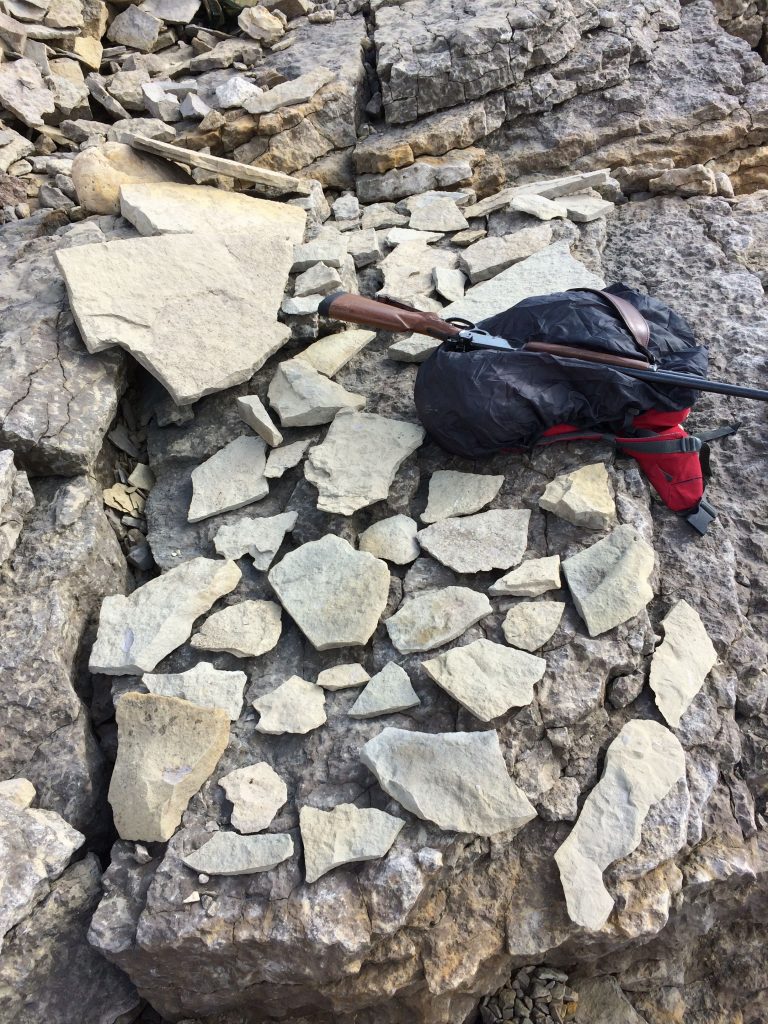
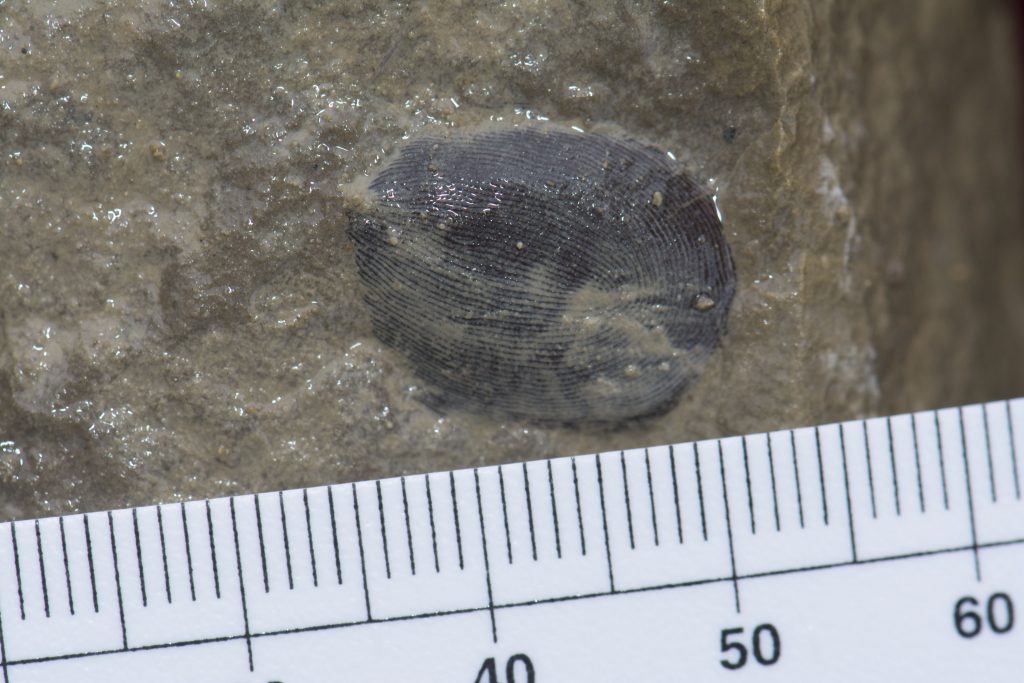
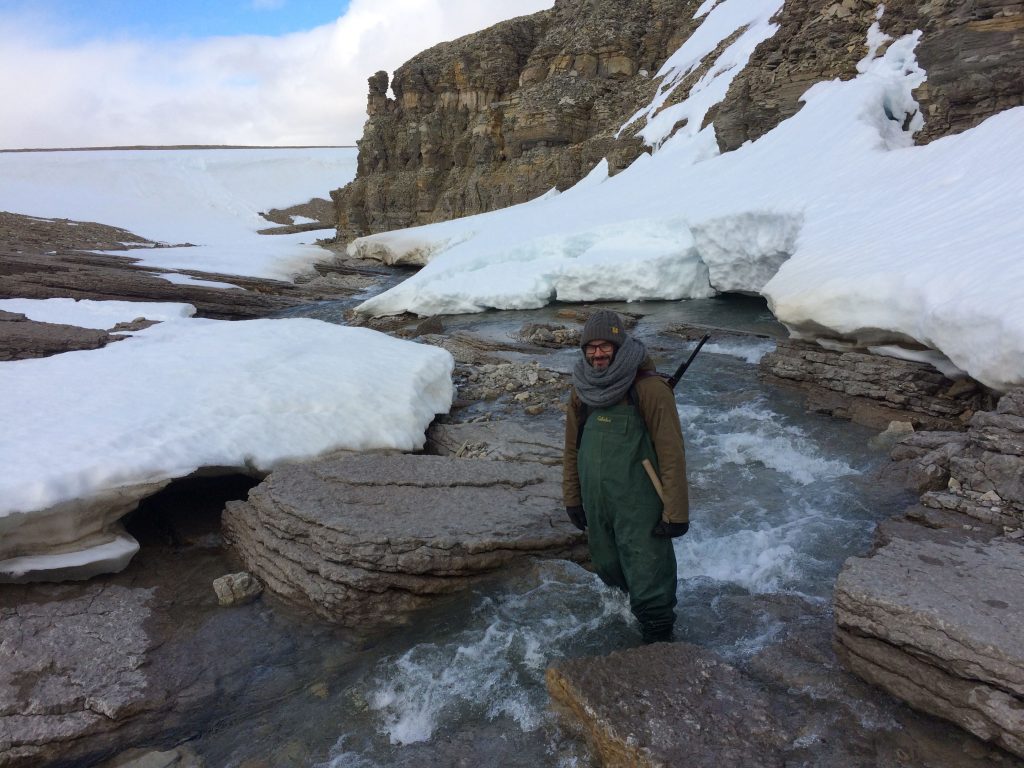
Day 12: Joining us in the field
Day 13: North Read Bay
The day finally came where, after days of constant bothering, we were finally allowed to go to the North Shore of Read Bay, into the much younger Devonian rocks, where some eurypterids had previously been found. It was a beautiful day, with temperatures rising towards 10 degrees, which wasn’t a lot, but made a whole lot of difference. We were all fairly excited and the whole day felt a bit like a holiday.
Dave
The journey to the North shore of Read Bay was different to that of all the other days; since we were walking around the coast, the terrain was all flat, but we did have to cross a lot of big rivers which flowed our into the bay. We didn’t know if it would be possible to cross them in our waders, but fortunately they thinned out into braided streams and we were able to pick our way across fairly easily.
The walk took us right next to the sea ice, at times, even walking over the ice. This provided us with the extra risks of walking onto thin ice, but also some of the small icebergs washed up onshore could be concealing a polar bear. Since the bears most frequently use the beaches as highways, we had to be extra vigilant whilst we walked.
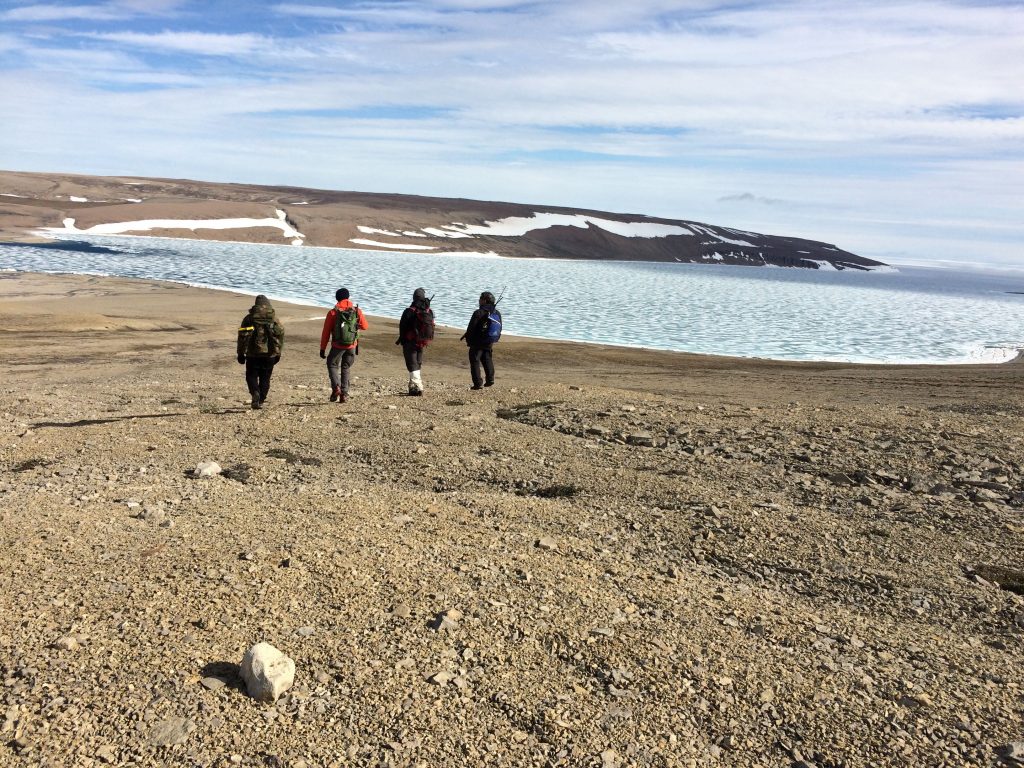
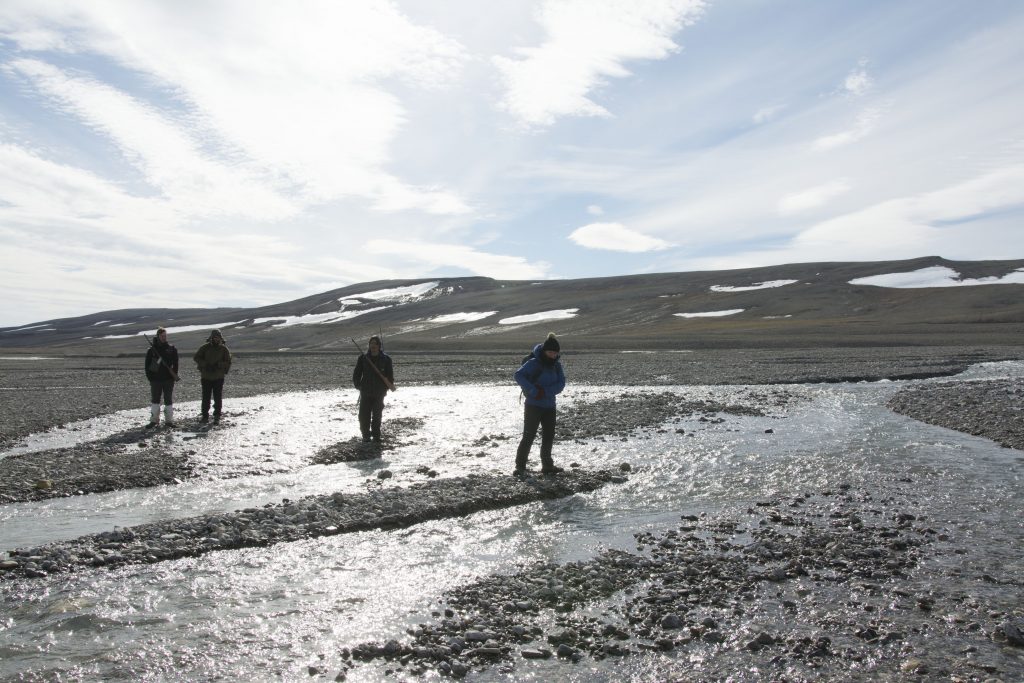
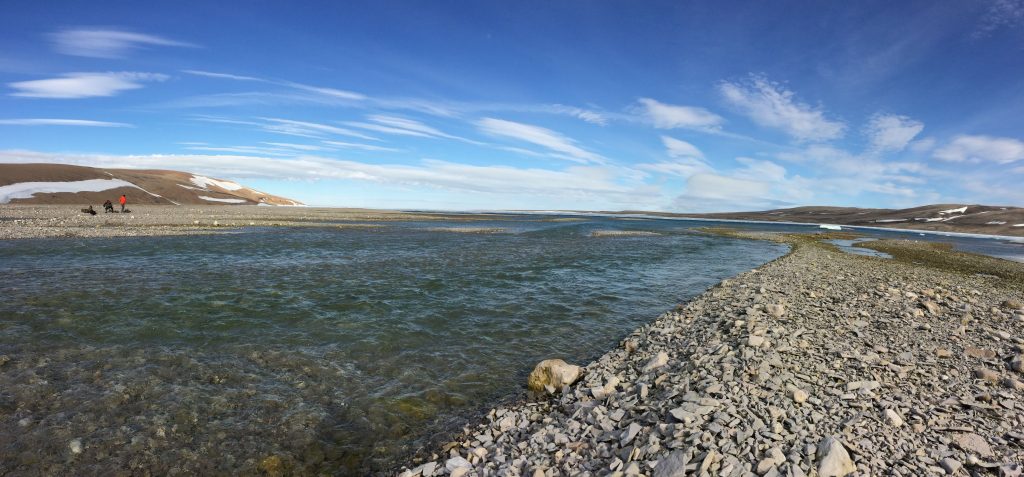
-
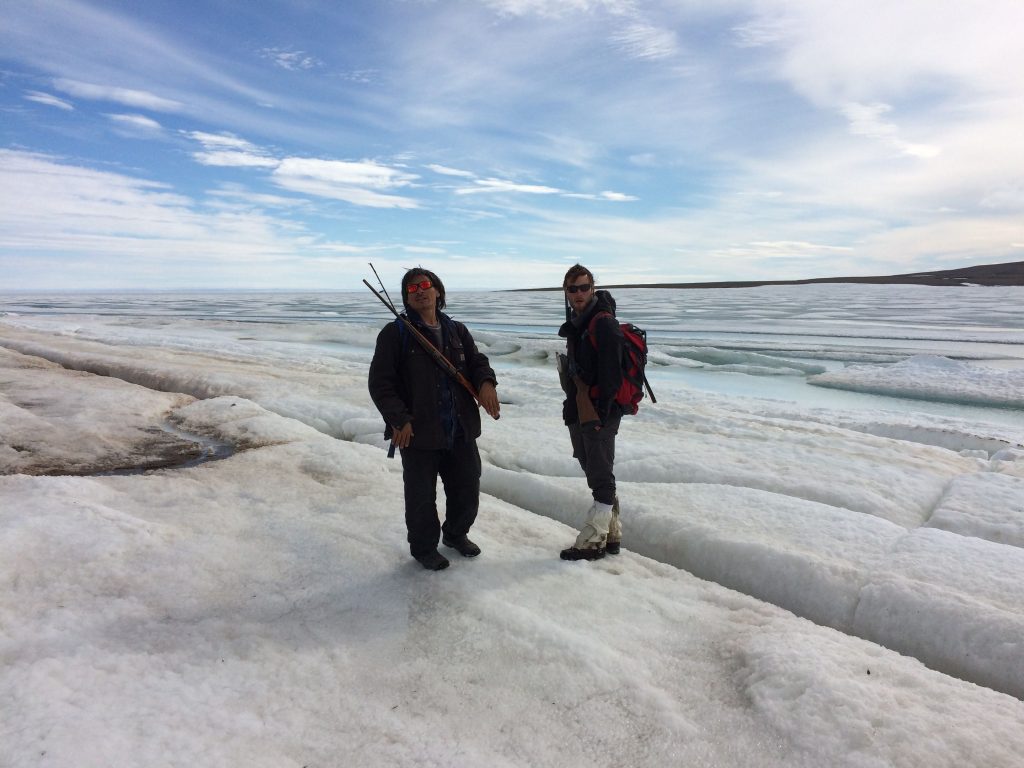
And sometimes we had to walk on the frozen sea ice. -
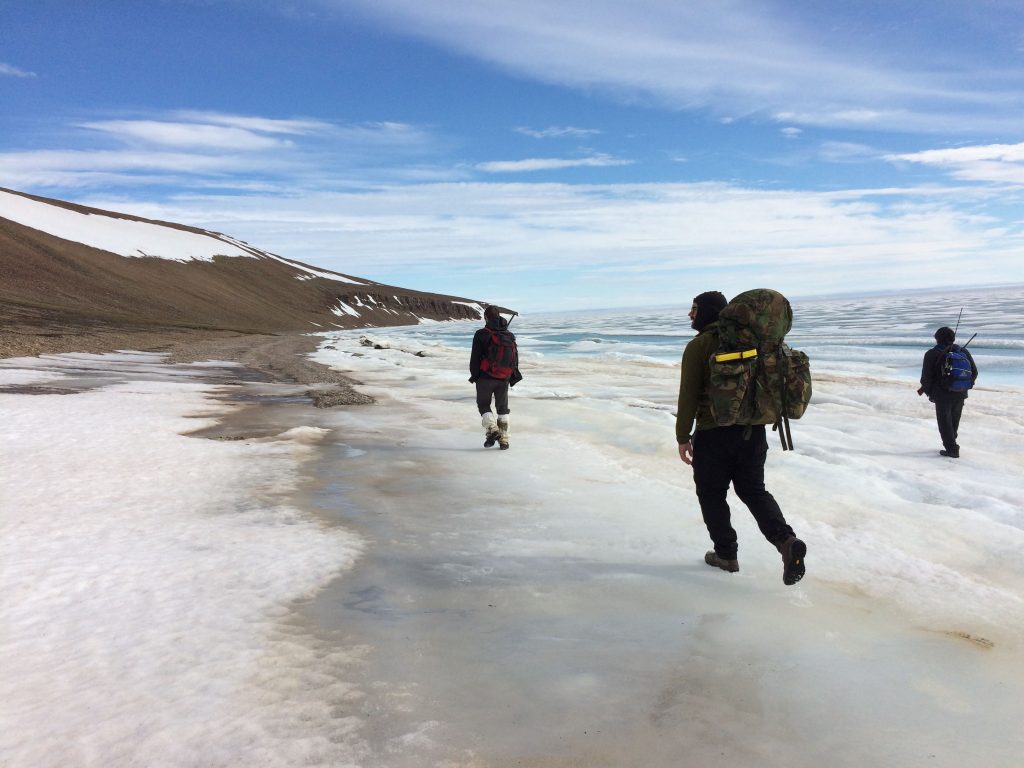
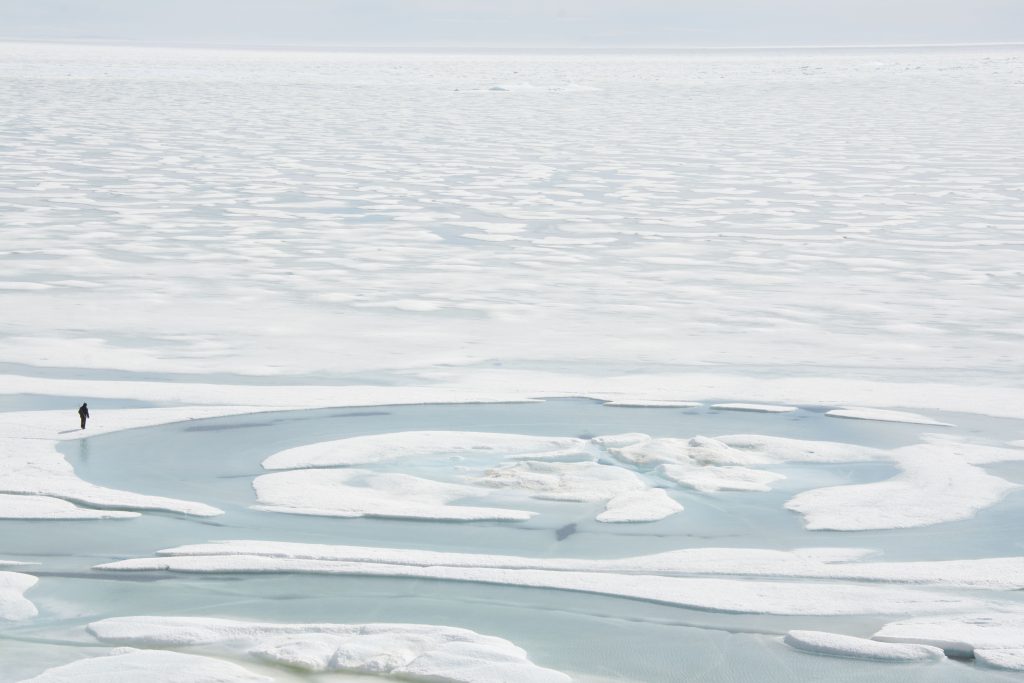
The rocks we were viewing belonged to the Snowblind Bay Formation and are Lochkovian, Lower Devonian in age. They were obviously a different colour and were a lot more resilient to weathering. They broke up into giant slabs that created a very steep and precarious scree slope punctuated with small cliffs and drop-offs.
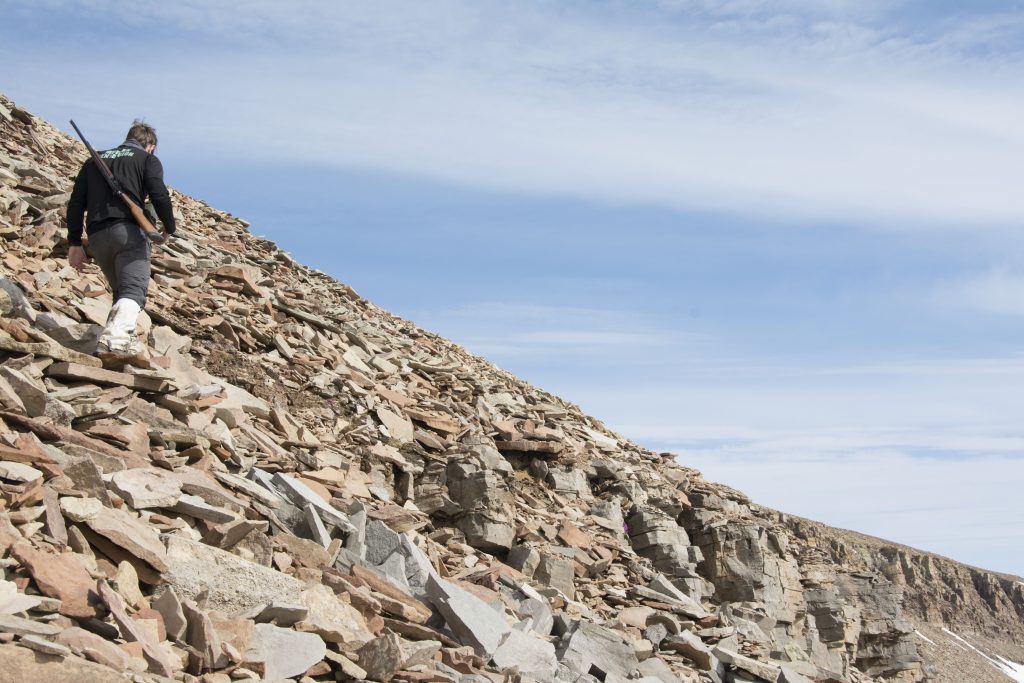
I don’t think I have ever been so keen to find a fossil. I knew that that at this locality you could find a eurypterid so rare that you could count the number of good specimens with one finger!
It was interesting to see how the others, who had such a keen eye for fish fragments, didn’t really have an eye for spotting arthropods. So I spent a lot of time being called over to look at weird sedimentary artefacts before I actually found an actual eurypterid specimen.
It was very small, around 15 cm, which is interesting considering the other specimen found there were was about a meter long. It clearly was a stylonurid eurypterid (one with an extra walking leg, opposed to a swimming paddle), which are much rarer than their swimming counterparts. I was surprised at just how long its walking leg actually was, since it extends back further than the end of its postabdomen.
Stylonurid eurypterids aren’t my speciality, but here I knew that such a small specimen had never been seen before. It was either going to be a juvenile specimen, an already-known species in a new location, or an entirely new species altogether. Whatever it turns out to be, it’s scientifically significant!
I also found a partial abdomen of another, much larger, specimen. This was much more like the holotype (the first-described specimen of a species which ‘defines’ the characteristics of the species) of Pagea plotnicki which had been found at this location.
Dave
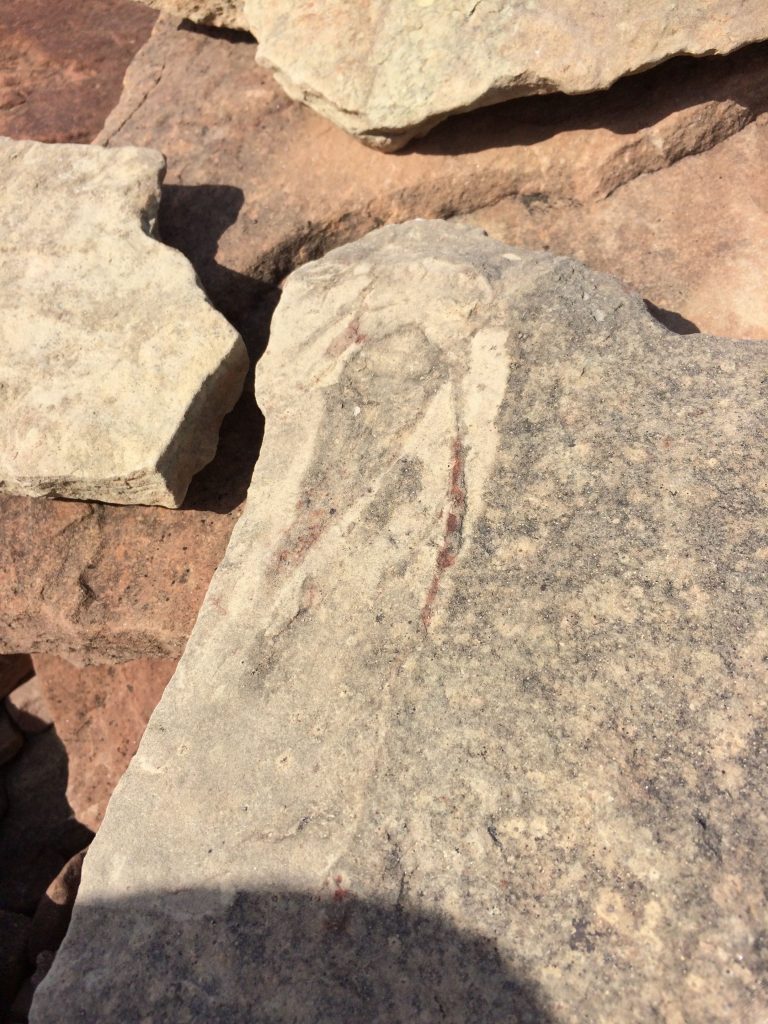
Euryprerids weren’t the only fossils at this location, we also found many jawed and jawless fish fragments. The earliest known examples of Pteraspididiformes (a group within the jawless heterostracans) are known the from Canadian Arctic and some are found in the Snowblind Bay Formation (Elliott 1983). This includes Anchipteraspis, Stegobranchiaspis and Unarkaspis, the latter of which we think is seen in picture below (Dave Elliott pers comm). We also found remains of problematic heterostracans and porolepiforms (a type of lobe-finned fish), however, many of these were in fragmentary, heavily weathered or in large blocks of rock, which we couldn’t transport back to camp.
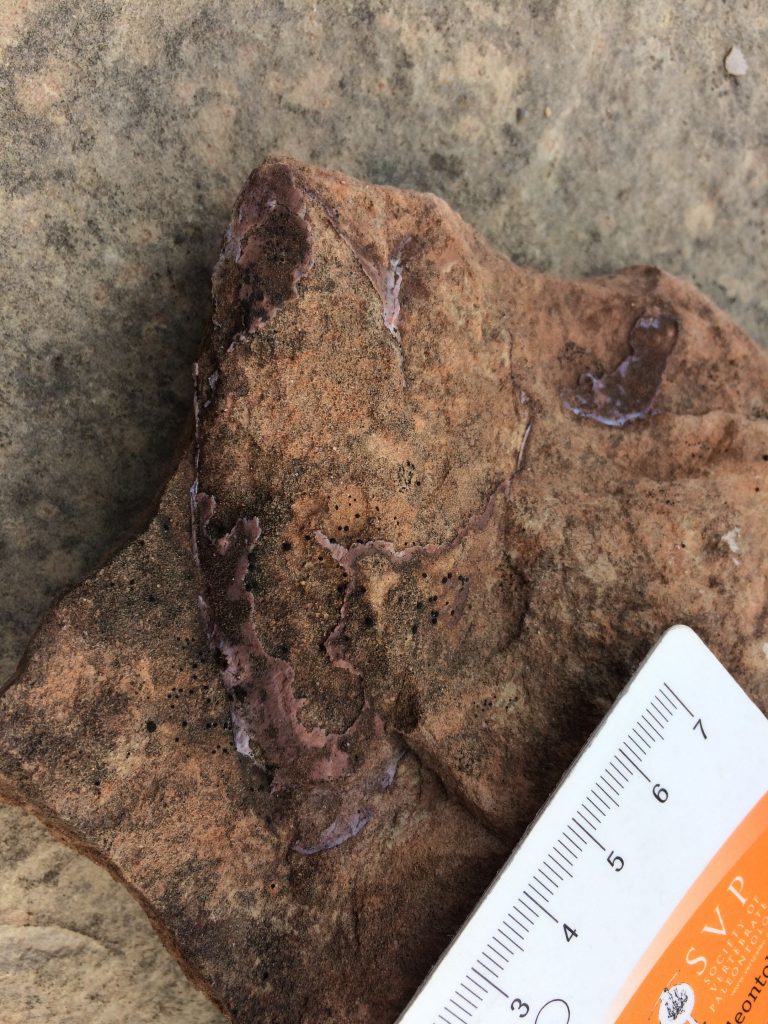
The return to PCSP
We then received some bad news, there had been an accident on the island, with some members of the small and closely-knit community having lost their lives. It was decided that we would head back to the PCSP research station early, to allow Randy time to be amongst his friends and family.
Whilst we were on standby for a helicopter pickup, we had to be ready to leave the field at a moment’s notice. This meant that we couldn’t stray far from our camp site, so fieldwork was off the cards. We decided, however, to go for a stroll to the peninsula overlooking Read Bay and it was from this viewpoint we saw our first (and only) polar bear. This terrifying little white dot just slowly moved around the horizon, occasionally stopping to survey the landscape. You’d be forgiven for not having spotted it, but Randy’s sharp and trained eyes spotted it pretty quickly. He informed us that if we’ve managed to spot it, it probably would already been aware of our presence long before. Comforting.
Finally seeing a polar bear was both amazing and terrifying in equal measures. Polar bears are beautifully iconic and majestic creatures, but they are also the reason we had to carry guns with us our whole trip. Much of the logistics of our trip centred around polar bear safety, including; rifle training, logistics of getting the rifles to the Arctic via airplanes, setting up our communal tent away from our sleeping tents, not having anything that could produce a smell in our sleeping tents, including toiletries and toothpaste, setting up two different perimeters around our tents and carrying guns absolutely everywhere… even to the toilet. We had guns with us that day and it was amazing to see how fast the polar bear moved, even at such a great distance away. However, this polar bear looked incredibly healthy and was moving in between a herd of muskox, it seemed he was simply passing through and not on the hunt. This was a relief and enabled me to relax, and enjoy seeing one of the most iconic animals on the planet in its natural environment.
Emma
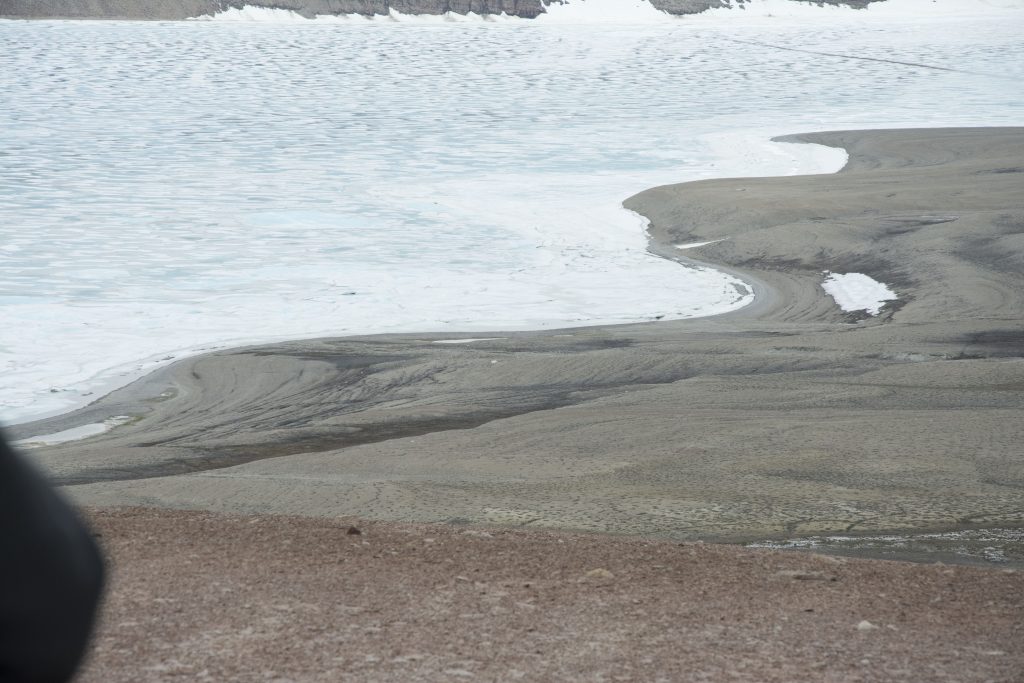
Back at the PCSP, we had to deal with the fact that our trip might very well be over since we couldn’t be certain that the weather would permit a trip to our second field site. After just a few days of waiting, we’d be eating well into Martin’s research budget with nothing to show for it. The decision was taken to book flights home if we didn’t make it to the field within 3 days. Delay after delay saw two days pass whilst the snow fell, wind blew and fog rolled in and out.
Whilst waiting, we were able to have showers for the first time in two weeks, catch up on sleep, wash our clothes and eat our weight in hot food. We also were able to log some of our fossil discoveries and had to re-pack a lot of our equipment for headed back out.
Although, we were all really sad to return to the research station and have our trip cut short, in some ways I was kind of relieved. After just over two weeks in the field my body was feeling the toll. Due to the constant climbing up and down hills and walking on hard, uneven ground, and most likely slightly ill-tied boots, I had constant pain in my feet. This resulted in me having disrupted sleep, often waking up to take pain killers, and found walking increasingly hard. Many of us had “Christmas Toe”, which is a loss of sensation, especially in the big toe, due to cold conditions and the constant pressure we were exerting on them. This occurred despite most days wearing 3 pairs of socks. It was also a relief to have a shower and be able to wash our clothes. However, it also made the thought of the return trip daunting, as I was worried I would be in too much pain to participate in field work. Luckily, the few bootless rest days were enough to relieve most of the pain. However, it took several months before the feeling returned to my big toes.
Emma
Along came the final day and there was dense fog around the research base, so all seemed over. But never trust the weather in the arctic. At our proposed campsite at Laura Lakes, the weather was crystal clear and as soon as the fog dissipated at the PCSP, we got the all clear and we were able to head back out.
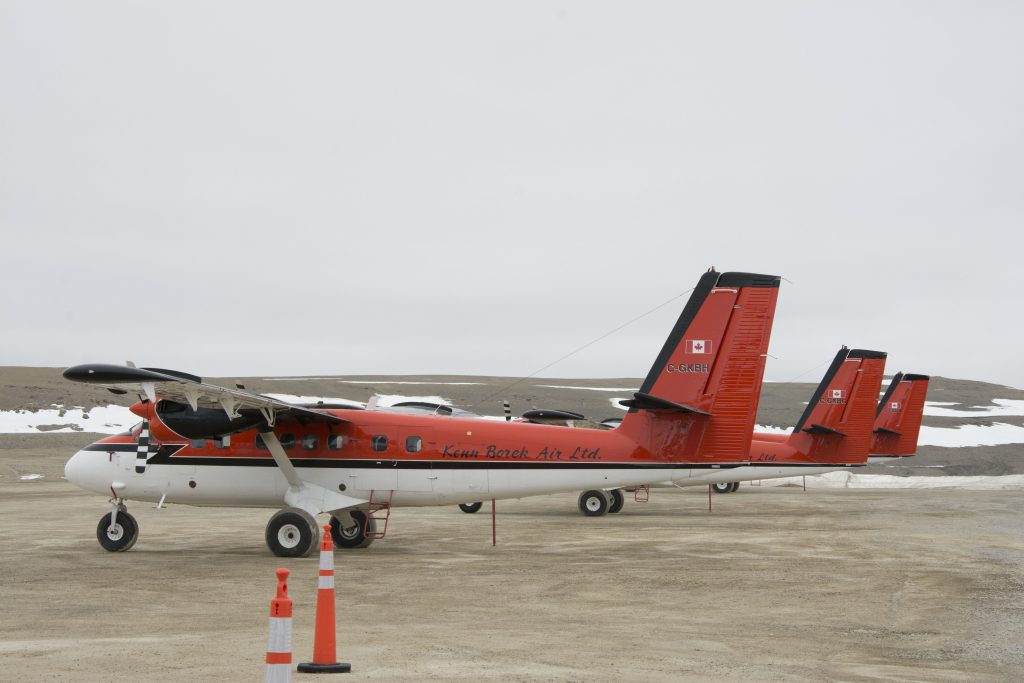
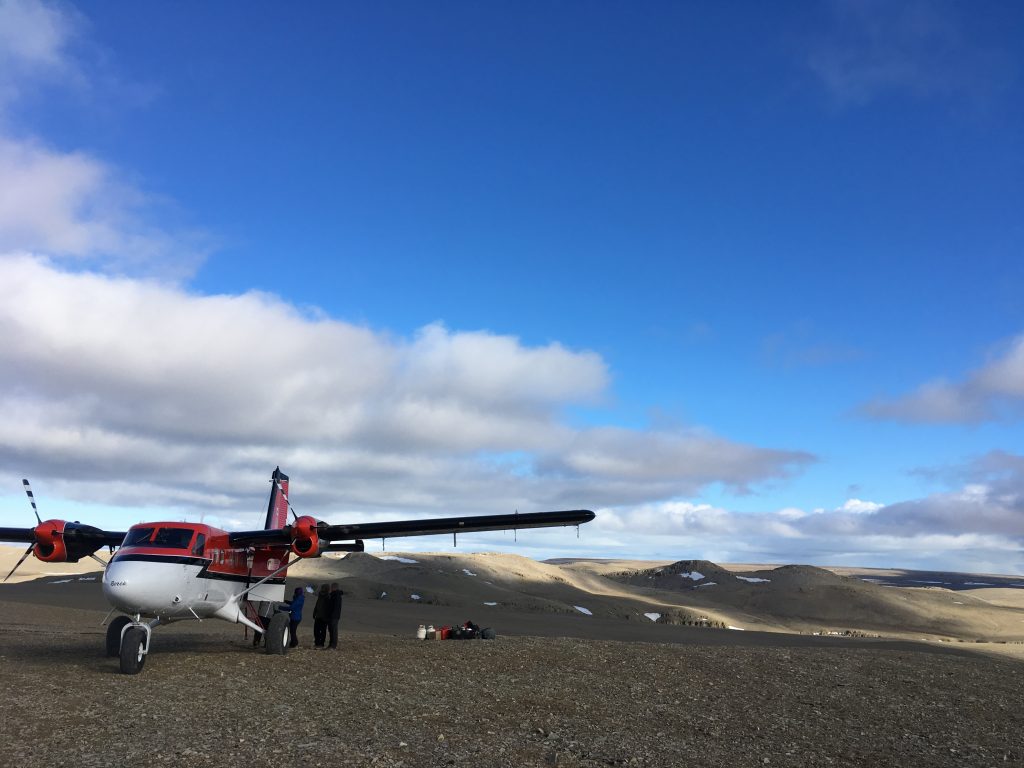
Randy didn’t join us on the plane, but instead make the long drive on his quad bike. This took him 12 hours, four of which he spent trying to free his bike from soft mud. The benefit of doing this was that we would have logistical support out in the field to move equipment and any heavy rocks.
Fieldsite 2: Laura Lakes
The Laura Lakes were to the North of our camp at Read Bay. Here we sampled rocks belonging to the Cape Phillips Formation which were slightly older than the rocks of the Barlow Inlet Formation we had sampled on the first stint. The Cape Philips Formation rocks are predominantly carbonate shales preserving sediments from a basinal offshore facies aged from the Katian (Upper Ordovician) to the Pridoli (Upper Silurian). The age of the rocks are well constrained by conodonts and graptolites preserved within them. Not many vertebrate specimens have been published on from the Cape Phillips Formation but we knew that many articulate and whole specimens of jawless vertebrates have been found within the Cape Phillips Formation from mentions in publications, with Thorsteinsson having found a quarry of well preserved specimens.
Similarly to the Read Bay locality, Laura Lakes was barren of vegetation, meaning there was much rock exposure for us to explore. We started by heading towards the lake and followed a small stream section with lots of exposure. However, the rocks were not tilted like they were at Read Bay and for a lot of the section we were walking along the strike, meaning we were looking at rocks belonging to the same bed. After a few days of searching rocks in various localities to the east and north of camp we were pretty unsuccessful at finding fossils, bar some tantalising fragments of acanthodian.
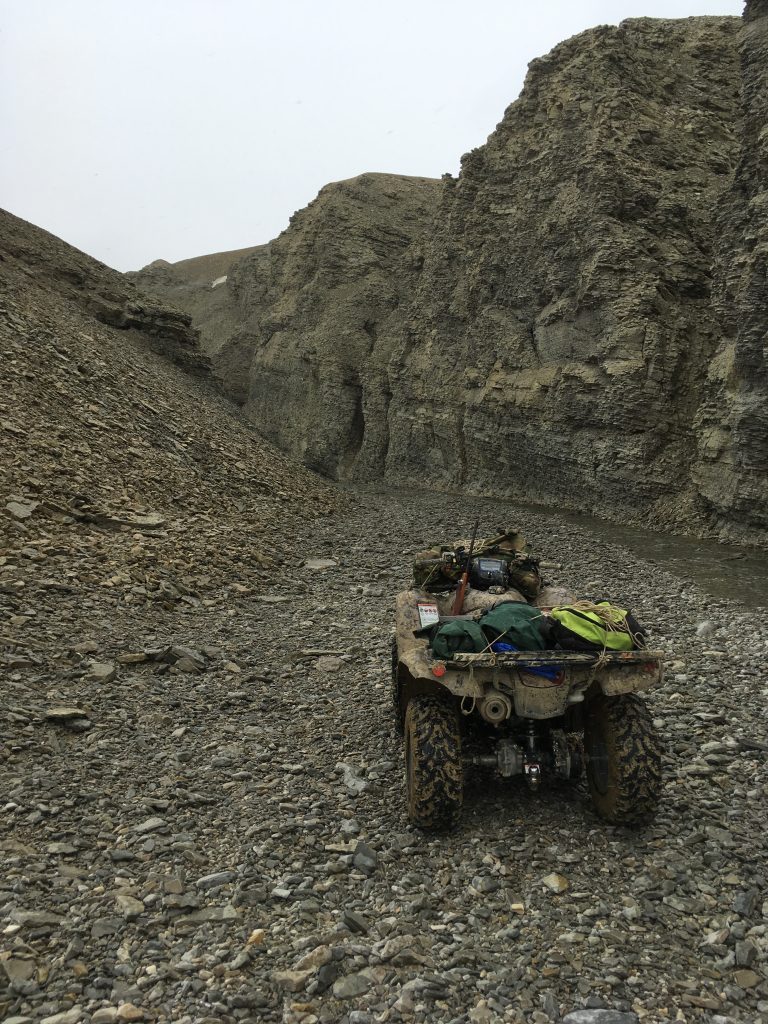
Following the stream down to the lake, we encountered a small reminder that people did live on the island: a small fishing shack. Unfortunately for the owner, a polar bear had taken a great interest in the shack and had torn the roof off, still it provided the best shelter of the trip, allowing us to have lunch in relative comfort for once.
It soon began snowing, visibility drastically dropped and we were forced to return back to camp. Whilst the snow wasn’t particularly deep, we couldn’t know if it would get any worse, so we could afford to be far from camp. The snow fell for a few days on and off which meant we couldn’t get out into the field, with not much to do except read, play games or sleep. Sitting in camp and not moving around much meant we got cold very quickly. Luckily we had enough gas in our cooking stoves to heat our communal tent a bit but some of us had to resort to climbing into our sleeping bags to keep warm.
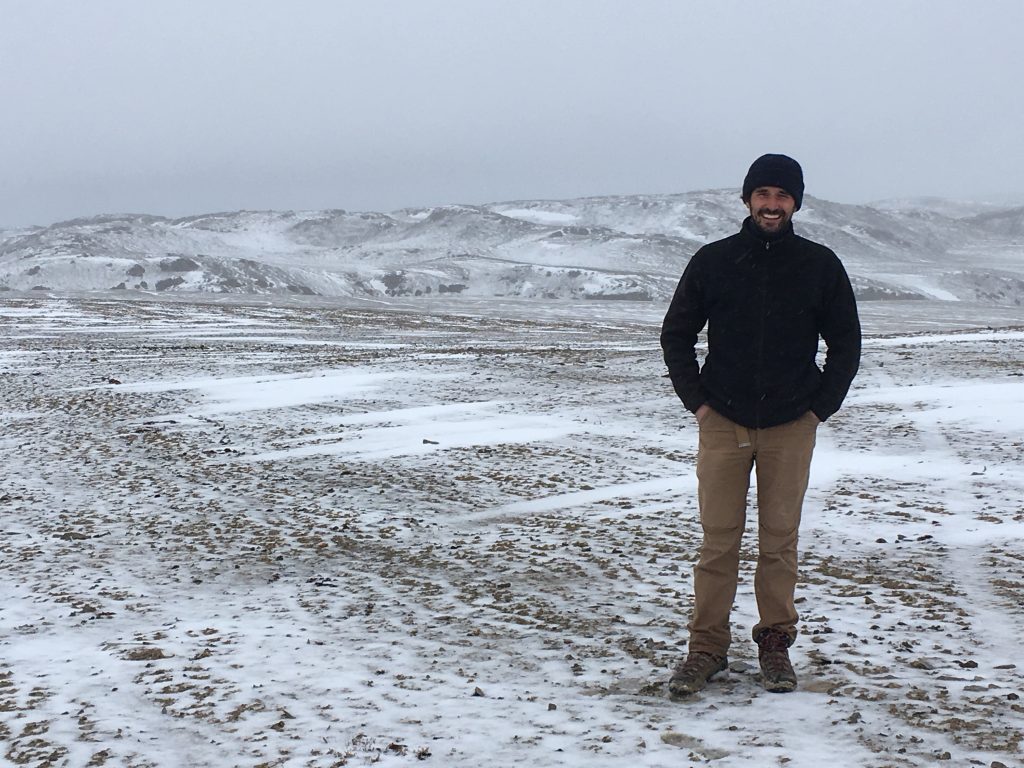
In the communal tent, we were able to make friends with a particularly tame lemming, who found warmth, shelter and food in our company. We named it Laura Lakes.
Despite exploring several kilometers of exposure, we often returned to camp empty handed. It felt as if we were destined to have no luck in this part of the island. Around half the way through our stay at Laura Lakes, Martin decided we should prospect in rocks to the south of our field camp and we headed for a large escarpment entering the drainage area of Snowblind Creek, which fed into Laura Lakes.
These rocks were different from the carbonate beds we had been searching on the previous days, and were much muddier. In these were shales and we soon started finding graptolites, orthocones, brachiopods and other invertebrate fossils. One horizon within the shales were of particular interest. Here, the rocks were almost black and the smell of oil hung in the air.
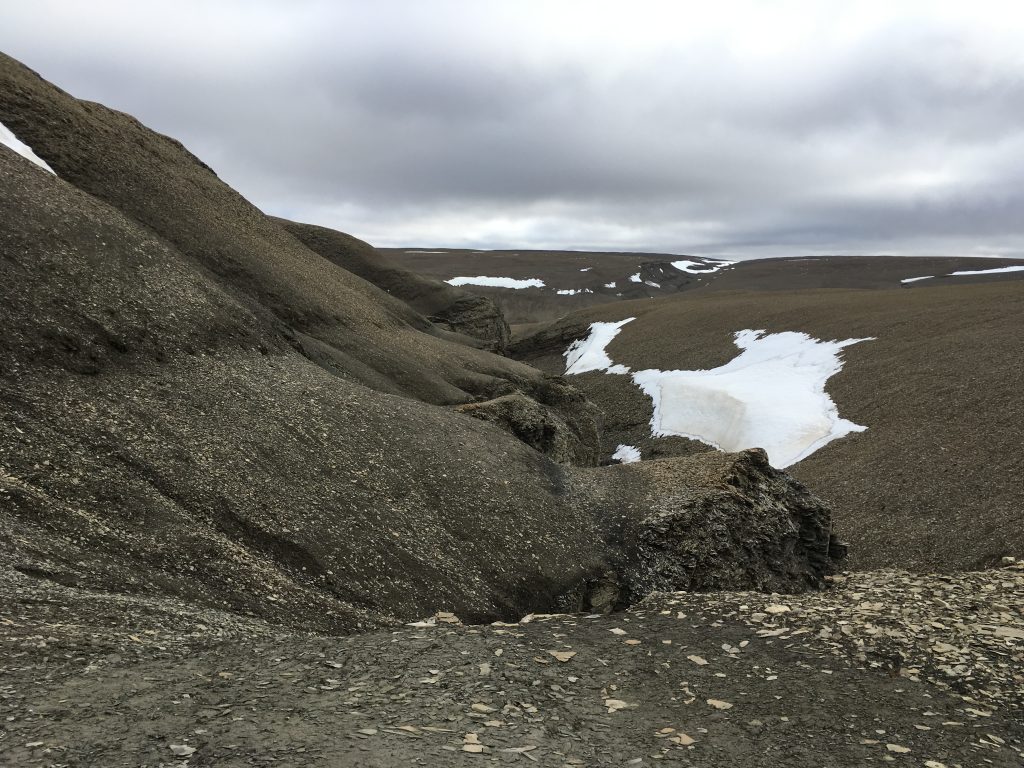
Whilst exploring for fossils, I started to notice some black slime moulds growing on the surface of the rock. The layers of rock weren’t far from horizontal and these patches of slime were draped over the edge of the rock faces, almost vertically. I hadn’t seen any of these anywhere else on the island so I found them pretty interesting. On close inspection, they had some regularly-spaced textures to them, which looked like tiny raised bumps. This didn’t really make any sense as to how something made of such microscopic elements could produce a macroscopic texture. I remember smirking and thinking to myself that it was so typical of me to recognise eurypterid-like patterns on an amorphous rubbery patch of slime. The wind was pretty strong here and before I knew it, whoosh, the slime I’d picked up was gone.
I continued digging at another site where the rocks were at their blackest and started pulling out some interesting shapes.
Occasionally, as I worked my way through the rock, I would encounter some large black spines, around 3cm in length. These were huge and whatever animal they came off must have been even bigger. Interestingly, as the part and counterpart of the rock split, the spine would be dislodged from its original position. This meant that it wasn’t actually stuck to or part of either rock, but was still sandwiched between layers even after 400 million years!! What’s more is that the spines were flexible, not hard and brittle as you might expect a fossil to be. I had, at first, thought these were some of the spines from the front of a eurypterid, but after discussions back at home, they could in fact be the jaws of chaetognaths (giant worms)!
Next, I found what I had been hoping to find for the entirety of the trip: eurypterid cuticle.
Now, this wasn’t just any cuticle, but like the chaetognath jaws, was dark, flexible and not fully attached to the rock. Splitting part from counterpart again displaced the cuticle, sometimes even bridging the gap between the two sides of the rock as it was split. This absolutely blew me away that I could be so lucky to find such large and well-preserved fragments of eurypterid.
Unfortunately, it was at this time that I realised that the slimy patches I had found before, were indeed eurypterid cuticle that had weathered out of the rock and lay on the bare surface. The chances of finding that exact scenario are absolutely miniscule.
In a similar fashion to the slimy cuticle previously found, my new cuticles had a tendency to blow straight off the rock, however, I was better prepared this time and was able to chase it down and place it directly into some small plastic zip lock bags I had brought with me.
As time passed at Snowblind Creek, we started pulling out more and more pieces of eurypterid, but we were limited for time and so had to leave. I was happy to have found these amazing fossils, but so disappointed that our schedule meant that we wouldn’t be revising a site that held so much potential.
Dave
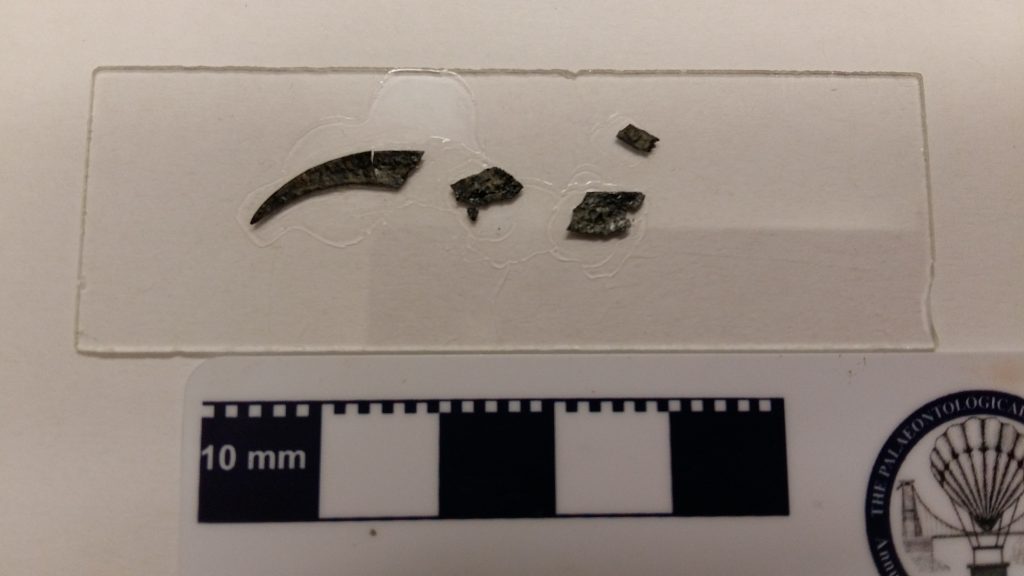
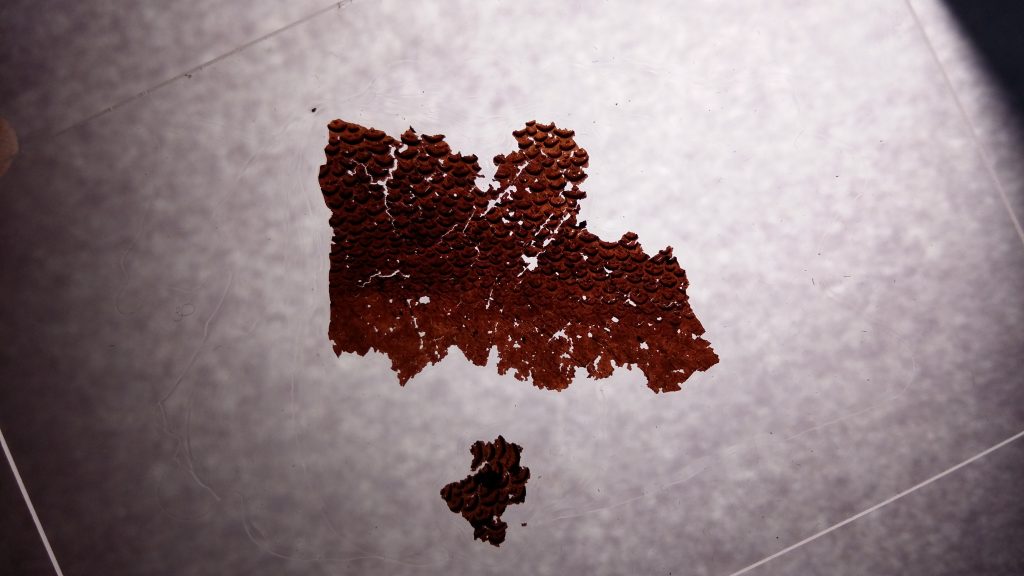
It was great to see Dave getting excited about the eurypterid cuticles, and we were happy he had found specimens that would be useful for his PhD project, especially as he had found so many great vertebrate fossils. As the day wore on at the eurypterid locality I began to get cold, as we were mainly sitting on frozen mud and shale. As I started to move around (whilst on field work you can’t help but keep your eyes peeled to the ground on the lookout for tantalising and often elusive fragments of fossil), I found some absolutely tiny fragments of heterostracan bone- our first at the Laura Lakes locality, but these were in a mudslide and we couldn’t locate the horizon they had come from. But now we had evidence that somewhere at this locality were vertebrate fossils.
Emma
Over the subsequent days we visited other localities mainly to the north of camp, but without much success. This was a really disappointing way to end our time in the field. It would have been nice to have gone out with a huge haul of either eurypterids or fish, at least exploring those last few days helped build a picture of where fossils were and weren’t in the Cape Phillips Formation. This would provide vital information should we ever go back into the field.
On the day we were due to return back to the PCSP research station fog had rolled in and we were again left waiting on news as to whether or not we would be able to leave the field that day or not.
Learning that we might be delayed got me so excited because I knew that if there was the slightest window to go out into the field, I could potentially convince everyone to go back to Snowblind Creek to look for more eurypterids. My interests were entirely selfish and I don’t think I was subtle about my desire to go back into the field.
Eventually, the news came that the plane wouldn’t be coming that day and we were granted one last trip out to the only place we’d had any luck this second part of the trip. I was ecstatic and orchestrated my transport via quad bike to maximise my time at the outcrop.
Dave
On Dave’s insistence we returned to his eurypterid locality to the south of our camp. However, this time Martin, Anthony and myself decided to explore in a different direction – to the west, leaving PJ and Randy to excavate the eurypterid site with Dave. Only a few minutes after we began prospecting, Anthony found a pretty large (10+cm) blue fragment of bone, which on closer examination was revealed to be a Cyathaspid (type of jawless heterostracan). This was really exciting, as we were in rocks of Ludlow age (Middle Silurian), which is generally depauperate of vertebrate fossils, and the fossil was also quite large. We then began to scout the area attempting to locate the beds it came from. We found more and more of this blue heterostracan bone and after a while of searching we located the in situ horizon the fossils were preserved within. It was another black shale, which was not the rock we expected to find vertebrate fossils in. The shales were jam packed with invertebrate fossils, such as orthocones and brachiopods, and preserved all these in a black, greyish colour. This meant the blue fossils we were finding were the fossils that had been exposed to the elements and had turned blue due to weathering. The diversity of heterostracan vertebrates at this locality was high and we believe we have a few new taxa.
Emma
Overall, I feel bad about how I acted that day; my self-interest was poorly masked and I had taken the liberty of assuming the rest of the team would support my cause and be understanding of my methods. My second time at the site saw frantic collecting with little concern of others or myself; all that mattered was recovering as many samples as possible.
For me, the ends justified the means and I was able to collect over 80 specimens in total, including exquisitely-preserved patches of cuticle, which upon close examination back at home, revealed some incredible 3D detail. I even managed to get some large fragments with distinct morphology, such as swimming paddles, coxae and chelicerae. These all seemed to be from the giant pterygotid eurypterids, which are fairly common in the Silurian, but rarely preserved so well. These will undoubtedly for a huge part of my research going forward.
I think that Snowblind Creek could prove to be amongst the best site for eurypterids in the world and still has huge amounts to offer. It would definitely benefit from weeks at the site, as opposed to just a hours. Who knows how many new species we could find there and what the rare members of this assemblage would be!
Dave
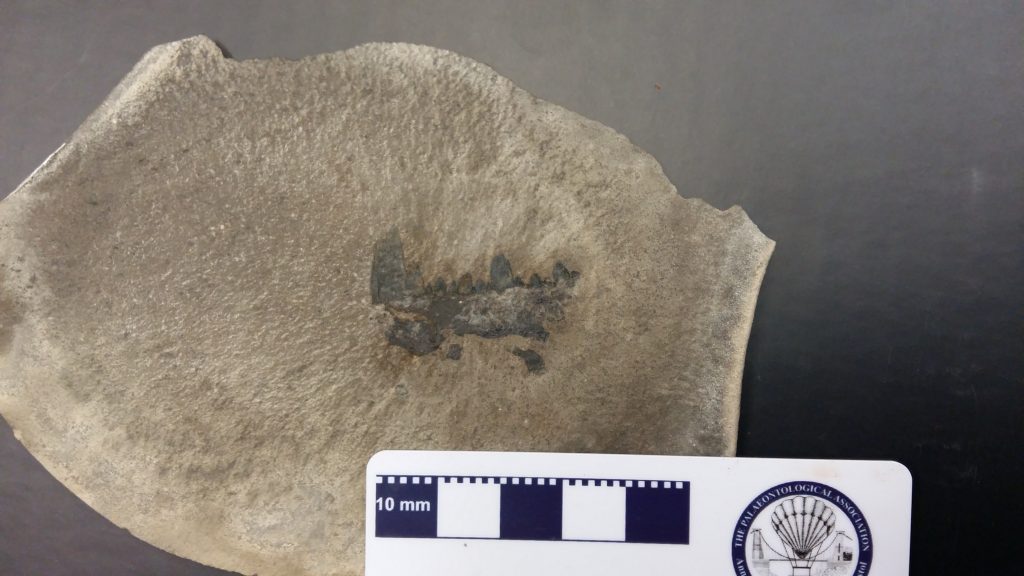
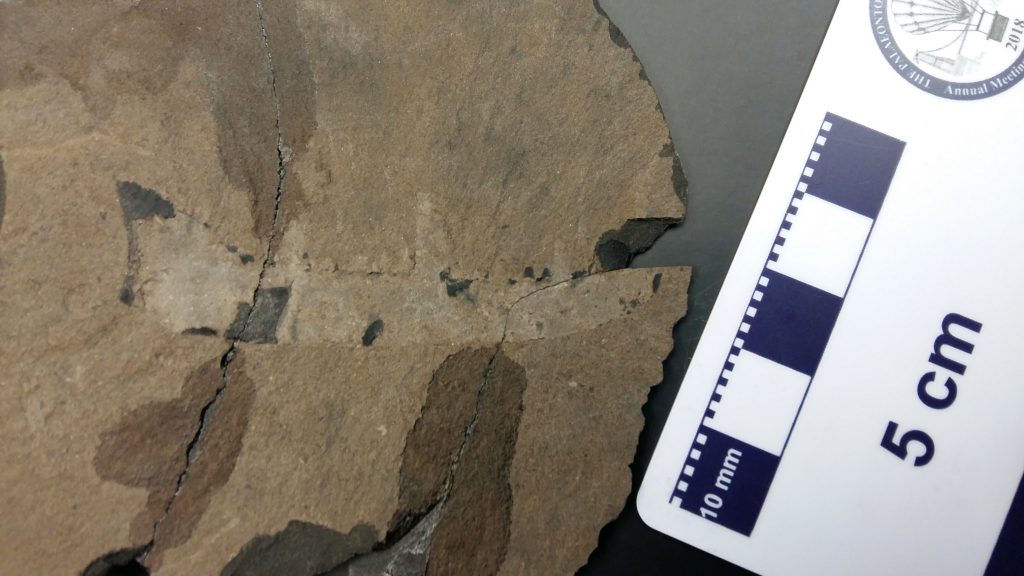
The fishes at this site were really excellent, too! The challenge was that much of the bed was under cover. The fish-bearing beds were less resistant and caked over in mud or covered in talus. It was really lucky that Anthony spotted what he did! The quality of preservation here was pretty incredible, enabled by the finely laminated beds the fossils were preserved in. I regret that this was our last day, as it would have been really good to excavate this site. The potential for really excellent, perhaps articulated fossils is there.
Martin
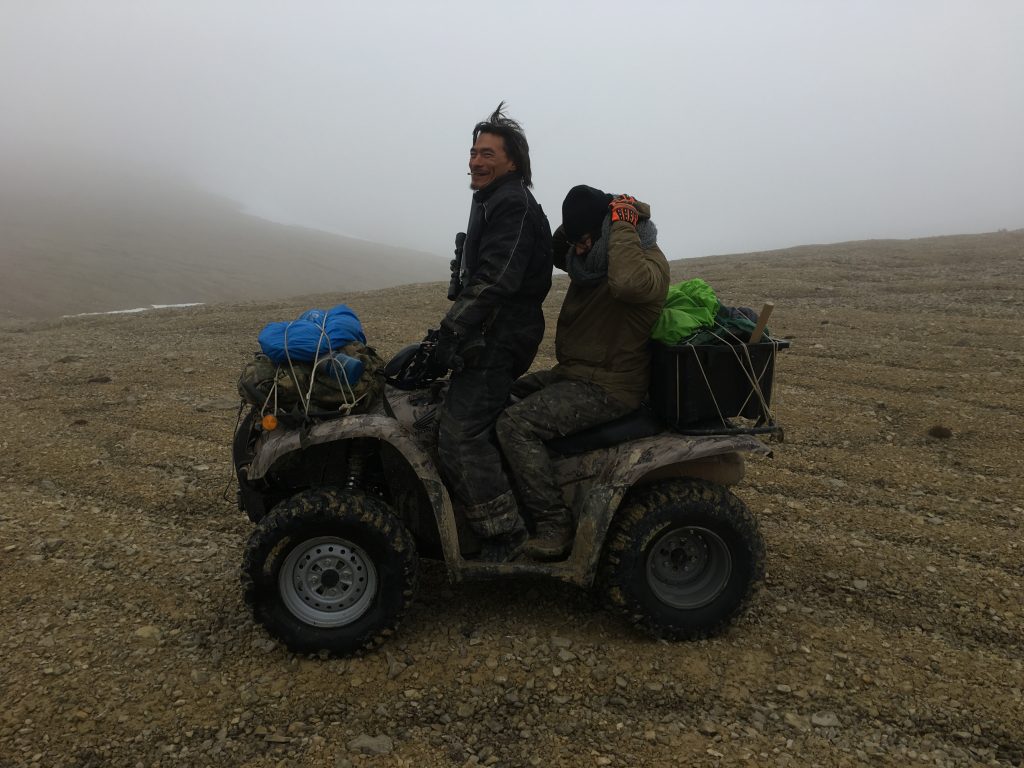
Return home
The next morning, we were still unsure whether or not we would be able to leave the field or not, but a quick radio check with the PCSP revealed that the plane to pick us up was already en route and would be arriving in 15 minutes! This had Martin sprinting over and waking the rest of us up in a frenzy! We then had to break down our entire camp and the freezing rain and wind. This was by far the coldest any of us had been on the trip and our teamwork was tested to the max as we all tried to direct our collective panic.
(Laura Lakes had her nest safely moved and positioned in a quiet and sheltered spot)
With a fair amount of help from the pilot and co-pilot, we were back in the PCSP before any of us really had a chance to wake up. After some food and the longest, hottest showers imaginable, we had to work on cleaning all our loaned equipment and preparing to head back to Ottawa.
To take the fossils off the island, they had to be officially accessioned by the Canadian Museum of Nature until which time the Nunavut Territory would be able to house them in their own museum. They would be then be loaned back to us to research upon. This meant that all the fossils had to be properly catalogued and boxed up before we left the PCSP the next morning. This resulted in just a couple of hours in bed for Dave who was up late cataloguing his massive haul of specimens.
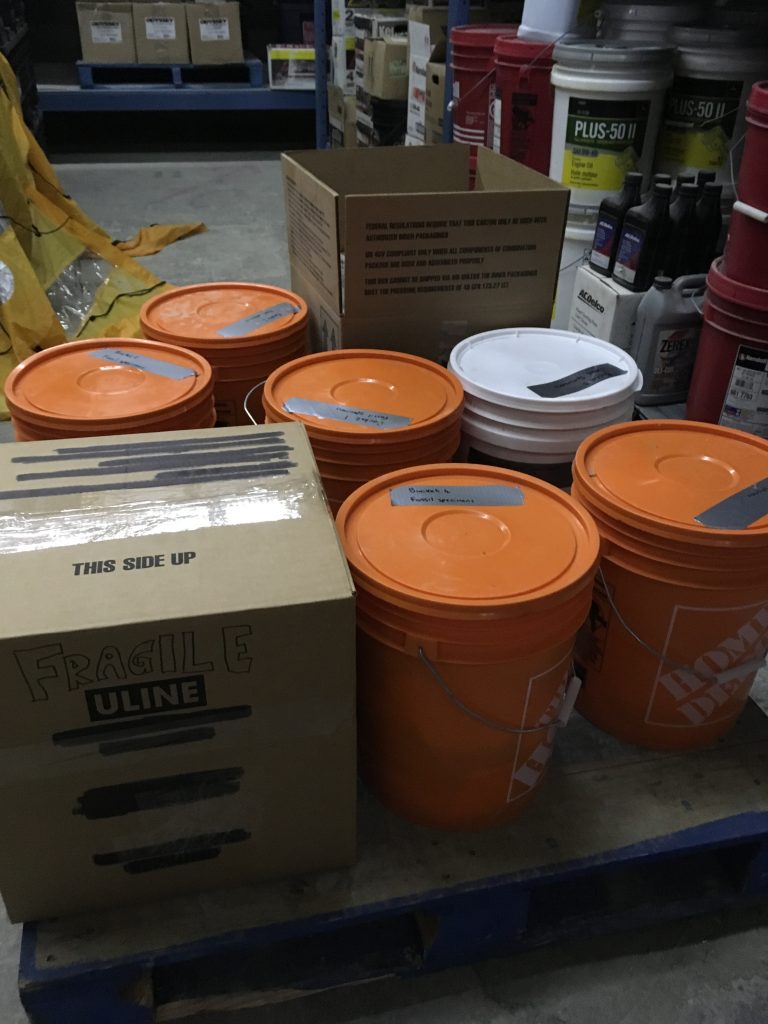
Back in Ottawa we were finally able to relax and reflect on our time in the field.
Back in the UK
On our return home we have began our work on the fossils we had collected, including the acid maceration of our rock samples for micro fossils. Details of the findings we make will be posted on here in time.
Following the expedition, we submitted another grant proposal for a return trip to the Arctic. The competition for such grants is always fierce and we were rejected at the last stage. We are continuing to look for a way back into the field.


